Introduction
In an age where operational efficiency can make or break a business, mastering the art of macro recording stands as a crucial skill for professionals seeking to streamline their workflows. This powerful feature, primarily associated with Microsoft Excel, allows users to automate repetitive tasks, transforming mundane processes into efficient systems that save time and reduce errors. As organizations increasingly rely on automation to enhance productivity, understanding the full potential of macro recording—along with its integration with advanced tools like VBA and Robotic Process Automation (RPA)—becomes essential.
By embracing these technologies, businesses not only improve accuracy and consistency but also empower their teams to focus on strategic initiatives that drive growth and innovation. This article delves into the various aspects of macro recording, offering insights into its benefits, applications, and how to navigate common challenges, ultimately guiding organizations toward a more efficient and effective operational future.
Understanding Macro Recording: A Beginner’s Guide
In today’s fast-paced business environment, operational efficiency is crucial for success. Macro capturing, a robust function in software applications such as Microsoft Excel, allows users to automate repetitive activities by documenting sequences of actions or commands. This capability is particularly advantageous for tasks such as data formatting, formula entry, or report generation. By automating these processes, automated task capture not only saves considerable time but also reduces the likelihood of human error, which is crucial for preserving both efficiency and precision in business operations.
Technological progress has significantly improved productivity tools such as automation functions. For instance, integrating VBA (Visual Basic for Applications) into Excel can further boost efficiency, reliability, and power, as noted by David E. Clough. He emphasizes that leveraging VBA in spreadsheet problem-solving can significantly streamline workflows.
Companies that embrace large-scale documentation often observe significant enhancements in operational efficiency. For example, an organization may use macro recording to automate the generation of monthly financial reports, drastically reducing the time spent on manual data entry and allowing staff to focus on analysis instead. This method reflects the creative solutions provided by EMMA RPA and Microsoft Power Automate, aimed at improving operational efficiency and employee morale by addressing obsolete systems through intelligent processes.
A significant case study on a mid-sized company showed that by implementing GUI technology, they successfully reduced data entry errors by 70%, accelerated testing processes by 50%, and improved workflow efficiency by 80%, achieving ROI within 6 months. Such measurable outcomes highlight the transformative power of automation technologies in enhancing operational efficiency across various sectors, including healthcare.
Moreover, the advantages of large-scale documentation are well-documented in various business applications. Experts highlight its ability to handle complex tasks effortlessly, thereby enhancing overall productivity. For example, utilizing automated scripts to streamline data entry for customer orders or report generation in Excel can greatly lessen the manual workload, resulting in more consistent and precise outcomes. Furthermore, organizations that utilize large-scale documentation for inventory management notice enhanced precision in stock levels and order processing, demonstrating the practical efficiency improvements.
Overall, the incorporation of automated scripting in Excel is a testament to how modern automation tools, such as EMMA RPA and Power Automate, can transform business operations, making them more efficient and effective. By embracing these advancements, businesses can ensure they remain competitive and responsive in a rapidly evolving technological landscape.
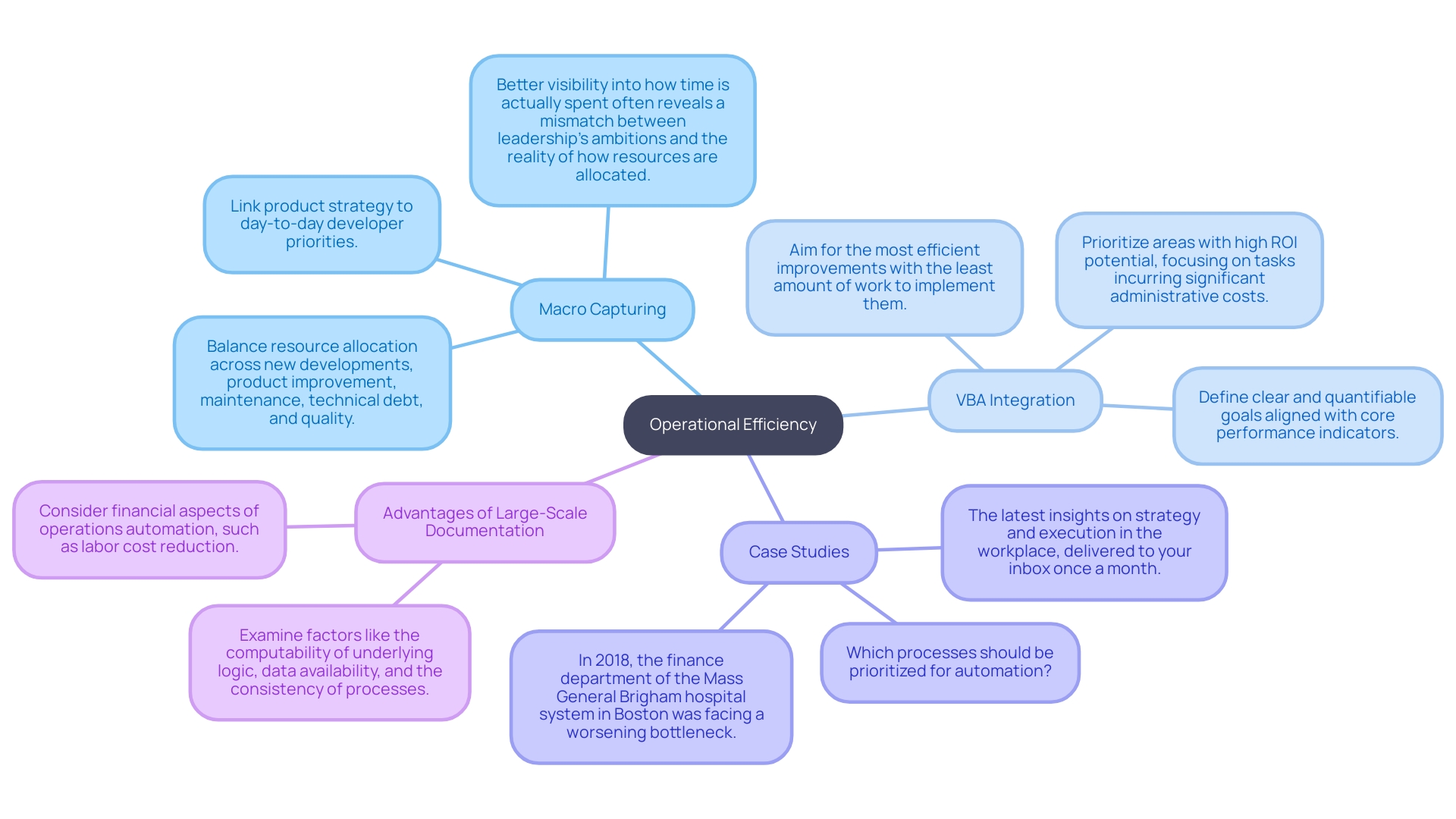
The Benefits and Applications of Macro Recording
Macro capture provides significant advantages like enhanced productivity, fewer mistakes, and better uniformity in execution. For instance, a financial analyst can employ large-scale documentation to automate the creation of monthly reports, ensuring accuracy and conserving valuable time. This automation is especially vital as 82% of organizations still depend on paper-based, manual routing of activities supported by Excel, highlighting the urgent need for process automation. By utilizing large-scale automation and integrating Robotic Process Automation (RPA), companies can significantly simplify their processes, enhance operational efficiency, and enable employees to concentrate on higher-value activities, leading to improved job satisfaction and overall effectiveness.
In the rapidly evolving AI landscape, recent studies indicate that popular AI applications—such as those used for responding to messages and crafting social media posts—demonstrate AI’s versatility in transforming everyday tasks. These innovations confirm the effectiveness of automated processes, including macro recording, in enhancing efficiency and productivity. Experts in productivity, such as Niamh Lordan, Head of Marketing, have observed the trend of companies actively comparing competing products through bake-offs, indicating a growing interest in the most effective tools for streamlining processes. Additionally, statistics indicate that 54% of respondents think AI can improve written content, reinforcing the incorporation of AI-driven processes in reporting and financial analysis.
Ultimately, macro capture and RPA empower employees by shifting their focus from repetitive tasks to more strategic initiatives, fostering a dynamic and efficient work environment. Additionally, leveraging Excel and VBA in conjunction with these automation tools can unlock the power of Business Intelligence, transforming raw data into actionable insights that enable informed decision-making, driving growth and innovation.
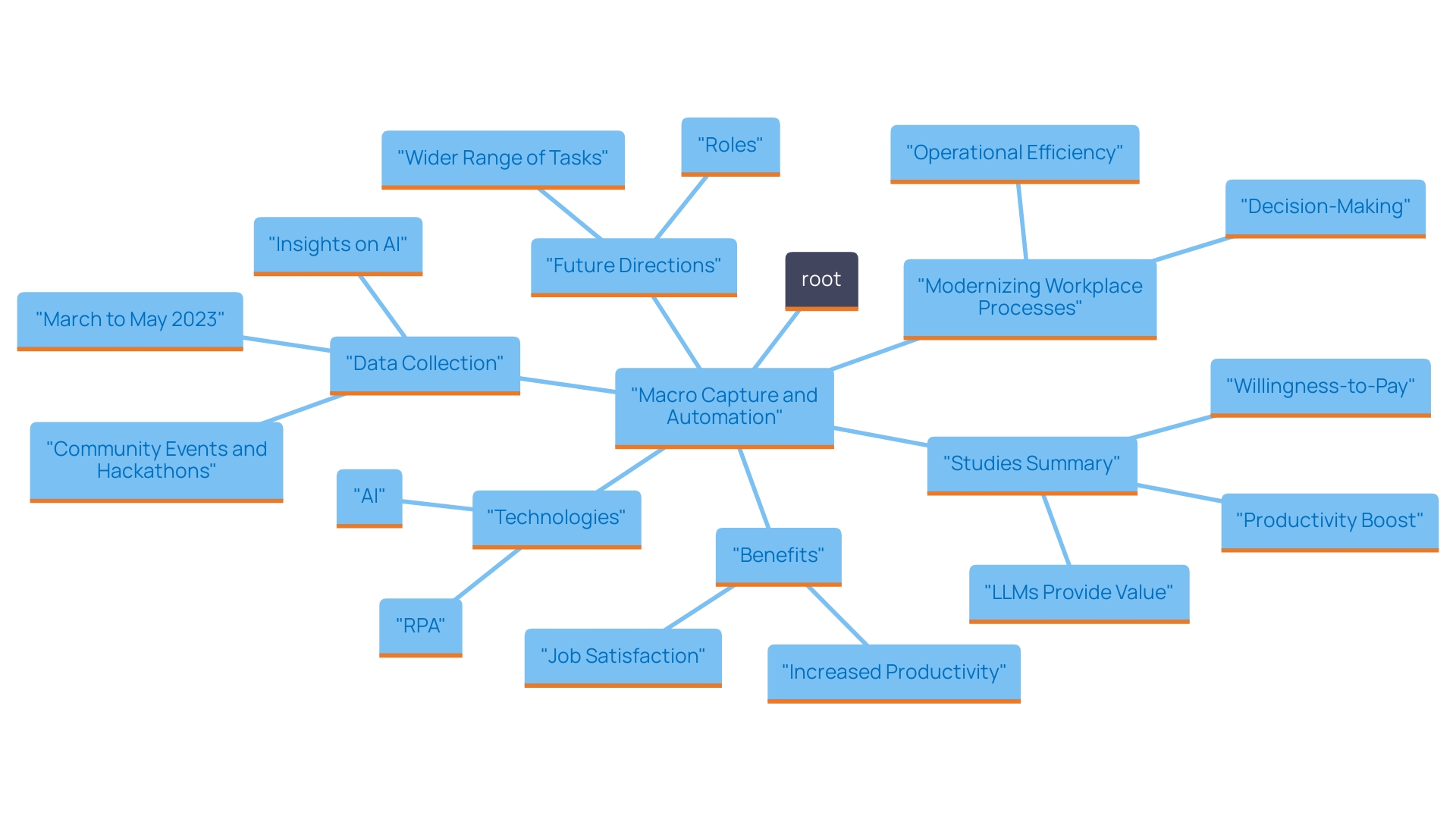
Navigating Common Challenges in Macro Recording
Macro recording can greatly enhance productivity; however, users often encounter challenges such as recording errors, unexpected results, and restrictive security settings. A recent analysis has highlighted common pitfalls, including:
- Neglecting to consider varying data ranges
- Failing to sufficiently test functions before deployment
For instance, a case study titled ‘Quoting in Macro Programming’ revealed that improper quoting in SAS procedures could lead to critical errors, highlighting the importance of understanding techniques like:
%STR%NRSTR%BQUOTE%SUPERQ
and functions like:
%QSYSFUNC%QSUBSTR
These techniques are crucial for ensuring processes execute correctly, especially when dealing with special characters and varying data formats.
In a rapidly evolving AI landscape, leveraging Robotic Process Automation (RPA) to automate these manual workflows can significantly boost efficiency and allow your team to focus on more strategic tasks. Implementing RPA can help alleviate common automation challenges by streamlining processes and reducing errors, ultimately boosting productivity.
To effectively address recording issues, it is essential to:
- Thoroughly test recorded scripts
- Utilize relative references when appropriate
- Stay informed about the latest security settings
For example, querying dictionary.macros in PROC SQL can provide insights into current variable definitions, helping to identify potential issues early on.
Security remains a paramount concern. Executing scripts from untrusted sources poses significant risks; therefore, users must regularly review and update security settings to ensure safe usage. Experts highlight the significance of vigilance and proactive troubleshooting to uphold overall integrity. By integrating customized AI solutions and utilizing Business Intelligence to extract actionable insights from broad data, directors can effectively navigate the complexities of large-scale documentation, ensuring optimal performance and security while driving data-driven decision-making for business growth.
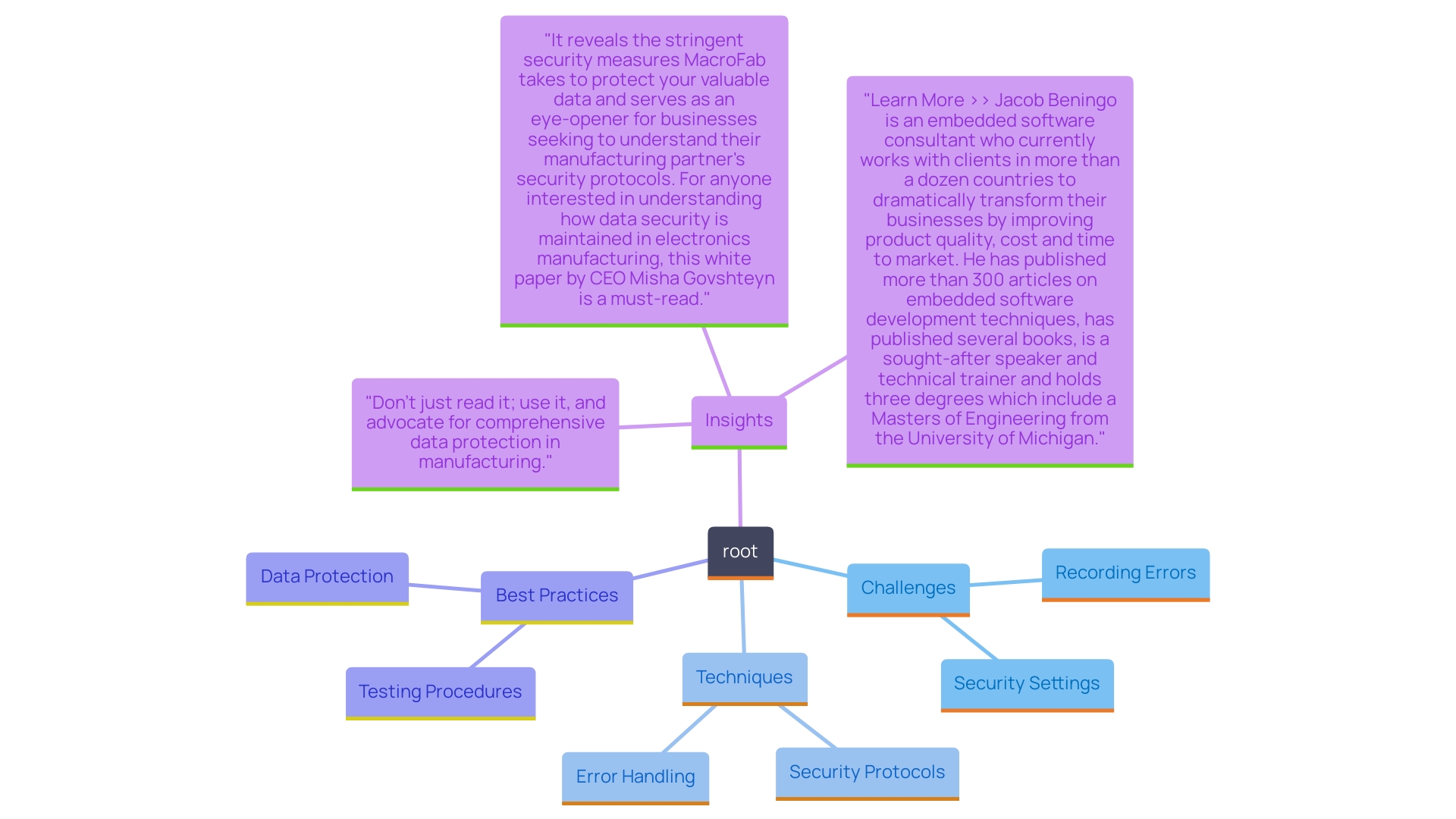
Expanding Macro Recording Beyond Excel: Multi-Platform Use
Excel’s prominence in script recording is well-established, but a variety of other applications also provide strong process capabilities that can significantly enhance operational efficiency. For instance, Google Sheets enables users to record macros that automate repetitive activities such as data entry and formatting. Recent studies suggest that organizations employing mechanization tools can decrease job completion time by up to 50%, highlighting the effectiveness of automated data management in improving productivity.
Furthermore, web automation utilities such as UiPath and Automate.io enhance these capabilities for online activities, delivering a smooth experience across various platforms. Leveraging Robotic Process Automation (RPA) empowers teams to customize strategies to their unique workflow requirements, ultimately enhancing efficiency and productivity. RPA can streamline manual workflows, reduce errors, and free up team members for more strategic, value-adding work.
SigmaPlot‘s support for importing data from various sources, including Excel, SPSS, and Minitab, exemplifies the adaptability of modern data management tools. This capability enables users to work with various datasets, expanding the scope of their research and operational activities.
As an expert in systems observed, ‘This process boosts efficiency by enabling teams to concentrate on strategic activities.’ This emphasizes the transformative potential of integrating large-scale capturing and automated tools into daily operations. By automating regular activities, organizations can not only enhance efficiency but also promote informed decision-making through Business Intelligence, ultimately resulting in measurable business growth and innovation.
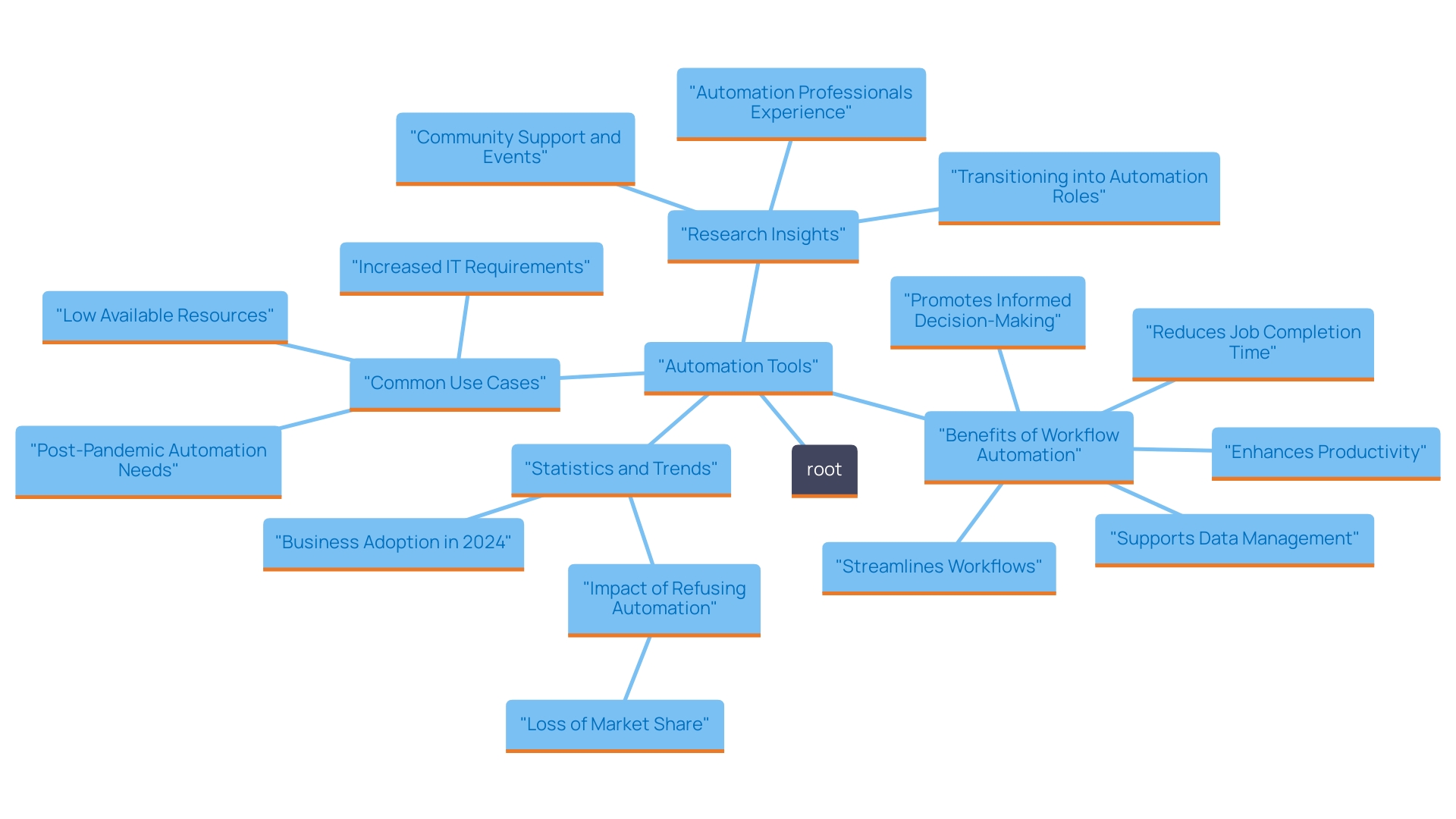
From Macro Recording to VBA: Advancing Your Automation Skills
Shifting from automated processes to Visual Basic for Applications (VBA) unveils a world of opportunities for developing advanced solutions. While macro recording is ideal for simple operations, VBA empowers users to write custom code, enabling them to tackle complex scenarios that recorded macros cannot handle. This flexibility enables the mechanization of intricate workflows, development of user-defined functions, and creation of interactive forms and dashboards.
By integrating VBA with Robotic Process Automation (RPA), directors can significantly enhance operational efficiency. RPA streamlines repetitive processes, while VBA can automate complex tasks that require precise control. For instance, by using VBA to refine data inputs or create customized reporting tools, teams can focus on more strategic, value-adding work, ultimately boosting productivity.
Moreover, aligning VBA procedures with tailored AI solutions and Business Intelligence enables directors to transform raw data into actionable insights, supporting informed decision-making that drives growth and innovation. Reviewing and altering VBA code in the Visual Basic for Applications Editor (VBE) guarantees the precision and effectiveness of recorded macros, resulting in more dependable processes.
According to Professor Lonnie Shea from the University of Michigan, advancing technologies and solutions through such practices is critical in today’s fast-paced environment, as they enable organizations to remain competitive and responsive to market demands. Additionally, implementing VBA solutions aligns with broader sustainability initiatives, supporting the UN’s 17 sustainable development goals (SDGs) while promoting operational efficiency.
Utilizing the latest trends in VBA for streamlining in 2024, users can stay ahead by exploring online courses and tutorials that offer comprehensive learning resources. For example, advanced automation techniques such as automating data analysis reports or creating dynamic dashboards can significantly enhance productivity. Mastering VBA not only enhances one’s ability to automate complex tasks but also offers the advantage of creating dynamic and interactive tools, significantly boosting productivity and effectiveness in operational roles.
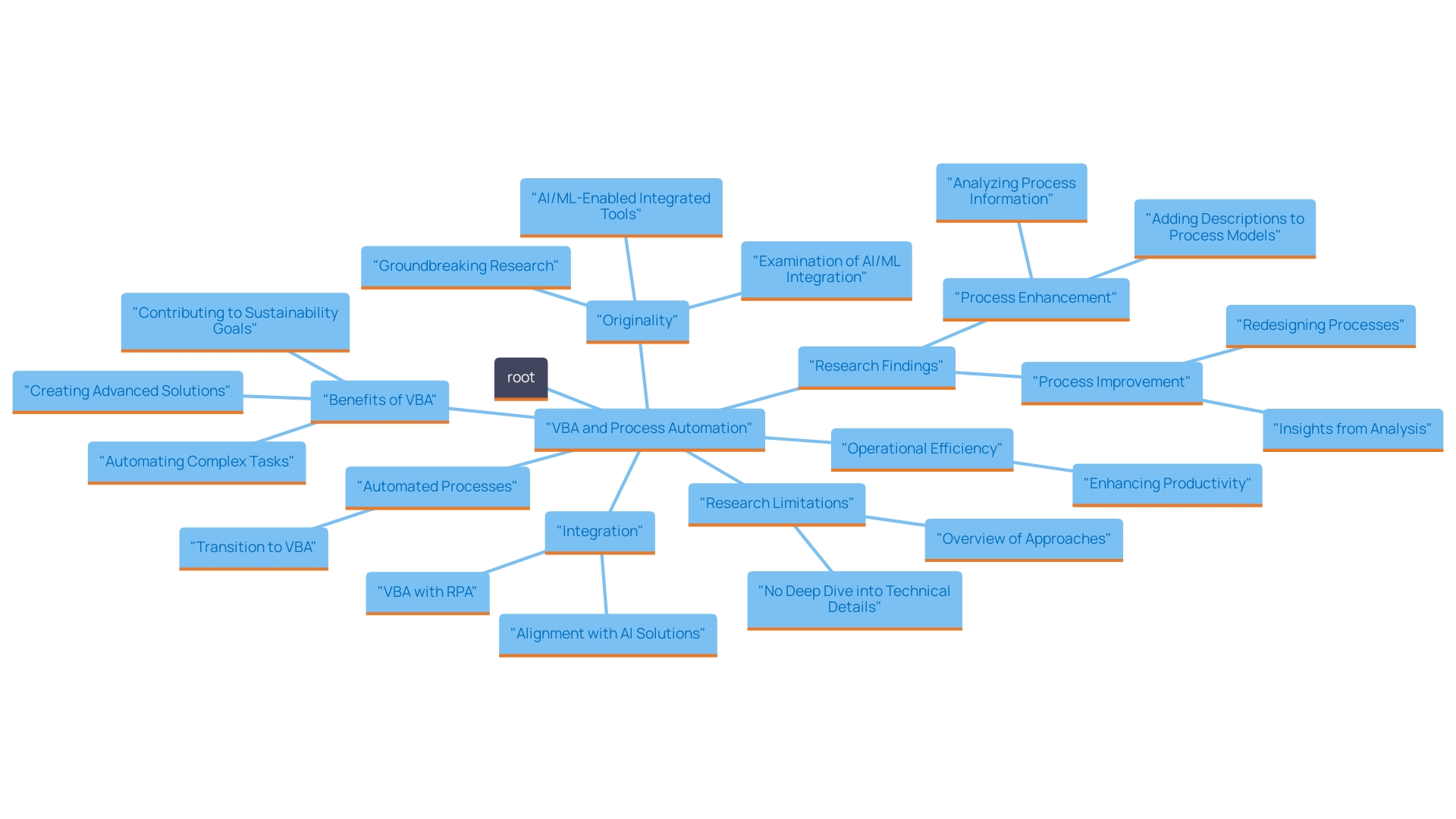
Conclusion
Understanding the intricacies of macro recording is essential for professionals aiming to enhance operational efficiency. By automating repetitive tasks, macro recording not only saves valuable time but also reduces the likelihood of human error, ensuring that organizations can maintain high standards of accuracy in their operations. The integration of tools like VBA and Robotic Process Automation (RPA) further amplifies the benefits, enabling businesses to streamline workflows and empower their teams to focus on strategic initiatives.
The journey towards operational excellence through macro recording is not without its challenges. Users must navigate common pitfalls, such as recording errors and security concerns, but by employing best practices and leveraging automation technologies, they can overcome these obstacles. The success stories of organizations that have adopted these tools underscore their transformative potential, showcasing measurable improvements in efficiency and productivity.
As businesses continue to evolve in a technology-driven landscape, the ability to harness macro recording and its related tools becomes increasingly crucial. The move towards automation is not just about efficiency; it’s about fostering a culture of innovation and agility. Embracing these advancements positions organizations to thrive in a competitive environment while driving growth and informed decision-making.
The future of operational efficiency lies in mastering these automation techniques, and the time to act is now.
Introduction
In an age where efficiency is paramount, organizations are increasingly turning to automation within the Microsoft 365 ecosystem to transform their operations. By harnessing powerful tools such as Power Automate and Robotic Process Automation (RPA), businesses can eliminate repetitive tasks, minimize errors, and empower their teams to focus on strategic initiatives. This article delves into the various facets of automation in Microsoft 365, exploring key tools, integration strategies, and metrics for measuring success.
As organizations strive to adapt to the fast-paced demands of the modern business landscape, understanding and implementing these automation solutions becomes essential for driving productivity and fostering growth.
Understanding Automation in Microsoft 365
Automation within the 365 ecosystem entails using various tools and technologies to simplify repetitive tasks, improve workflow performance, and increase overall productivity. By leveraging Robotic Process Automation (RPA) solutions like EMMA RPA and Microsoft Power Automate, organizations can significantly reduce manual intervention and minimize errors, allowing teams to focus on more strategic initiatives. This approach is crucial in today’s fast-paced business environment, where efficiency and responsiveness are essential for success.
RPA solutions not only alleviate task repetition fatigue but also empower employees, leading to improved morale and productivity. By comprehending mechanization in this context, organizations can effectively harness these capabilities to achieve substantial operational improvements, drive data-driven insights, and foster growth through innovative technologies.
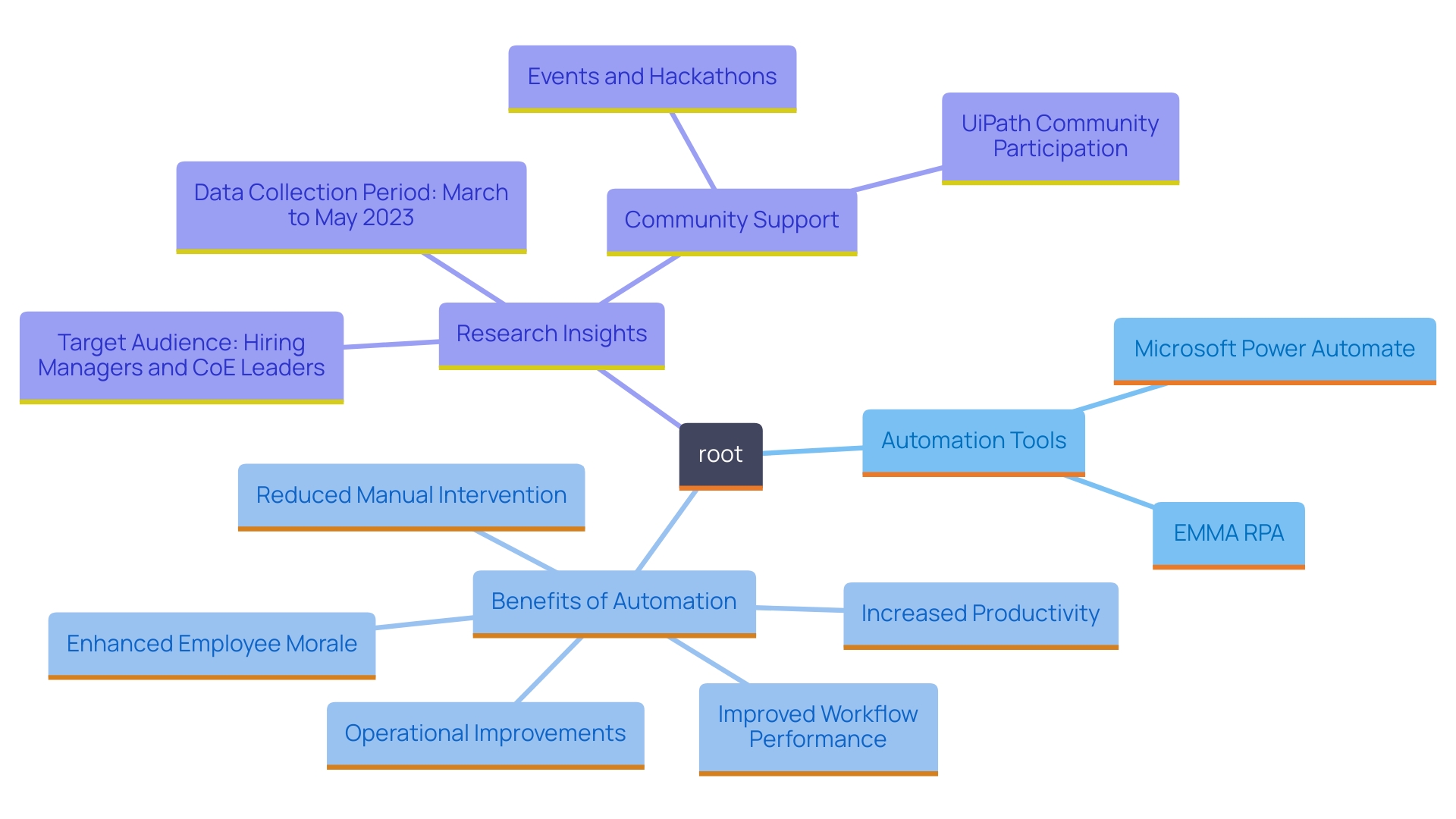
Key Tools and Features for Automation in Microsoft 365
The 365 suite offers various essential tools and features that promote efficiency, each aimed at improving productivity and simplifying operations. Among these, Power Automate stands out as a powerful tool that enables users to create automated workflows between applications and services. This tool enables the streamlining of activities like data entry, notifications, and file synchronization across platforms, effectively addressing repetitive duties that can hinder productivity.
Moreover, Microsoft Teams facilitates streamlined processes through integrations with bots and connectors, allowing activities such as scheduling meetings, sending reminders, and managing team communications without manual input. Excel also includes features for streamlining processes through macros and formulas, which can significantly lessen the time spent on repetitive data handling activities, such as creating reports or modifying data sets.
By effectively utilizing these tools, including innovative RPA solutions like EMMA RPA, which can automate complex workflows and enhance operational efficiency, organizations can optimize their processes, reduce errors, and free up valuable time for their teams to focus on more strategic activities.
Furthermore, with a risk-free ROI assessment available for Power Automate, businesses can confidently implement these solutions. This procedure entails evaluating a particular assignment for mechanization, calculating the effort needed, estimating possible time savings, and ensuring that a certified expert manages the mechanization, enabling businesses to only pay if the process is successfully mechanized as intended.
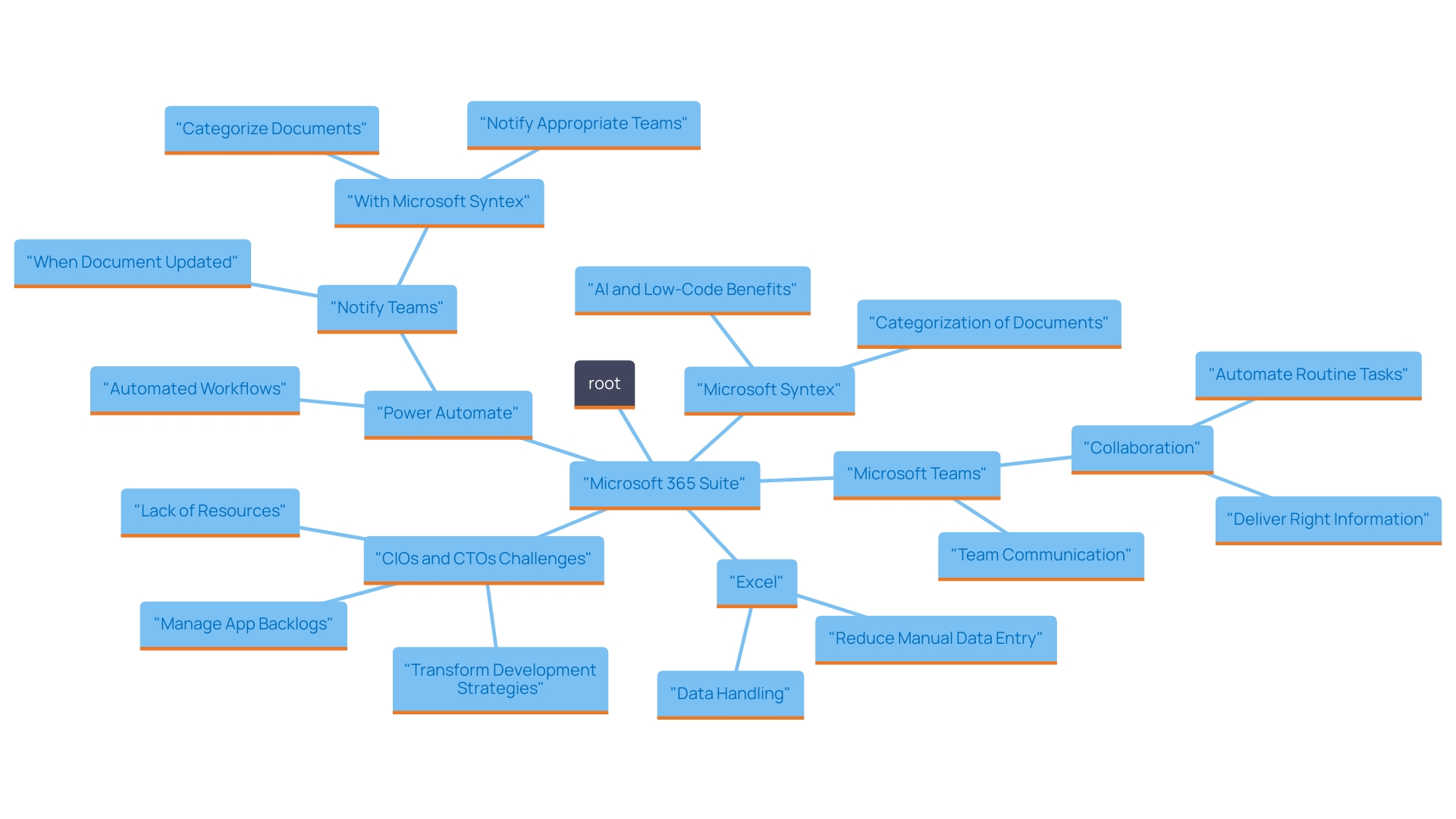
Integrating Automation with Business Processes
To enhance the advantages of mechanization within Office 365, organizations must strategically incorporate these tools into their current business processes. This entails recognizing crucial sectors where mechanization can lessen manual duties and improve productivity, akin to how a mid-sized healthcare firm accomplished a 70% decrease in mistakes and an 80% enhancement in workflow performance by mechanizing data entry and software evaluation.
For example, automating approval workflows in document management can significantly expedite processes and improve compliance. Additionally, leveraging analytics and reporting features within Microsoft 365 allows organizations to monitor the impact of automation on operational performance.
By consistently assessing and enhancing automated processes, companies can guarantee alignment with their overarching objectives and adjust to evolving requirements, ultimately promoting sustained enhancements. Furthermore, utilizing Robotic Process Automation (RPA) alongside tailored AI solutions can enhance operational efficiency, enabling organizations to navigate the complexities of the evolving AI landscape while making informed, data-driven decisions.
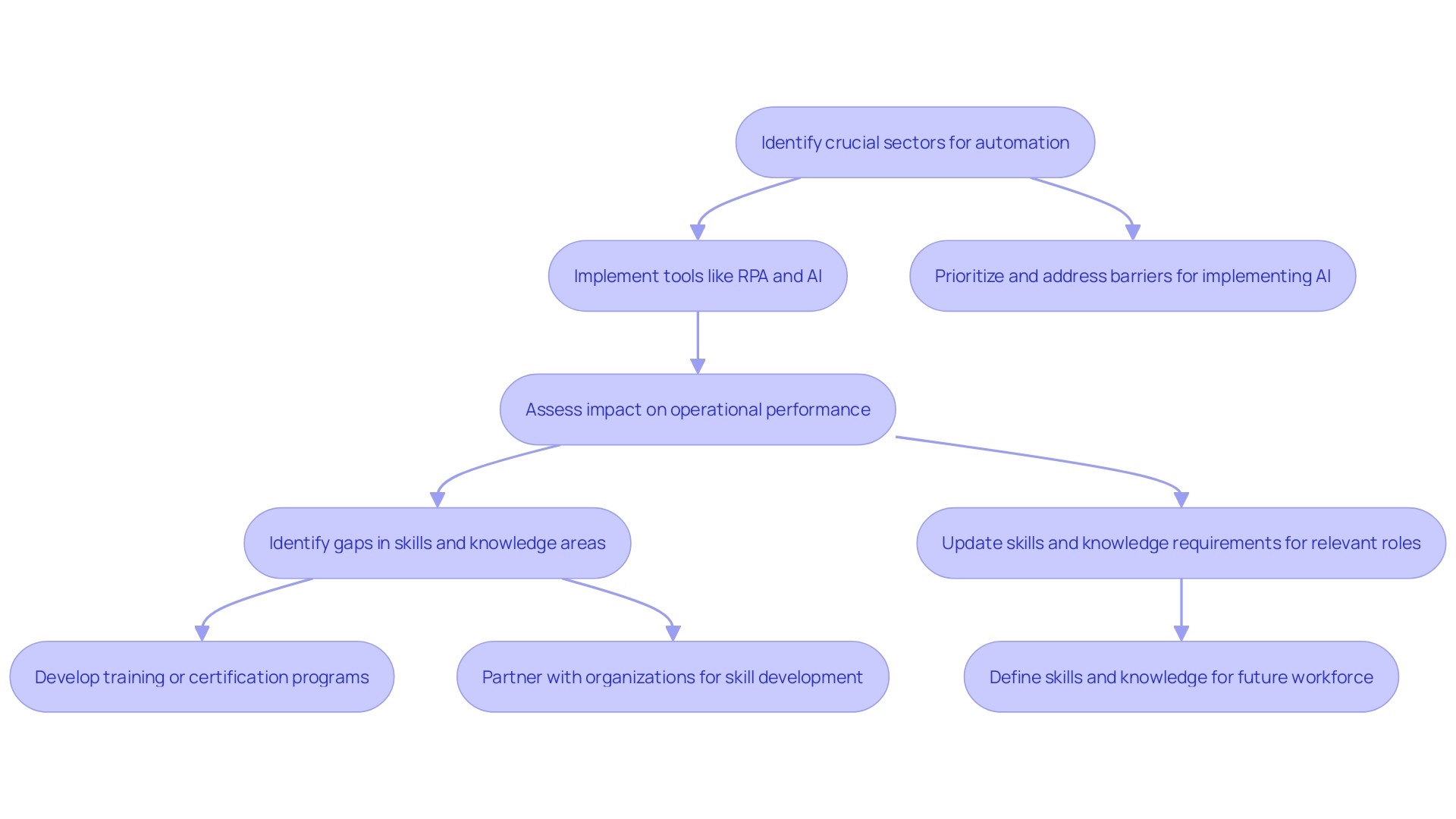
Measuring the Impact of Automation
To effectively assess the influence of automated processes in 365, organizations should establish key performance indicators (KPIs) that align with their specific business goals. These KPIs might include metrics such as:
- Time savings
- Error reduction rates
- Employee satisfaction levels
For instance, a company that implemented Robotic Process Automation (RPA) to handle repetitive data entry tasks reported a 30% reduction in processing time and a notable increase in employee morale.
Utilizing Microsoft tools like Power BI can aid in visualizing data and providing insights into performance, as well as unlocking the potential of Business Intelligence to transform raw data into actionable insights. By regularly reviewing these metrics, businesses can identify successes, areas for improvement, and opportunities for further enhancement through tailored AI solutions.
This data-driven approach not only validates the effectiveness of automation initiatives but also fosters a culture of continuous improvement, enabling organizations to adapt and thrive in a rapidly evolving business landscape, ultimately enhancing productivity and operational efficiency.

Conclusion
Embracing automation within the Microsoft 365 ecosystem is a transformative step for organizations aiming to enhance efficiency and drive growth. By utilizing powerful tools such as Power Automate and Robotic Process Automation (RPA), businesses can streamline repetitive tasks, minimize errors, and empower their teams to concentrate on strategic initiatives. The integration of these technologies into daily operations not only alleviates the burden of mundane tasks but also fosters a more engaged and productive workforce.
The key to successful automation lies in strategically integrating these tools into existing business processes. Identifying areas ripe for automation can lead to significant improvements in workflow efficiency and accuracy, as demonstrated by organizations that have achieved substantial operational gains. Furthermore, by establishing clear metrics to measure the impact of automation, businesses can continuously refine their strategies and ensure alignment with their goals.
As organizations navigate the complexities of the modern business landscape, the importance of automation cannot be overstated. It serves as a catalyst for productivity, innovation, and sustained growth. By committing to these transformative solutions, organizations position themselves not just to adapt but to thrive in an increasingly competitive environment.
Now is the time to harness the power of automation and unlock new levels of operational excellence.
Introduction
In a world where efficiency is paramount, process automation emerges as a powerful ally for organizations striving to enhance their operational capabilities. By harnessing advanced technologies like robotic process automation, artificial intelligence, and machine learning, businesses can not only streamline repetitive tasks but also unlock new levels of productivity. This article delves into the essentials of process automation, offering a comprehensive guide to implementing automation solutions that address common operational challenges.
From identifying the right processes to automate, to measuring the impact of these initiatives, readers will discover practical steps and strategies that pave the way for a more agile and efficient organization. Embracing automation is not just about technology; it’s about transforming the workplace into a hub of innovation and growth.
Understanding Process Automation: An Overview
In today’s swiftly changing commercial environment, the incorporation of mechanization is no longer a luxury; it’s a necessity. The implementation of technology pertains to the execution of repetitive tasks or operations in a company where human effort can be substituted. This includes a variety of technologies, such as:
- Robotic process management (RPA)
- Artificial intelligence
- Machine learning
These technologies help streamline workflows and enhance efficiency. Tools like EMMA RPA and Microsoft Power Automate are designed to transform operations by addressing common challenges such as poor master data quality and perceived complexities in AI implementation.
- EMMA RPA transforms automation by allowing organizations to automate repetitive activities with ease.
- Power Automate facilitates the development of dynamic workflows that effortlessly link various applications and services.
These solutions not only reduce costs and eliminate errors but also improve employee morale by freeing up valuable resources, allowing employees to focus on higher-value tasks. Additionally, our custom Small Language Models (SLMs) provide efficient data analysis and enhanced privacy, making them a cost-effective option for organizations looking to modernize.
By grasping these concepts, organizations can identify how mechanization can significantly enhance productivity and foster operational excellence, ultimately resulting in a more innovative and agile business environment.
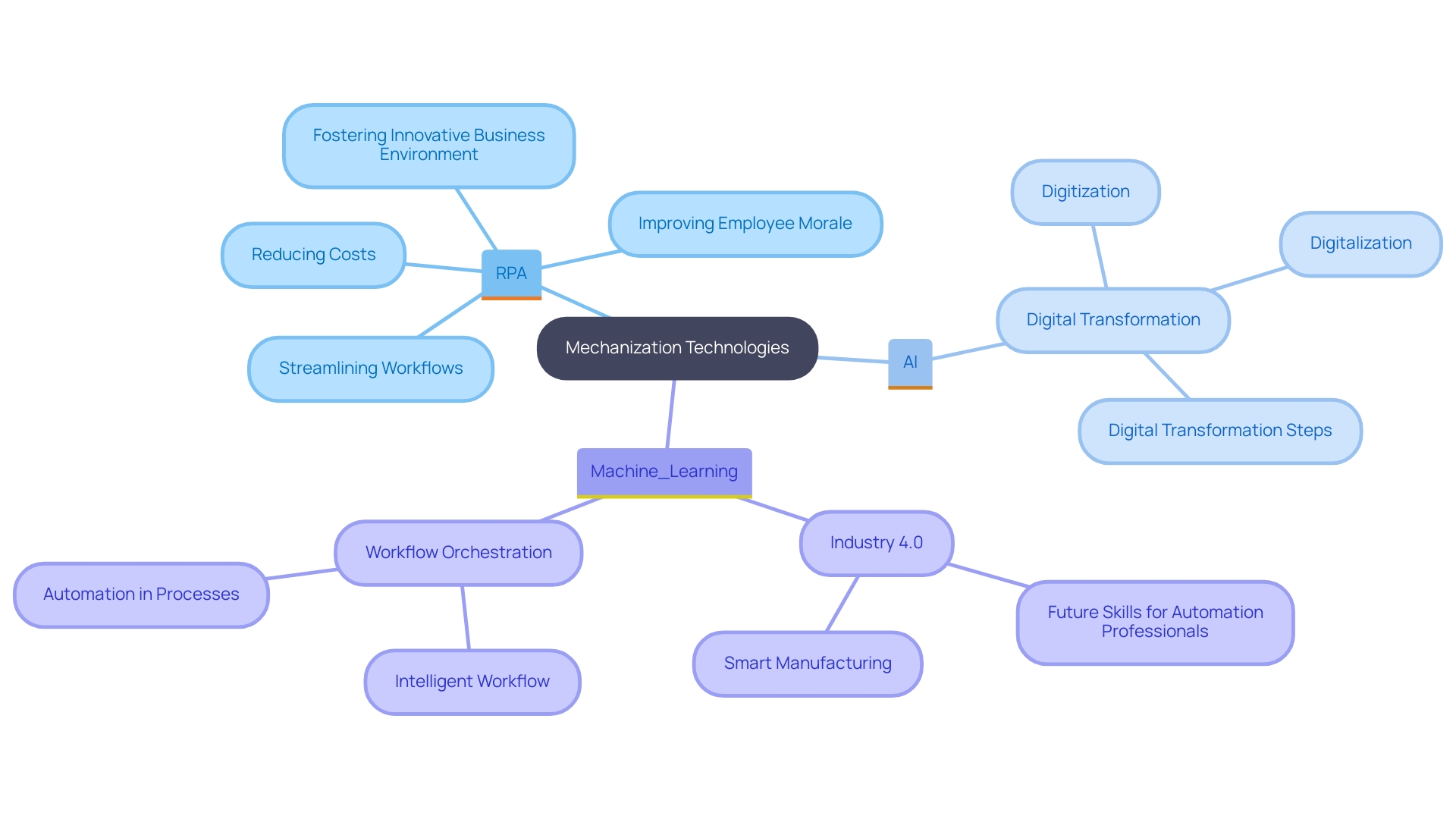
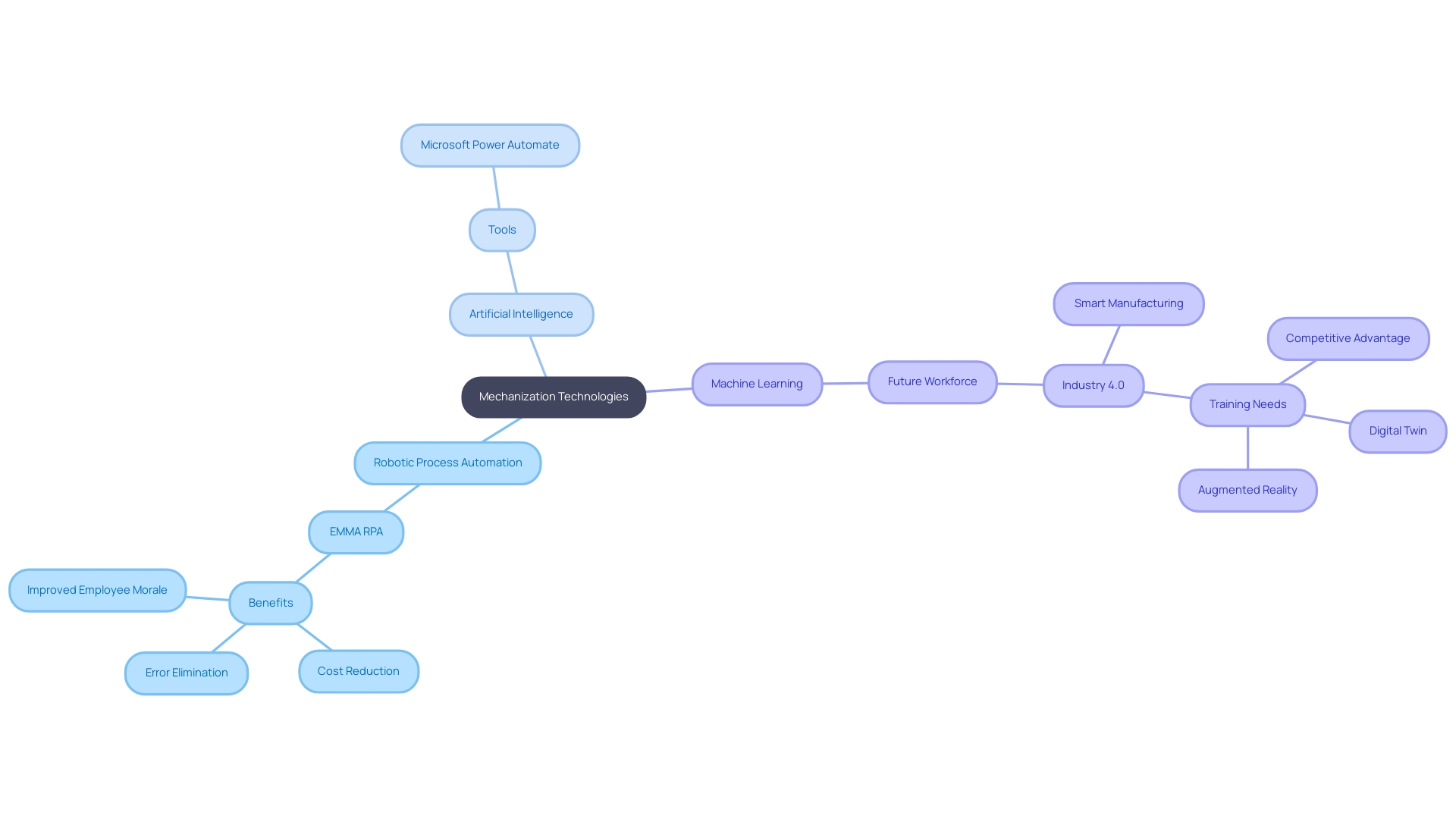
Step-by-Step Guide to Automating Your First Process
-
Identify the Process: Begin by selecting a repetitive task that consumes considerable time and resources, such as data entry, invoice processing, or report generation. These typical candidates for mechanization are crucial in addressing workplace challenges and enhancing productivity. For example, a company that automated its invoice processing saw a 30% reduction in processing time.
-
Map the Current Workflow: Document the existing workflow using flowcharts or diagrams. This visual representation helps identify inefficiencies and areas for improvement, especially in environments hindered by outdated systems. Consider using tools like Lucidchart or Microsoft Visio for this task.
-
Choose the Right Tool for Automation: Research and select a tool that meets your needs. Popular options include UiPath, Automation Anywhere, and Microsoft Power Automate, designed for various levels of complexity and integration to combat staffing shortages and streamline operations. Each tool offers unique features, so assess them based on your specific requirements.
-
Design the Automated Process: Specify how the system will operate, including establishing triggers and actions while ensuring that it can manage exceptions. This step is essential for maximizing operational efficiency in a rapidly evolving AI landscape. For instance, if automating data entry, ensure the system can manage different data formats.
-
Test the Automation: Before full implementation, conduct thorough testing to catch any errors or unexpected behaviors. This step is vital to ensure that the system operates as intended and can effectively reduce manual workload. Use a controlled environment to simulate real-world scenarios.
-
Implement and Monitor: Once testing is successful, implement the automation across the organization. Continuously monitor the process to ensure it functions correctly and provides the expected benefits, enhancing overall productivity. Establish key performance indicators (KPIs) to measure success.
-
Gather Feedback and Iterate: After implementation, collect feedback from users and stakeholders. Use this information to refine and enhance the system, ensuring it aligns with business goals and maximizes efficiency while leveraging business intelligence for informed decision-making. Regular feedback loops can help identify areas for further improvement.
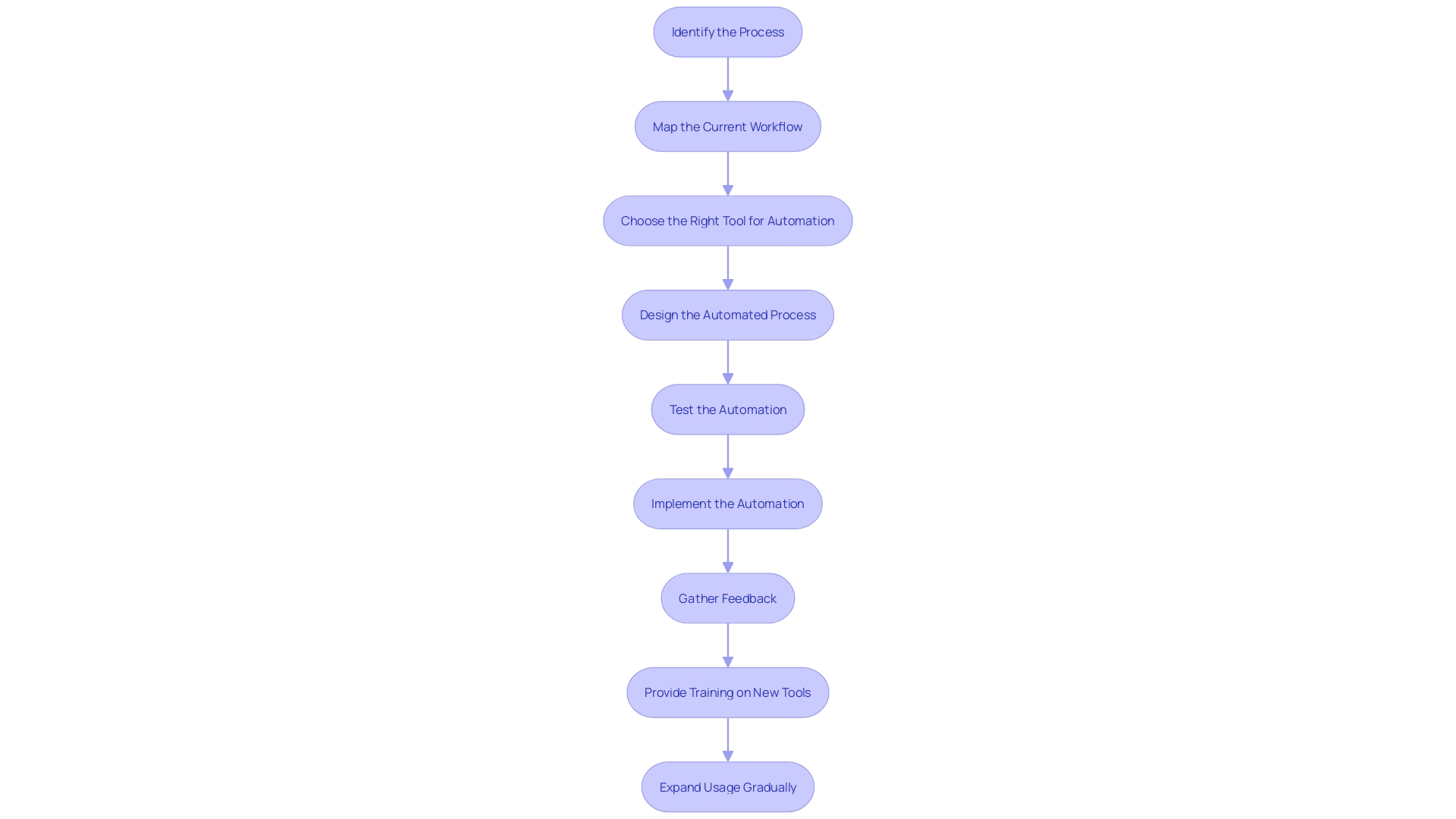
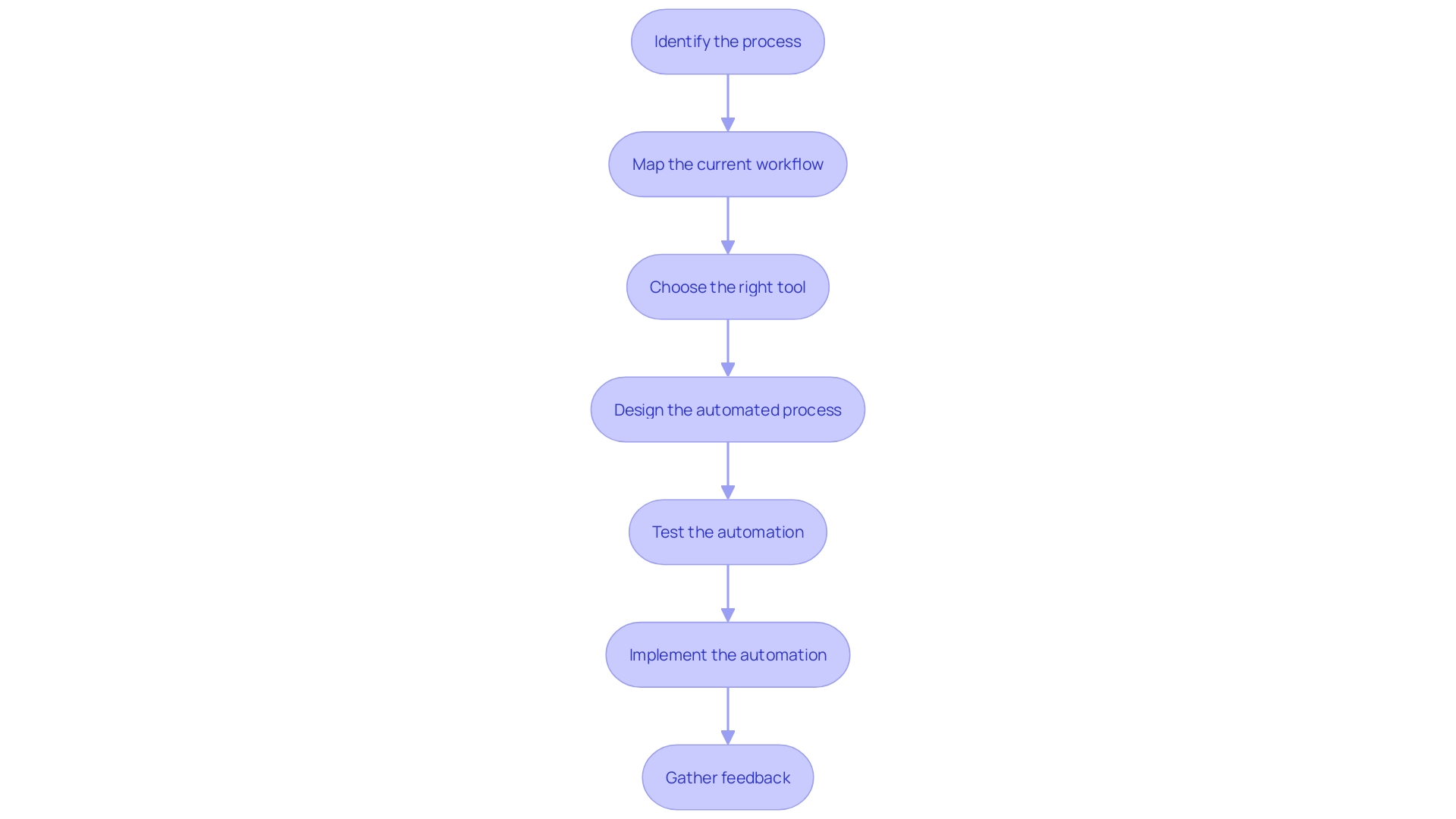
Measuring the Impact of Automation
To effectively measure the impact of automation on operational efficiency through GUI automation and RPA, it is essential to focus on key performance indicators (KPIs) that provide actionable insights:
- Time Savings: Assess the time required to complete tasks manually compared to the automated process. For instance, a mid-sized healthcare firm encountered a 50% increase in software testing procedures because of mechanization.
- Error Rates: Monitor the number of errors before and after implementing the automated process to gauge improvements in accuracy. One company reported a 70% decrease in data entry mistakes after introducing GUI technology.
- Cost Reductions: Evaluate changes in operational costs, including labor and overhead expenses, which can significantly impact healthcare service delivery.
- Employee Satisfaction: Gather input from employees about their experiences with technology and its impact on their workload. Many employees observed enhanced morale and decreased fatigue following the mechanization of repetitive tasks.
By systematically measuring these metrics, organizations can evaluate the effectiveness of their initiatives, identify opportunities for further enhancement, and drive data-driven insights that support informed decision-making and foster operational growth. Ongoing enhancement in mechanization efforts is essential for maintaining these advantages and adjusting to changing business requirements.

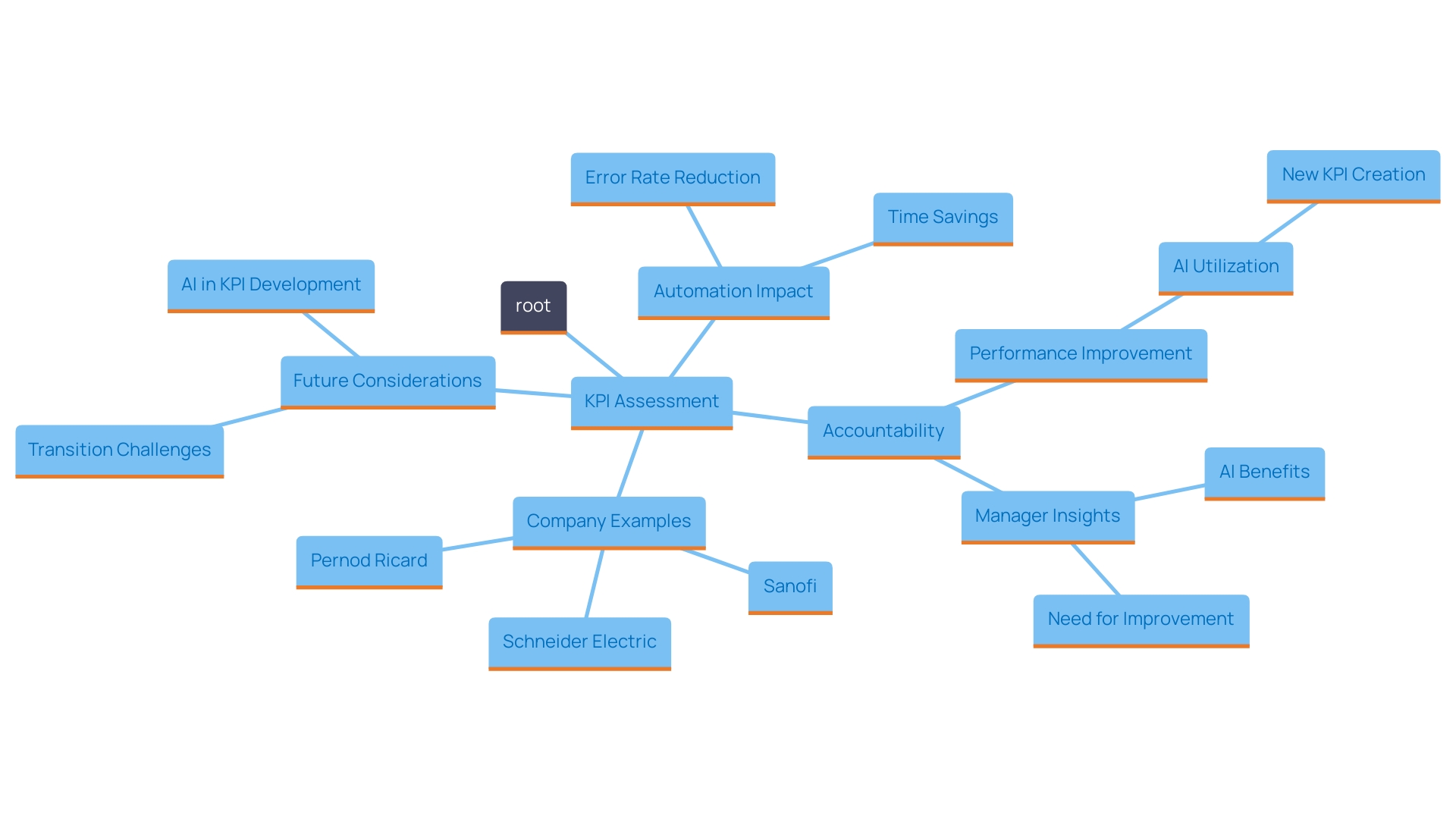
Overcoming Challenges in Process Automation
Implementing process automation can come with challenges, such as:
- Employee Resistance: Involve employees in the planning process for technology introduction and provide training on new tools to foster acceptance.
- Integration Issues: Ensure that selected tools can integrate seamlessly with existing systems by conducting thorough compatibility checks before deployment.
- Lack of Clear Objectives: Define clear goals and expected outcomes for the project to keep efforts focused and aligned with organizational objectives.
Moreover, organizations can leverage Robotic Process Automation (RPA) to streamline workflows and enhance operational efficiency. By understanding the rapidly evolving AI landscape and tailoring AI solutions, businesses can better navigate integration issues and employee concerns. By anticipating these challenges and developing targeted strategies to address them, such as involving professionals to manage the automation process and ensuring ROI through effective implementation, organizations can successfully navigate the complexities of automation implementation.
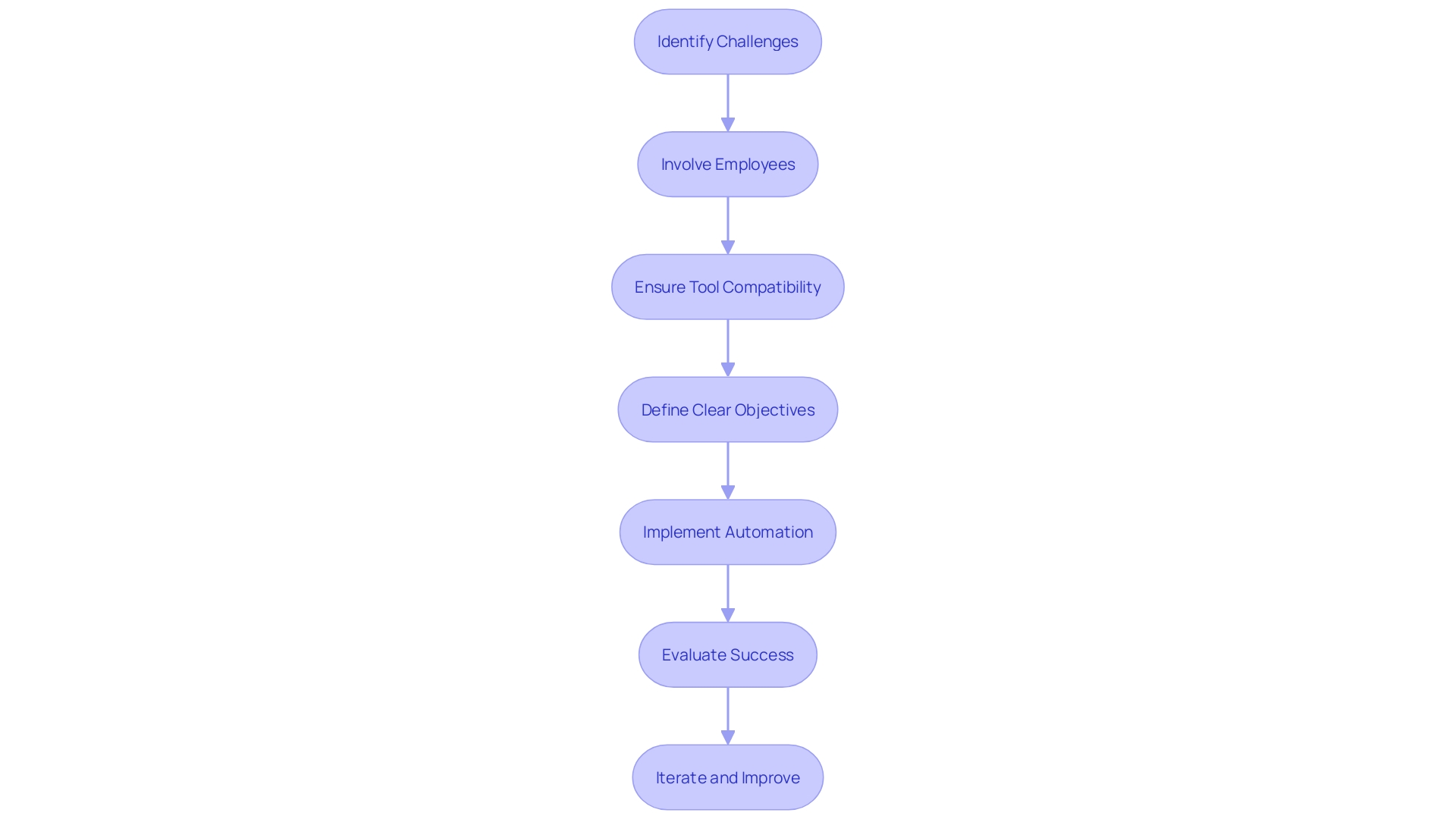
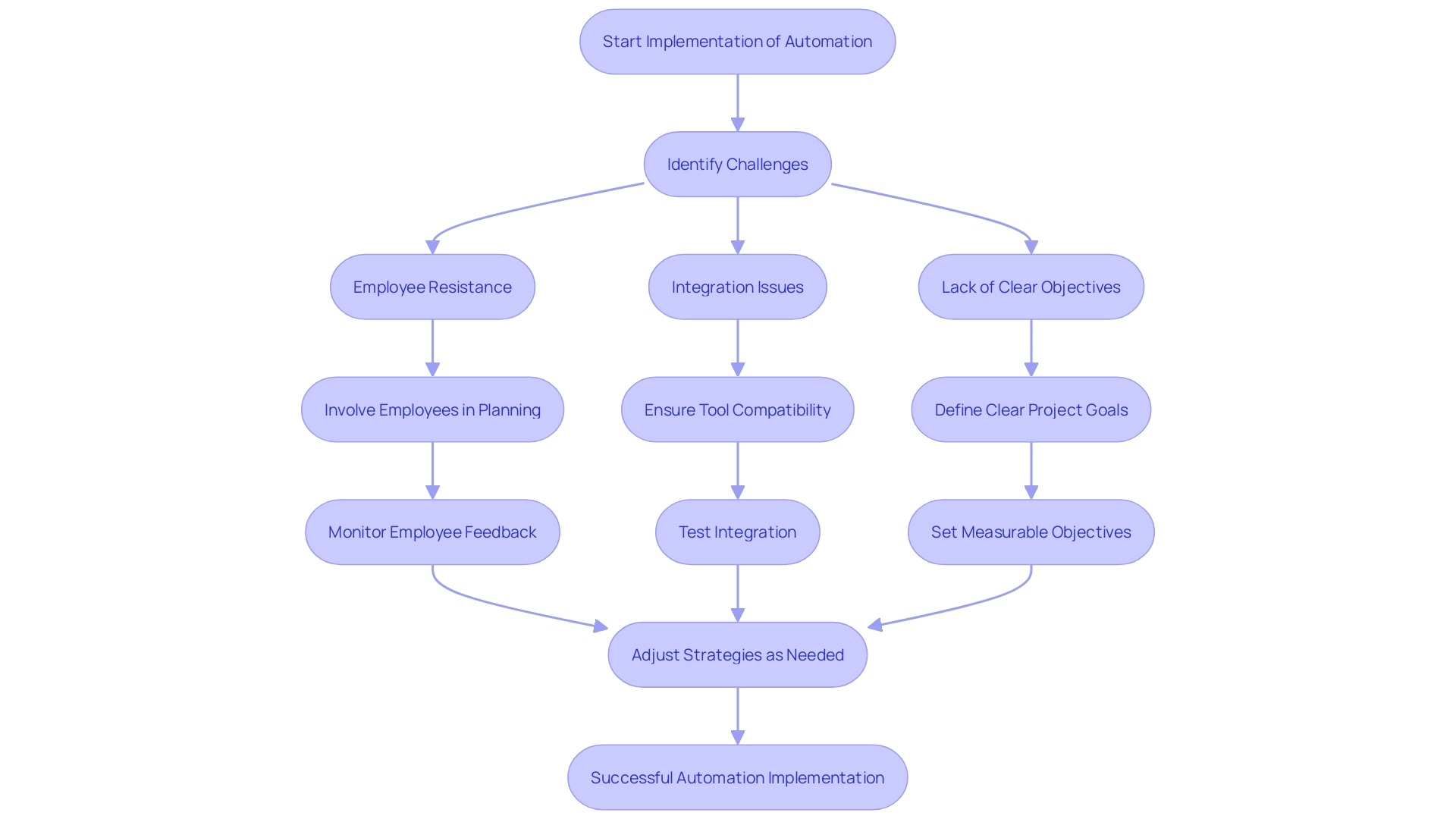
Conclusion
Embracing process automation is a transformative step towards operational excellence. By leveraging advanced technologies such as robotic process automation, artificial intelligence, and machine learning, organizations can effectively streamline repetitive tasks and significantly enhance productivity. From identifying the right processes to automate, mapping current workflows, and selecting suitable tools, the journey to automation is both structured and strategic.
The implementation of automation not only leads to improved efficiency but also fosters a culture of innovation within the workplace. By measuring the impact through key performance indicators, organizations can gain valuable insights into time savings, error reduction, and employee satisfaction. This data-driven approach not only highlights the benefits of automation but also identifies areas for continuous improvement.
Overcoming challenges such as employee resistance and integration issues is crucial for successful automation. By involving employees in the process and establishing clear objectives, organizations can ensure a smoother transition and achieve greater acceptance of new technologies. As businesses navigate the complexities of automation, the potential for growth and enhanced operational capabilities is immense.
The time to invest in automation is now, unlocking new possibilities for a more agile and efficient organization.
Introduction
In the dynamic landscape of business operations, organizations are increasingly turning to Robotic Process Automation (RPA) as a powerful solution to enhance efficiency and reduce operational burdens. With tools like Blue Prism leading the charge, companies can automate repetitive tasks, freeing up valuable human resources for more strategic initiatives. This article delves into the essentials of RPA, exploring foundational concepts, advanced techniques, and the creation of a robust automation strategy.
By understanding how to effectively implement and measure the success of RPA, businesses can unlock significant time and cost savings, while also fostering a more engaged workforce. Join the journey toward operational excellence and discover how RPA can transform the way organizations operate.
Understanding RPA and Blue Prism: A Beginner’s Guide
Robotic Process Automation (RPA) is a technology that utilizes software robots to automate repetitive, rule-based tasks typically performed by humans. Tools like EMMA RPA and Microsoft Power Automate are at the forefront of this innovation, known for their user-friendly interfaces and transformative capabilities. Here’s a brief overview of key concepts:
-
RPA Basics: RPA empowers organizations to automate mundane tasks, significantly reducing human error and enhancing efficiency. It is particularly effective for time-consuming processes such as data entry, invoice processing, and customer support inquiries.
-
Introduction to Leading RPA Tools: EMMA RPA transforms business processes by addressing task repetition fatigue and staffing shortages. In contrast, Microsoft Power Automate allows users to create dynamic automated workflows that seamlessly connect applications and services.
- Key Features of EMMA RPA: A groundbreaking tool for operational efficiency, enhancing productivity through user-friendly digitalization.
-
Key Features of Power Automate: Streamlines workflows, connects apps and data with AI-powered capabilities, and provides accessible solutions for managing processes.
-
Benefits of Using RPA: Implementing RPA leads to significant cost savings, improved accuracy, and enhanced employee morale, as teams are liberated from mundane tasks to focus on strategic initiatives. For instance, companies that have adopted EMMA RPA have reported a 30% reduction in processing times for routine tasks. Leveraging tailored AI solutions alongside RPA further boosts productivity and facilitates informed decision-making, ultimately fueling business growth.
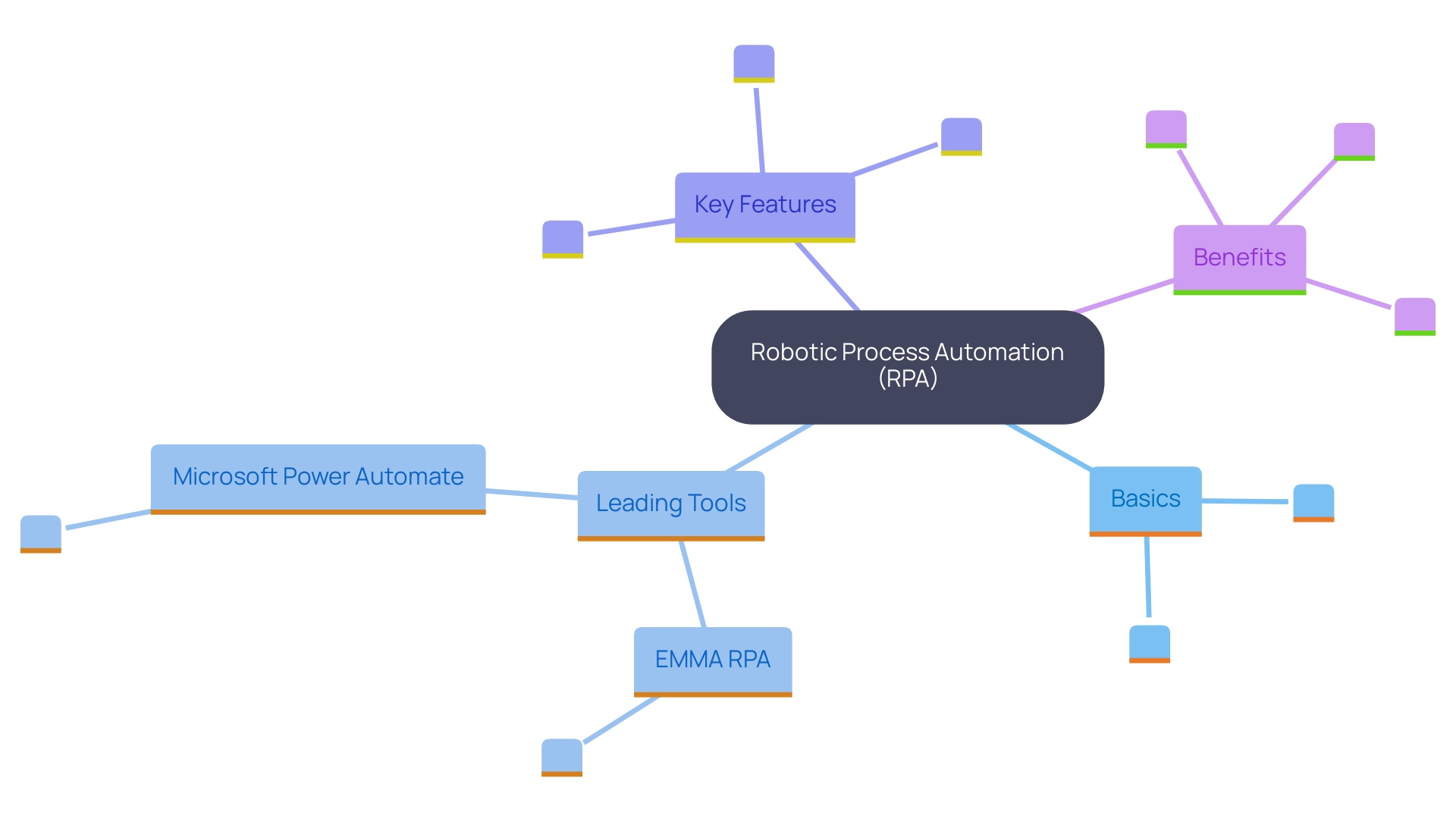
Mastering Advanced Automation Techniques with Blue Prism
In today’s fast-paced business environment, mastering advanced technological techniques is crucial for overcoming operational challenges and enhancing productivity. Once you have a solid grasp of the basics, you can explore advanced techniques in Blue Prism. Here are some key strategies to master:
- Utilizing Blue Prism’s Object Studio: Learn to create reusable objects that define how tasks are automated. This enhances efficiency and decreases redundancy in workflows.
-
Best Practice: Develop a library of objects that can be reused across different workflows to save time and ensure consistency, thereby addressing the challenge of repetitive tasks that can hinder workplace morale and productivity.
-
Implementing Exception Handling: Advanced processes often encounter unexpected situations. Effective exception handling routines are essential for maintaining system integrity.
-
Tip: Utilize Blue Prism’s integrated exception management features to handle errors smoothly and ensure that automated tasks can recover from issues without human intervention, which is essential for addressing staffing shortages and sustaining workflow productivity.
-
Optimizing Performance: Analyze the performance of your automated tasks regularly. Use Blue Prism’s analytics and monitoring tools to identify bottlenecks and optimize workflows.
-
Actionable Step: Conduct regular performance reviews and adjust your automated systems based on data insights to enhance speed and efficiency, echoing the results seen in our case study where operational efficiency improved by 80% through GUI streamlining.
-
Integrating with Other Systems: Explore how Blue Prism can connect with other tools and platforms (such as CRM systems or databases) to create a seamless ecosystem for processes.
- Example: Utilize Blue Prism’s API capabilities to connect with external systems for data exchange and process optimization, enhancing overall operational effectiveness and addressing issues associated with outdated systems that stifle innovation.
By implementing these strategies, your organization can not only enhance operational efficiency but also create a more engaged and productive workforce. The measurable outcomes from our case study illustrate the tangible benefits of these advanced technological techniques.
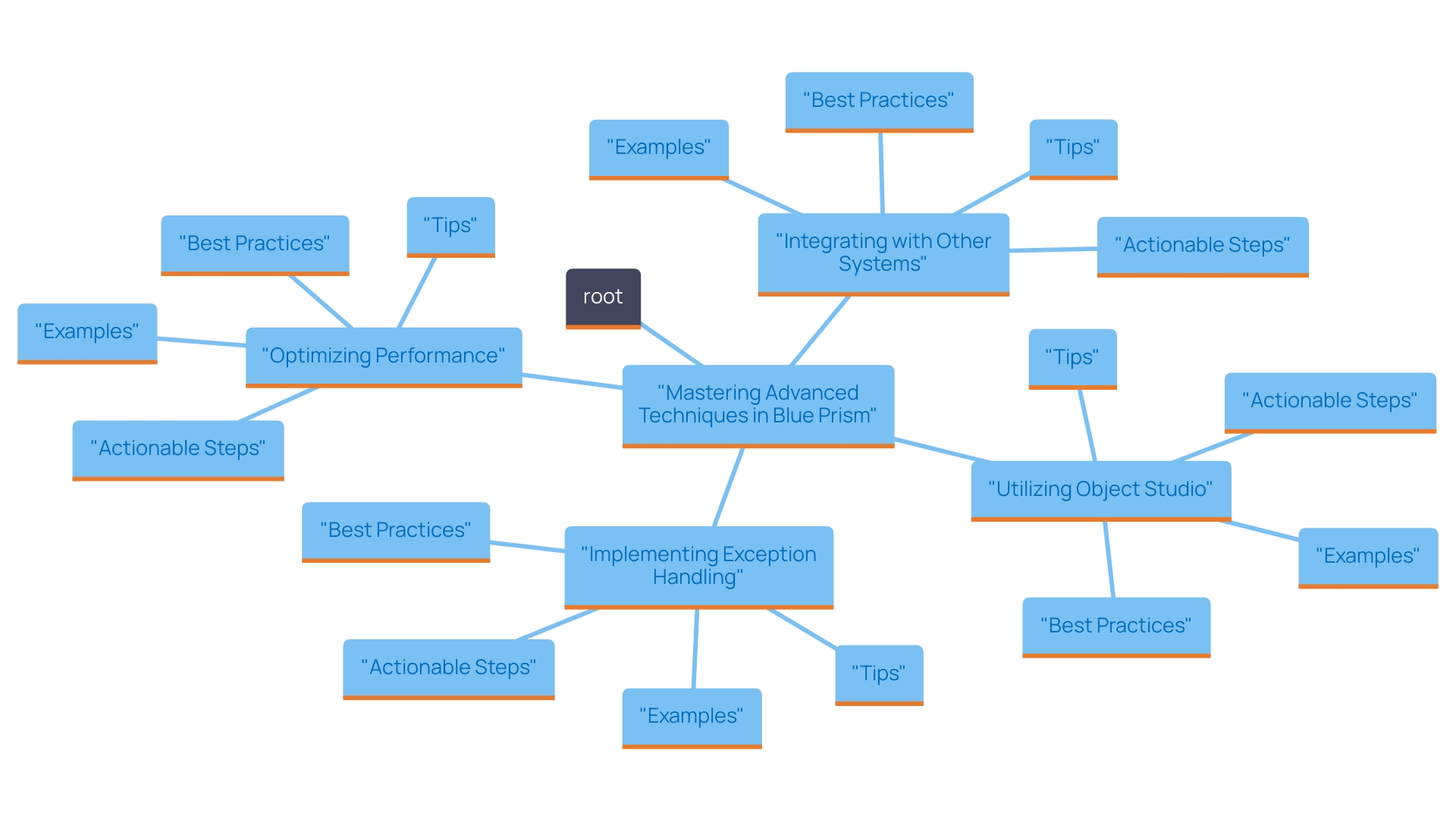
Creating a Comprehensive Automation Strategy
To create a successful automation strategy using Blue Prism, consider the following steps:
-
Evaluate Business Workflows: Determine which activities are the most suitable for mechanization based on factors such as complexity, frequency, and potential ROI. Our promise is clear: you only pay if we deliver what was promised, as we are confident in our ability to deliver. Utilize mapping tools to visualize and examine workflows, identifying challenges and opportunities for mechanization. Together, we will estimate the time savings and calculate the ROI of the automated process.
-
Define Objectives: Clearly outline the goals of your project, such as reducing processing time or improving accuracy. This will direct your mechanization efforts and help measure success.
-
Engage Stakeholders: Involve essential stakeholders in the planning phase to ensure buy-in and support for your mechanization initiatives. This will help address any resistance to change and foster a culture of collaboration.
-
Pilot Testing: Before large-scale implementation, conduct pilot tests to validate your automated processes. This allows you to refine workflows and address any potential issues. Collect input from users participating in the pilot to make necessary adjustments before implementing the system throughout the organization. Our proven method has assisted clients in decreasing data entry mistakes by 70% and enhancing workflow productivity by 80%.
-
Continuous Improvement: RPA is not a one-time project but a continuous journey. Consistently evaluate and enhance your automation methods to adjust to evolving business requirements and technological progress. By leveraging tailored AI solutions and business intelligence, you can unlock the power of data for informed decision-making, driving growth and innovation.
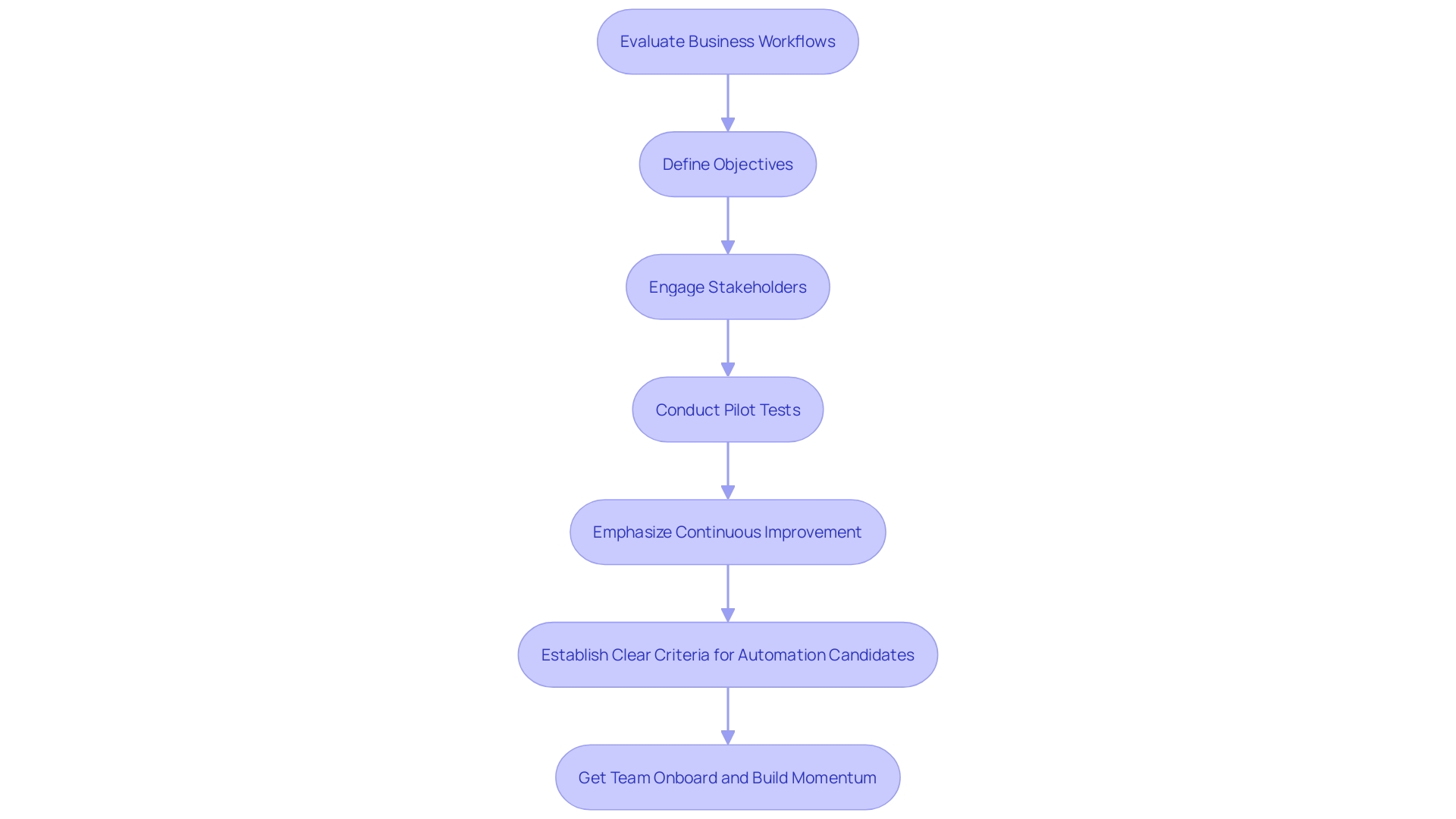
Measuring the Success of RPA Implementations
To effectively measure the success of your RPA implementations with Blue Prism, it is crucial to consider various metrics that highlight efficiency and effectiveness, particularly in a rapidly evolving AI landscape. Here are key metrics to track:
-
Time Savings: Automating tasks can lead to significant time savings by streamlining operations. For example, a manufacturing company reduced its order processing time by 50% after implementing RPA, allowing teams to focus on strategic tasks that add value.
-
Error Reduction: One of the key benefits of RPA is its ability to minimize human errors, leading to improved data quality. Measure this by comparing error rates in manual versus automated processes. A financial services firm reported a decrease in error rates from 15% to 5% post-automation, maintaining an exception rate below 20% to ensure reliability and accuracy, which is pivotal in the context of Business Intelligence.
-
Cost Savings: Financial benefits are a major driver for RPA adoption. Analyze the reduction in labor costs and the increased capacity to handle more work without additional resources. According to the Institute for Robotic Process Automation and Artificial Intelligence (IRPAAI), RPA solutions can offer a quick saving of 25% to 40% in labor costs. Calculate your ROI by comparing the costs of RPA implementation against the savings achieved, ensuring the investment aligns with your business goals.
-
Employee Satisfaction: By automating tedious tasks, employees can focus on more engaging and strategic work, improving overall morale. Gauge employee satisfaction levels post-automation through surveys to assess their sentiment about workload and job satisfaction. A motivated workforce is essential for the success of any initiative, supporting the goal of enhancing productivity.
-
Scalability: The flexibility of Blue Prism enables swift expansion of initiatives to meet increasing business requirements. Track the quantity of tasks streamlined over time and the simplicity of incorporating new systems into the current framework. Scalability ensures that your solutions can grow with your business, maintaining efficiency and effectiveness.
Additionally, it is essential to keep the margin of error within acceptable limits. The margin of error, a critical metric in RPA, should not exceed 20% to maintain the effectiveness of your automation processes. By adhering to these metrics, you can ensure that your RPA implementations are successful, reliable, and scalable, ultimately leveraging Business Intelligence to transform raw data into actionable insights for informed decision-making.
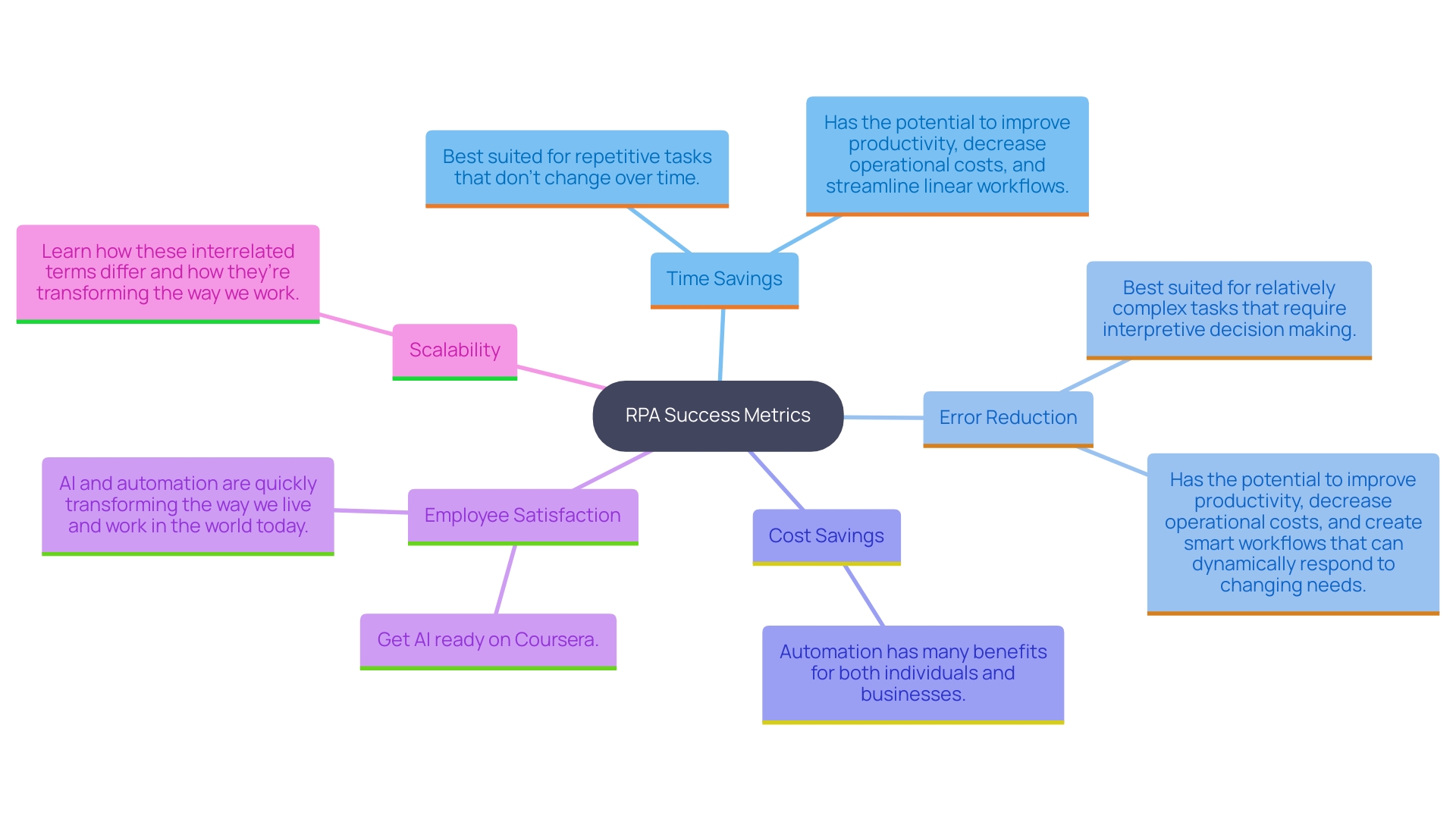
Conclusion
Embracing Robotic Process Automation (RPA) represents a transformative step for organizations aiming to enhance operational efficiency and reduce the burdens of repetitive tasks. By understanding the foundational concepts of RPA and leveraging advanced tools like Blue Prism, businesses can automate a wide array of processes, resulting in significant time and cost savings. This journey begins with a clear assessment of business processes, defining objectives, and engaging stakeholders to ensure a cohesive approach.
The implementation of advanced techniques, such as effective exception handling and performance optimization, allows organizations to maximize the benefits of automation. By continuously reviewing and refining these processes, businesses can adapt to evolving needs and maintain a competitive edge. Furthermore, employing metrics such as time savings, error reduction, and employee satisfaction provides a comprehensive view of the effectiveness of RPA initiatives, enabling informed decision-making.
Ultimately, RPA is not merely a technological upgrade; it is a strategic initiative that empowers organizations to unlock their full potential. By freeing up human resources from mundane tasks, companies can foster a more engaged workforce focused on strategic initiatives, driving innovation and growth. The time to act is now—embracing RPA will set the foundation for operational excellence and pave the way for a more productive future.
Discover how our tailored RPA solutions can transform your operations today!
Introduction
In the rapidly evolving landscape of modern business, organizations are increasingly turning to Robotic Process Automation (RPA) as a powerful solution to streamline operations and enhance productivity. By automating repetitive and rule-based tasks, RPA not only alleviates staffing challenges but also empowers employees to focus on more strategic initiatives. However, to fully leverage the potential of RPA, a clear understanding of its lifecycle is essential—from identifying suitable processes for automation to monitoring performance post-implementation.
This article delves into the intricacies of RPA, exploring its lifecycle, the essential stages for successful implementation, and the metrics that drive its effectiveness. By addressing common challenges and embracing future trends, organizations can cultivate a culture of automation that propels them toward sustained operational excellence.
Understanding Robotic Process Automation (RPA) and Its Lifecycle
Robotic Process Automation (RPA) transforms how entities manage routine and repetitive tasks, significantly enhancing efficiency and productivity. By leveraging innovative tools like EMMA RPA and Microsoft Power Automate, organizations can transform operations, overcome staffing shortages, and enhance employee morale. Grasping the RPA lifecycle is crucial for effective implementation and optimizing the advantages of mechanization. This lifecycle includes several stages, each essential for aligning RPA solutions with organizational objectives.
The first stage involves identifying processes prime for automation, focusing on repetitive, rule-based, and high-volume tasks. Next, the development phase encompasses designing and building the RPA solution tailored to these identified processes. Once developed, the solution enters the testing stage, where it is rigorously evaluated for accuracy and reliability.
Deployment follows, integrating the RPA solution into the operational environment. After deployment, ongoing monitoring and maintenance are crucial to ensure the solution stays effective and adjusts to any changes in operational processes.
Recent advancements in RPA technology have streamlined this lifecycle, incorporating sophisticated analytics and AI capabilities to enhance process identification and optimization. In 2024, RPA adoption surged, with reports indicating a 30% increase in implementation across various industries, as companies leverage these technologies to tackle more complex and dynamic tasks. This surge underscores the importance of RPA in enhancing operational efficiency and addressing staffing challenges.
Moreover, understanding the personal data processing notice issued by Defra is crucial, as it outlines how personal data related to financial transactions is managed, including any potential offshore processing by its service provider. This knowledge is vital for ensuring RPA implementation complies with data protection regulations, thereby safeguarding sensitive information.
By meticulously following the RPA lifecycle, organizations can implement robust solutions that drive efficiency, increase accuracy, and ultimately deliver substantial business value. This comprehensive strategy enables operations directors to make informed choices, ensuring the success of their projects.
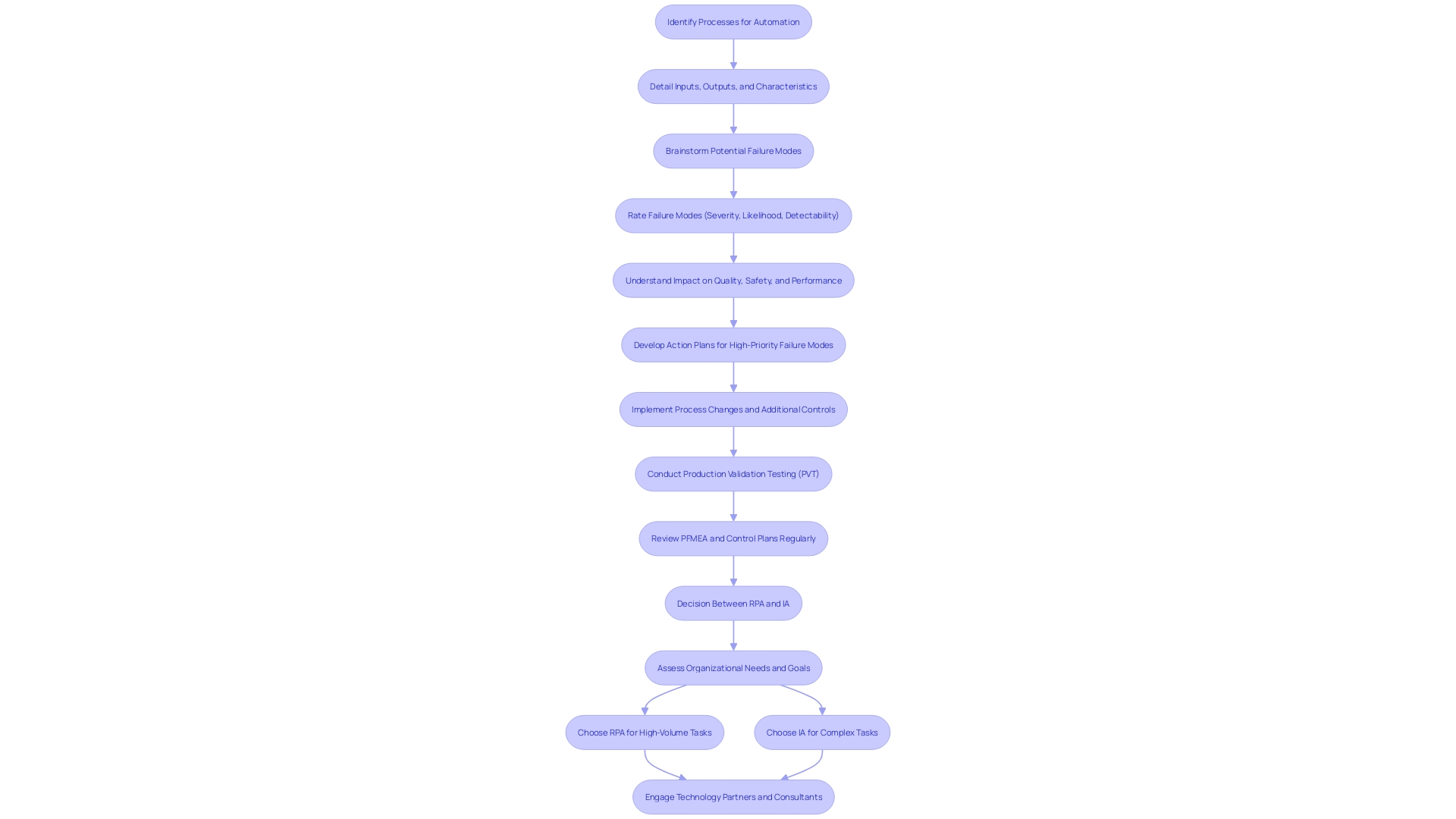
The Six Essential Stages of the RPA Life Cycle
Are you ready to revolutionize your operations? Recognizing procedures for mechanization is the crucial first step in the RPA lifecycle. This stage involves pinpointing tasks that are repetitive, rule-based, and high in volume, such as:
- Invoice processing
- Customer onboarding
- Data entry
By assessing their operations, organizations can identify which tasks are prime candidates for mechanization, thereby addressing common workplace challenges like staffing shortages and outdated systems. Our RPA solutions can significantly enhance these tasks, streamlining operations and boosting efficiency.
For instance, a recent case study illustrated how a mid-sized company enhanced efficiency by mechanizing:
- Data entry
- Software testing
- Legacy system integration through GUI processes
They encountered obstacles like manual data entry mistakes and sluggish software testing, but after adopting automated solutions, they accomplished a 70% decrease in data entry errors and a 50% increase in testing speeds, leading to an 80% enhancement in workflow efficiency. Such measurable outcomes underscore the importance of identifying and automating suitable processes.
According to a report by Grand View Research, the global process optimization market is expected to reach $19.6 billion by 2026, expanding at a CAGR of 12.2% from 2019 to 2026. This growth emphasizes the rising demand for organizations to utilize AI-driven operational process enhancement for tasks such as:
- Data extraction
- Process discovery
- Predictive analytics
- Customer service
RPA developers play a crucial role in this stage, as they design the ecosystem for deploying bots, monitor performance, and integrate with existing technologies. Recent advancements in process identification techniques, such as machine learning algorithms and advanced analytics, empower organizations to analyze historical data and pinpoint inefficiencies, ensuring that automation efforts deliver maximum benefits.
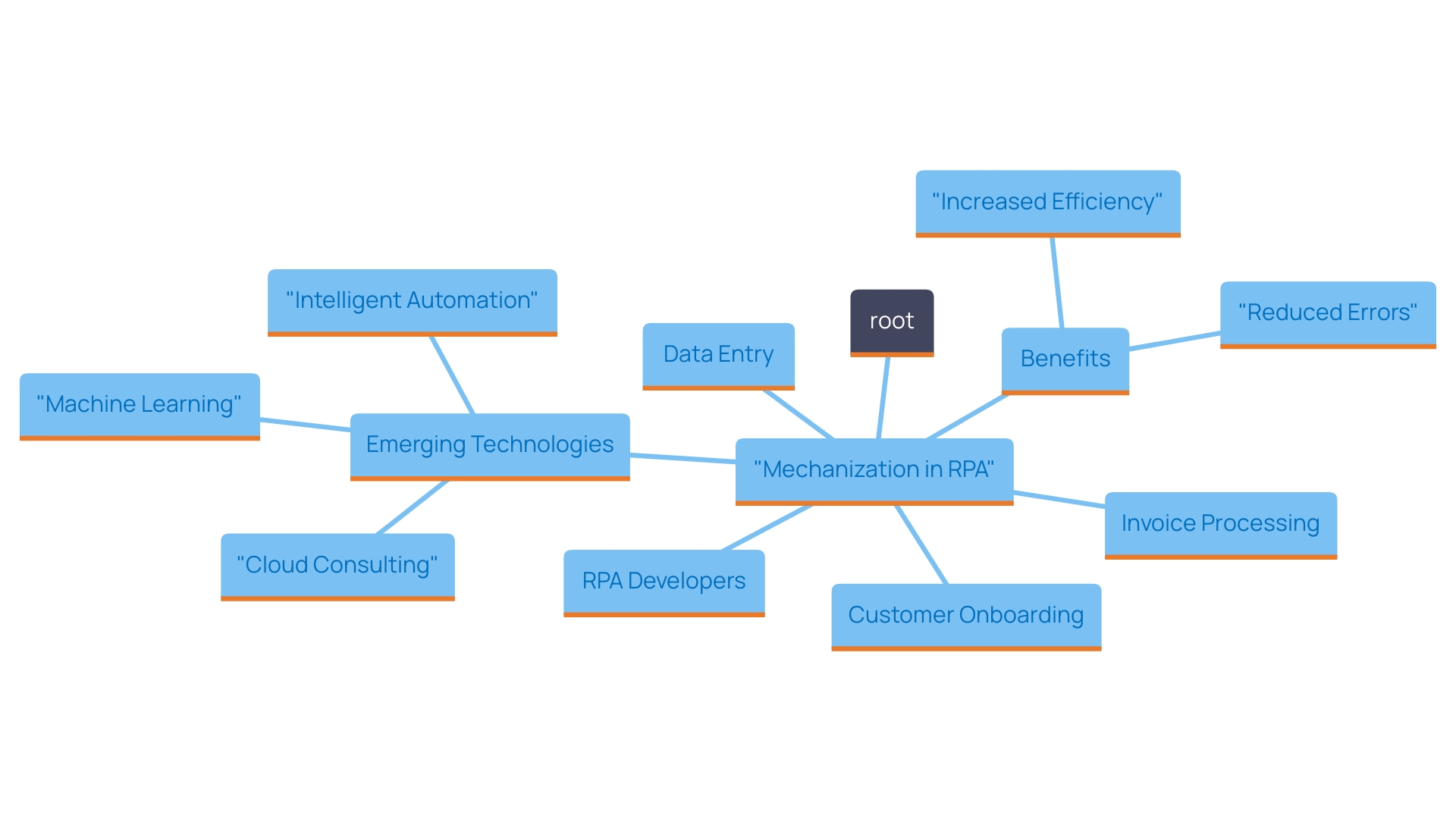
Overcoming Challenges in RPA Implementation
Implementing RPA can present several challenges, including resistance to change from employees, technical issues, and insufficient alignment with organizational goals. To overcome these obstacles:
- Engage Stakeholders: Involve key stakeholders early in the process to gain buy-in and support for RPA initiatives, thereby enhancing efficiency and addressing technology implementation challenges. For example, a manufacturing company that engaged its frontline workers in the RPA planning process saw a 30% increase in adoption rates.
- Provide Training: Invest in training programs that ensure employees feel comfortable with the new technology and understand its benefits. By empowering your team with knowledge, you can boost morale and facilitate a smoother transition. Case studies indicate that entities that provided comprehensive training experienced a 40% reduction in operational errors post-implementation.
- Establish Clear Metrics: Define success metrics from the outset to measure the impact of RPA on operational efficiency. This includes utilizing intelligence to transform raw data into actionable insights that drive informed decision-making. For instance, a financial services firm that implemented RPA with clear KPIs reported a 25% increase in processing speed and a significant reduction in manual errors.
By proactively tackling these challenges and concentrating on customized AI solutions, organizations can create a smoother shift to mechanization and maximize the benefits of RPA. This strategic approach not only drives growth and innovation but also enhances overall operational efficiency, making RPA a critical component of modern business success.
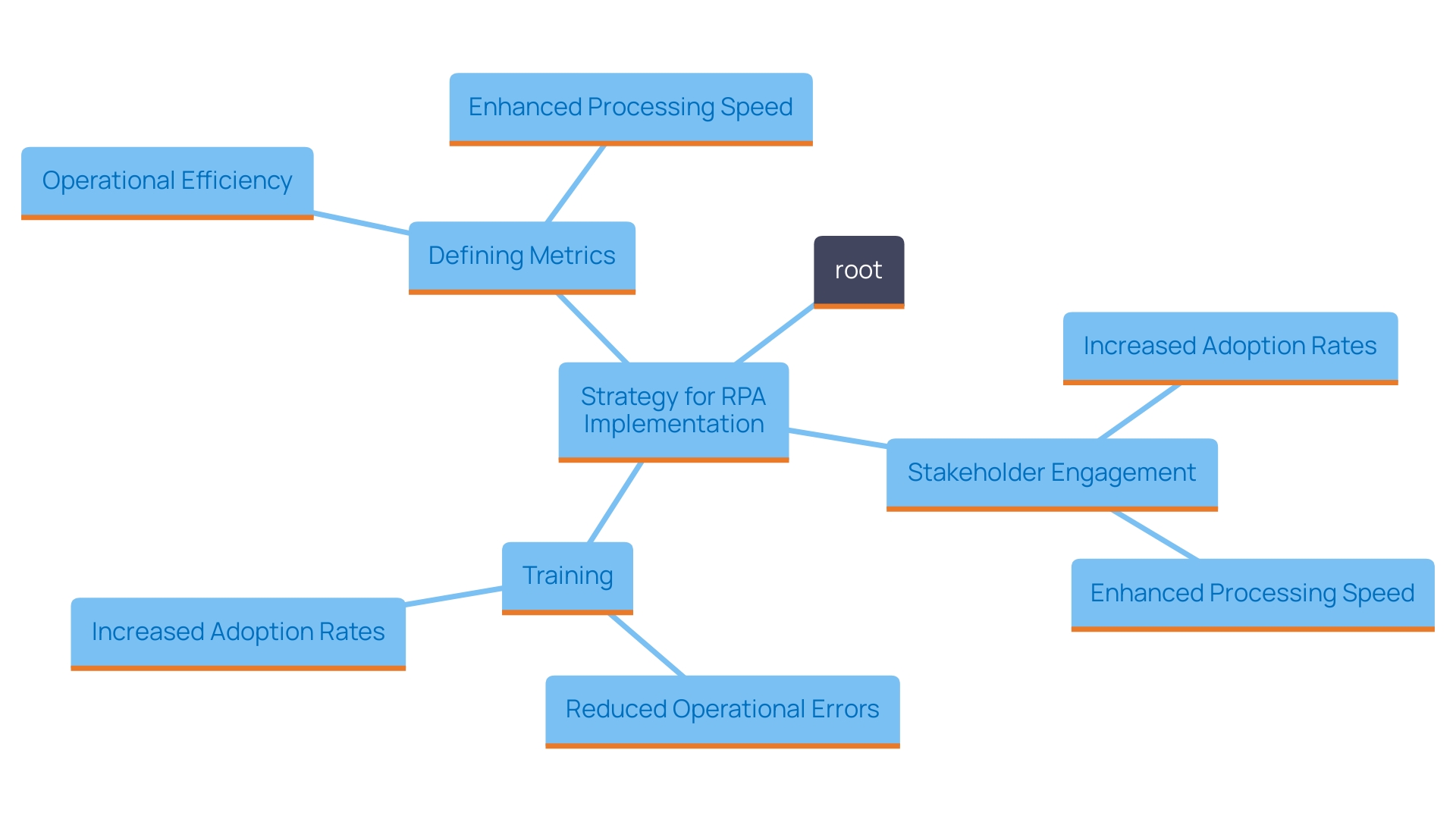
The Role of Metrics in RPA Success
To ensure the success of RPA initiatives, establishing clear metrics to track performance is crucial in addressing common workplace challenges such as staffing shortages, repetitive tasks, and outdated systems. Key performance indicators (KPIs) might include:
- Time Saved: Evaluate how automated tasks reduce the time needed compared to manual efforts. For instance, the DOBOT CR series robot arms can pick and place seven boxes in just one minute, demonstrating significant time savings that can enhance overall operational efficiency.
- Error Rate: Monitor the frequency of errors in automated processes versus manual ones. A lower error rate in automation signifies enhanced accuracy and reliability, which directly contributes to improved operational outcomes.
- Cost Savings: Assess the financial impact of RPA on operational costs, including reductions in labor expenses and increased efficiency leading to higher profitability. By modernizing processes with RPA solutions, entities can streamline workflows and free up their teams for more strategic, value-adding work.
Additionally, the quality of hardware is a critical metric for assessing robot efficiency, as it influences both reliability and maintenance needs. By considering hardware quality, companies can ensure the successful deployment and operation of collaborative robots in industrial tasks. Regularly reviewing these metrics enables entities to identify areas for improvement and validate the effectiveness of their RPA solutions, ensuring alignment with overarching business goals and enhancing productivity through tailored AI solutions and business intelligence for informed decision-making.
Moreover, the importance of robust performance metrics in driving RPA success is underscored by industry experts. As highlighted, ‘Like MongoDB with vector search, investors and users are waiting to see what Datadog—which is already deeply entrenched in enterprises—does in AI observability and evaluation.’ This quote emphasizes the need for comprehensive metrics not only in evaluating RPA performance but also in maintaining competitiveness in a rapidly evolving landscape.
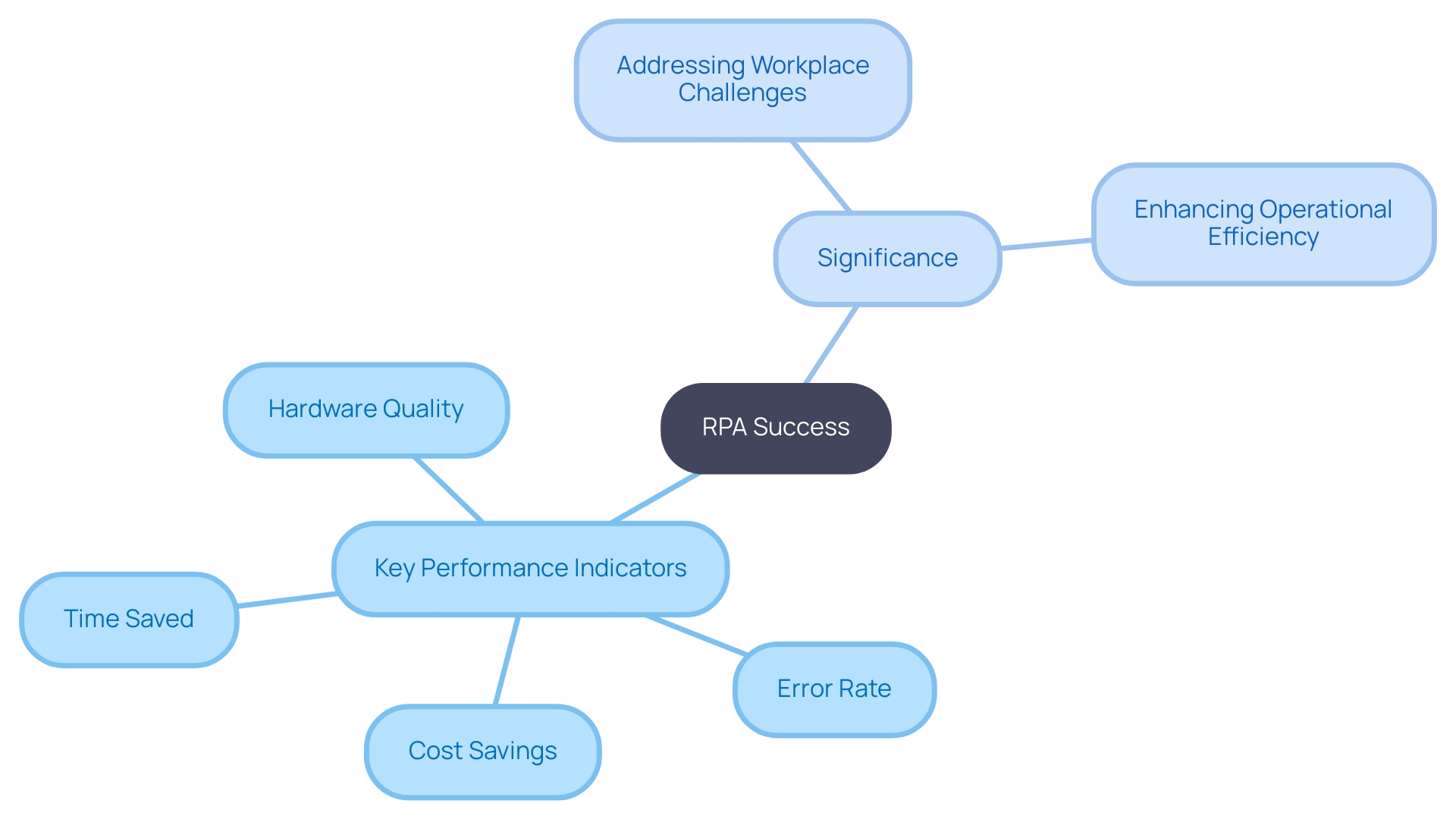
Future Trends in RPA Technology
As RPA technology continues to advance, several key trends are shaping the future landscape of automation:
-
Integration with Artificial Intelligence: The fusion of RPA and AI is ushering in an era of intelligent automation. This convergence enables systems to perform complex decision-making tasks, significantly enhancing operational efficiency. For instance, UiPath’s RPA solution has demonstrated up to 80% faster reconciliation times and double the transaction processing capacity compared to traditional methods. This efficiency not only streamlines operations but can also result in substantial cost savings for entities.
-
Enhancing Business Productivity: RPA can automate manual workflows, significantly reducing the time spent on repetitive tasks, thereby freeing up teams to focus on strategic initiatives that drive growth. In today’s data-rich environment, leveraging RPA alongside tailored AI solutions and Business Intelligence empowers entities to make informed decisions that propel innovation.
-
Increased Focus on User Experience: Future RPA solutions are set to prioritize user-friendly interfaces, making them more accessible and easier to adopt. By enhancing usability, companies can ensure smoother integration and greater acceptance among employees, which is crucial for successful implementation.
-
Cloud-Based RPA Solutions: The shift towards cloud computing is facilitating the scalability of RPA solutions. Cloud-based platforms provide advanced features and enhanced flexibility, enabling organizations to broaden their capabilities more effectively. This scalability is especially crucial as companies expand and their operational needs change.
Moreover, case studies reveal that many enterprises face challenges in RPA adoption due to error amplification and the need for robust use cases. RPA suppliers are progressively partnering with clients to pinpoint opportunities for efficiency, resulting in the creation of pilot projects that showcase the potential of RPA. This collaborative approach guarantees that businesses have a solid foundation for their operational strategies.
Staying informed about these trends is crucial for organizations aiming to harness the full potential of RPA technologies. As Marina Bill, President of the International Federation of Robotics, emphasizes, ‘The five mutually reinforcing technological trends in 2024 demonstrate that robotics is a multidisciplinary field where technologies are converging to create intelligent solutions for a wide range of tasks.’ Embracing these advancements will position businesses to thrive in the competitive landscape of digital transformation.
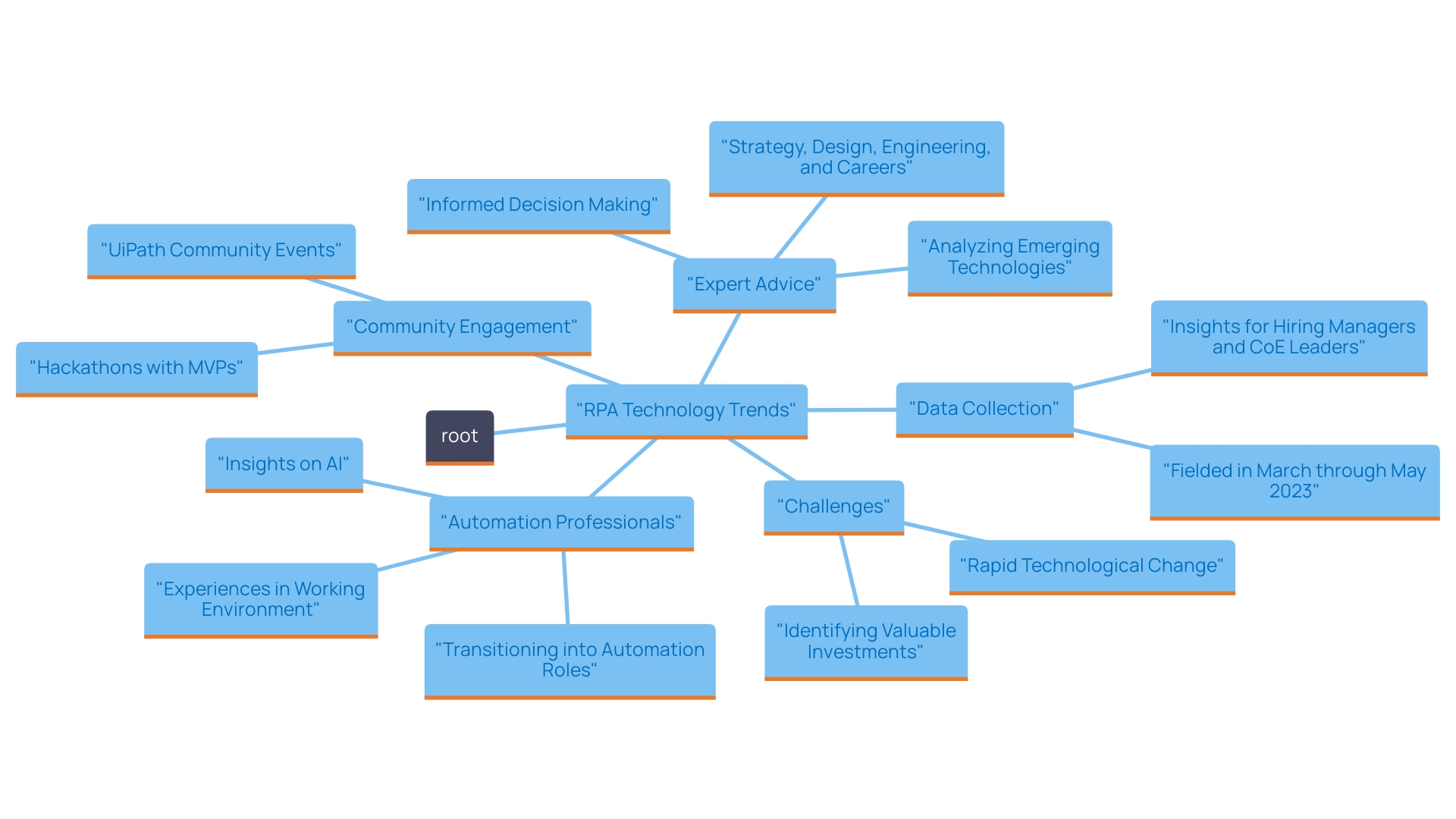
Building a Culture of Automation
To fully utilize the advantages of Robotic Process Automation (RPA), entities need to foster a culture that wholeheartedly accepts automated processes.
-
Education and Awareness: Continuous education on RPA’s benefits is crucial. Highlighting how RPA can enhance human work rather than replace it can alleviate fears and boost acceptance. According to recent statistics, organizations that prioritize education and awareness see significantly higher rates of RPA adoption. For instance, in 2024, it’s projected that companies with strong educational initiatives will achieve a 30% increase in technology adoption rates compared to those that do not invest in such programs. Tailored AI solutions can play a pivotal role in this education by providing targeted technologies that align with specific business goals, such as customized training modules that demonstrate RPA’s effectiveness in various scenarios.
-
Celebrate Successes: Acknowledging and celebrating successful projects can create a ripple effect of enthusiasm and support for future initiatives. For instance, the case study of Databricks Cluster Creation showcases how overcoming initial challenges through proper formatting and adjustments led to successful outcomes, reinforcing the value of persistence and innovation. By sharing these successes, such as a 25% reduction in processing time achieved through RPA in the finance department, organizations can demonstrate the tangible benefits of RPA and its role in enhancing productivity.
-
Encourage Innovation: Fostering an environment where employees feel empowered to propose streamlined processes and innovate continuously is key. As Jessica Hill highlights, ‘An Azure Databricks Notebook is a powerful data science tool that supports exploratory data analysis, hypothesis testing, data cleaning and transformation, data visualization, statistical modeling, and machine learning.’ This insight underscores the importance of equipping teams with the right tools and encouraging them to explore new possibilities. Leveraging business intelligence can further aid in transforming raw data into actionable insights, enabling informed decision-making that drives growth.
By actively fostering a culture of mechanization, groups can significantly boost employee involvement and guarantee a smoother transition to automated processes. Such an approach not only drives efficiency but also creates a more dynamic and forward-thinking workplace. In summary, organizations should focus on education, celebrate successes, and foster innovation to build a robust culture of automation that propels them toward a successful digital transformation.
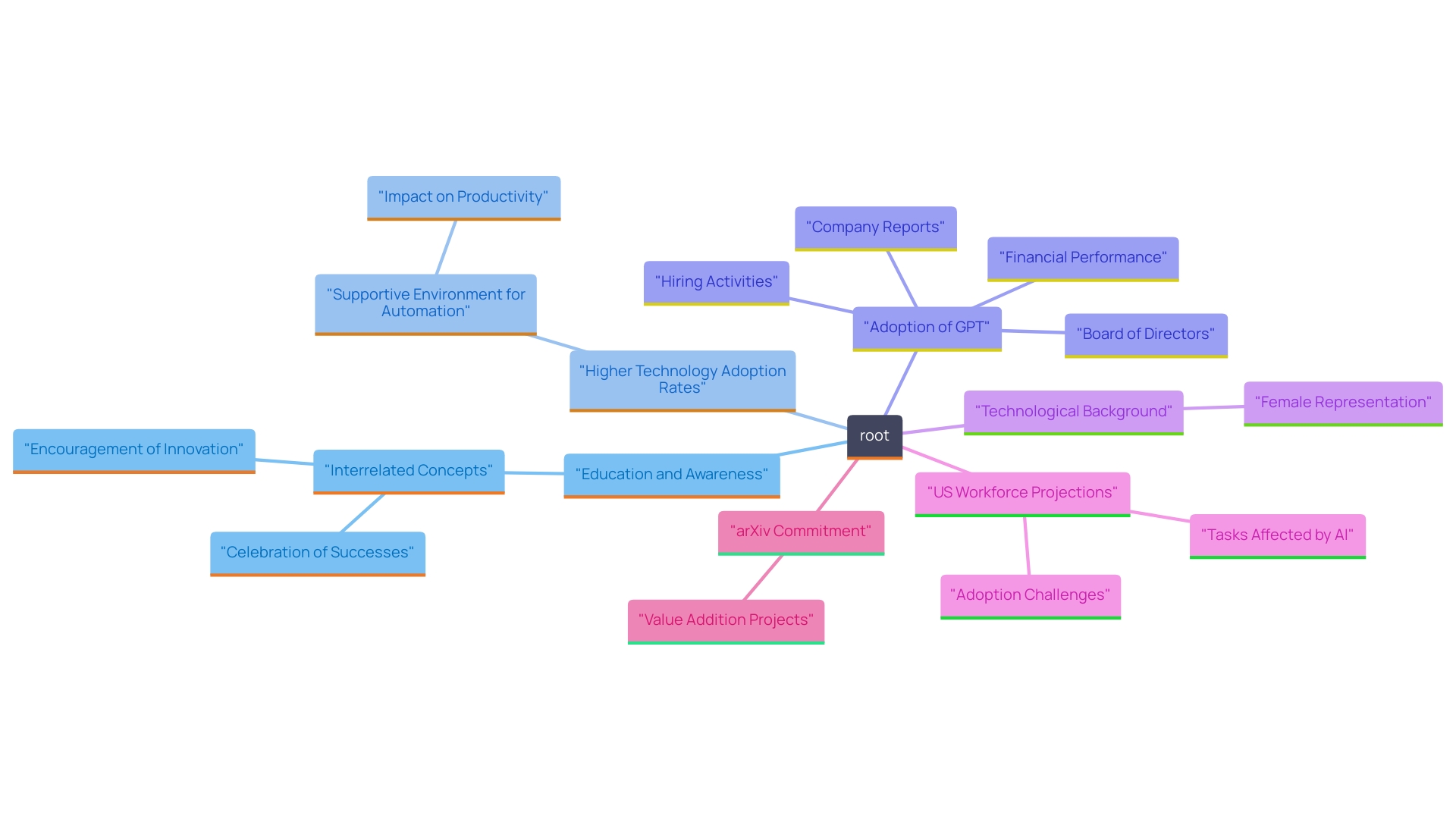
Conclusion
Embracing Robotic Process Automation (RPA) is not merely a trend; it is a strategic necessity for organizations aiming to enhance operational efficiency and drive productivity. The article has outlined the critical stages of the RPA lifecycle, from identifying suitable processes for automation to ensuring continuous monitoring post-implementation. By understanding and meticulously following this lifecycle, organizations can align RPA solutions with their business objectives, ultimately leading to substantial improvements in workflow efficiency and accuracy.
The challenges associated with RPA implementation, such as resistance to change and technical issues, can be effectively mitigated through proactive stakeholder engagement, comprehensive training, and the establishment of clear metrics. These actions empower employees and facilitate a smoother transition to automation, reinforcing the notion that RPA is a tool for human enhancement rather than replacement. Furthermore, the significance of robust performance metrics cannot be overstated, as they provide actionable insights that drive informed decision-making and validate the effectiveness of RPA initiatives.
As the landscape of RPA technology continues to evolve, organizations must stay ahead of emerging trends, such as the integration of artificial intelligence and the shift toward cloud-based solutions. By fostering a culture of automation that prioritizes education, celebrates successes, and encourages innovation, businesses can position themselves for sustained growth and competitiveness in a rapidly changing environment. The journey towards automation is not just about adopting new technologies; it is about transforming organizational mindsets and practices to fully leverage the benefits that RPA has to offer.
Introduction
In a world where efficiency is paramount, Robotic Process Automation (RPA) stands out as a game-changing technology that promises to revolutionize the way organizations operate. By deploying software bots to handle repetitive tasks, RPA not only reduces the burden on human employees but also enhances accuracy and accelerates processing times. As businesses navigate the complexities of modern operations, RPA offers a clear path toward improved productivity and cost savings.
With a growing number of companies recognizing its potential—evidenced by significant budget allocations for automation—this article delves into the transformative power of RPA, exploring its benefits, implementation challenges, and future trends that will shape the landscape of business automation. Embracing RPA is not merely about replacing manual efforts; it is about unlocking the potential of human talent to focus on strategic, innovative initiatives that drive success.
Understanding Robotic Process Automation (RPA): A Comprehensive Overview
Robotic Process Automation (RPA) embodies a transformative technology that utilizes software robots, or ‘bots’, to automate repetitive and rules-based tasks traditionally managed by human employees. As Directors of Operations Efficiency grapple with the challenges of enhancing productivity while managing costs, RPA emerges as a powerful solution aimed at improving efficiency by mimicking human actions across digital platforms, facilitating a seamless workflow. RPA is especially beneficial in data-driven environments, where it fosters higher accuracy, significant reductions in costs, and accelerated processing times.
A striking case study illustrates this impact: a mid-sized healthcare company improved efficiency by mechanizing data entry, software testing, and legacy system integration using GUI technology. They faced challenges such as manual data entry errors and slow software testing, but by implementing solutions like EMMA RPA and Microsoft Power Automate, they achieved:
- A 70% reduction in data entry errors
- A 50% acceleration in testing processes
Overall, workflow efficiency improved by 80%, with ROI realized within just six months. This success highlights the effectiveness of RPA solutions in improving efficiency and employee morale.
As organizations increasingly adopt RPA, a notable trend emerges: nearly 48% of companies are earmarking between 10% and 20% of their total annual budgets for document and process automation over the next 18 months. This shift underscores the system’s increasing significance in the pursuit of efficiency and innovation. However, as emphasized in recent studies, customers require continuous support from vendors throughout the adoption journey, not just at the initial point of purchase.
By embracing RPA, businesses can effectively eliminate mundane tasks, liberating human talent to concentrate on strategic initiatives that demand critical thinking and creativity. According to Augustin Gohil, President of SalesCatcher, ‘RPA not only streamlines operations but also empowers teams to focus on innovation and growth.’ This example not only highlights RPA’s potential but also serves as a testament to its role in redefining efficiency across various industries.
To effectively execute RPA, organizations should think about beginning with a pilot project, evaluating the specific processes that can gain from mechanization, and ensuring strong training and support for their teams to maximize the system’s impact.
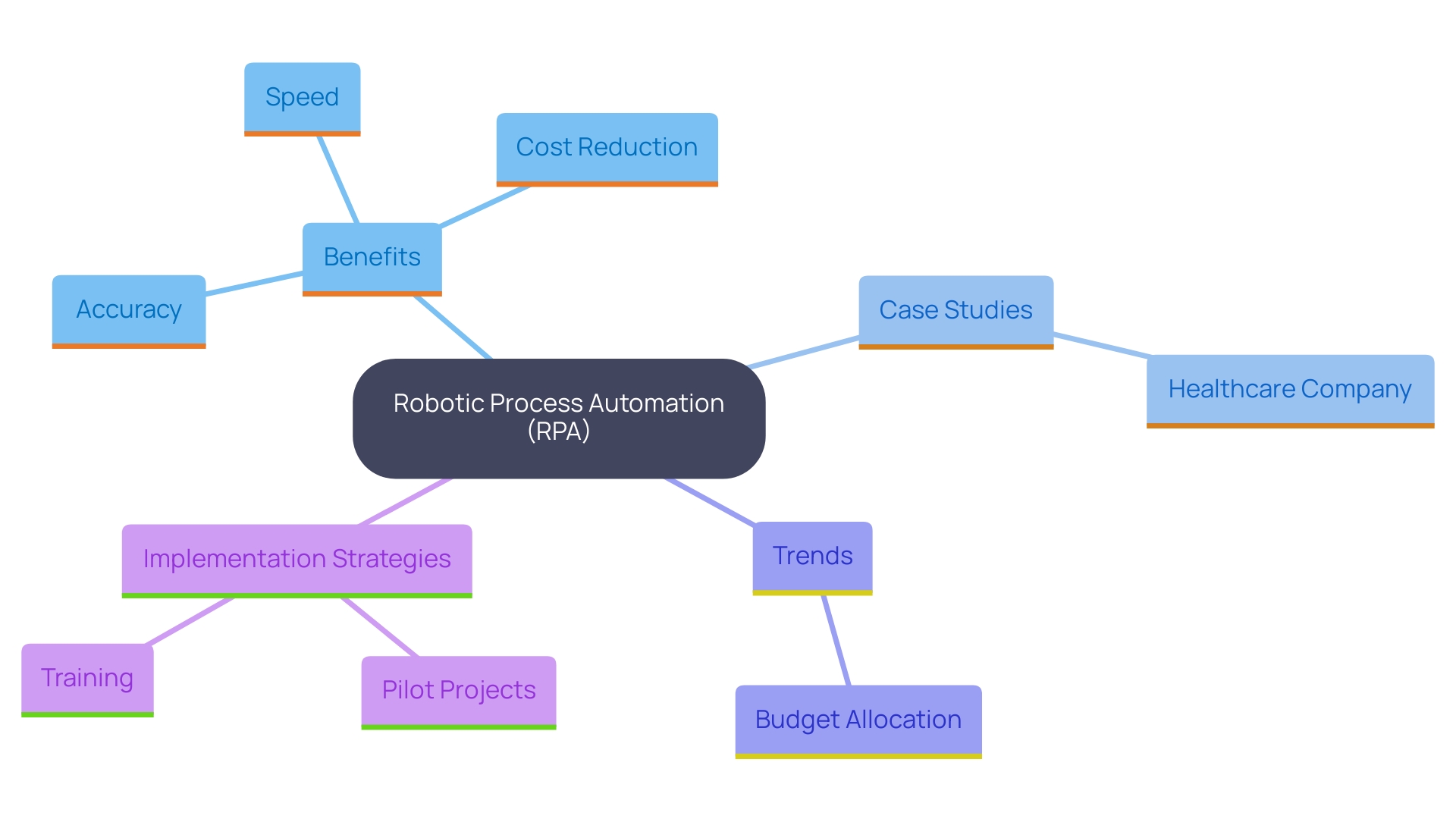
The Role of RPA in Streamlining Business Processes and Enhancing Efficiency
RPA is an essential catalyst for streamlining business processes, automating tasks such as data entry, invoice processing, and customer service inquiries. Organizations that have embraced RPA technology report remarkable reductions in processing times and expenses. For example, companies utilizing RPA have observed cost savings of up to 30%, highlighting the substantial financial advantages of smart processes. Additionally, CNH aims to save 10,000 hours by leveraging GitHub Copilot, an AI-driven coding tool that assists developers by suggesting code snippets, further exemplifying the time savings achievable through RPA.
By automating repetitive tasks, RPA not only mitigates the risk of human error but also accelerates task execution, ultimately enhancing customer satisfaction. As Ryan Kane, owner of the IT managed services provider Soaring Towers, aptly puts it,
- “They need to be shown how to really use the tool in order to use it effectively. A chisel in the hands of a trained professional can create amazing things; a chisel in the hands of an amateur can be a lost opportunity.”
This perspective underscores the importance of proper implementation and training in maximizing RPA potential.
Moreover, RPA tools can seamlessly integrate with existing systems without necessitating major changes to the underlying infrastructure, making it a cost-effective solution for organizations striving to boost efficiency. This allows businesses to reallocate resources more strategically, redirecting focus toward innovation and driving growth, thereby gaining a competitive edge in their industries. The incremental approach to AI implementation suggests that companies prioritizing projects based on their business needs are more likely to succeed. This reinforces the notion that RPA is not just about automation but also about augmenting human capabilities and enhancing outcomes. Moreover, further case studies suggest that organizations implementing RPA with a clear strategy have realized up to 40% enhancement in operational efficiency, emphasizing the transformative potential of this innovation.
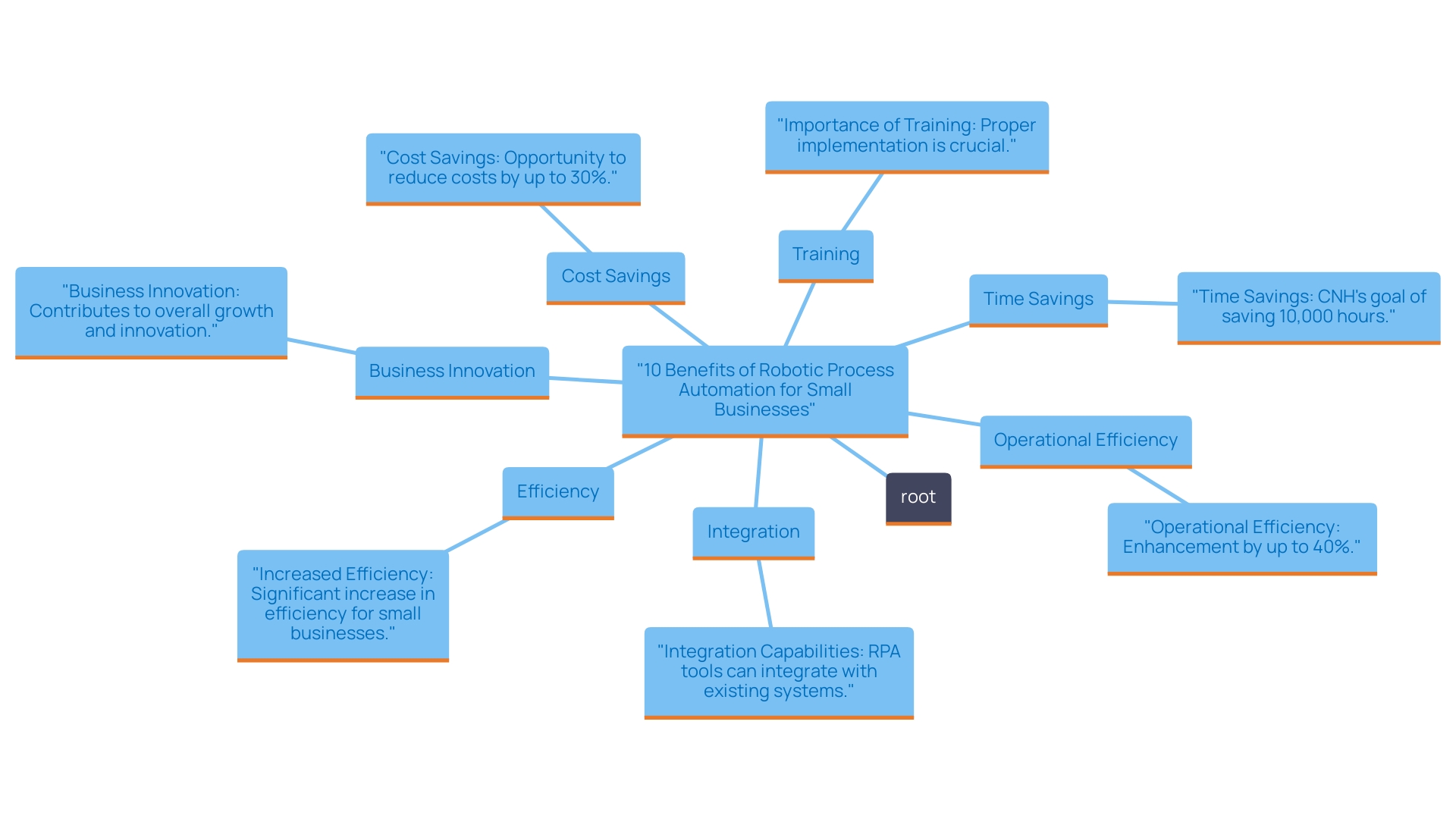
Challenges in Implementing RPA Solutions
Implementing Robotic Process Automation (RPA) solutions can offer significant advantages, but it also presents several challenges that organizations must navigate. One significant obstacle is employee resistance, often based on fears of job displacement or unwillingness to adopt new advancements. Recent statistics indicate that roughly 40% of employees voice concerns regarding mechanization, emphasizing the need for proactive engagement.
To address this resistance, leaders should:
- Involve employees early in the RPA journey, ensuring they feel supported and informed.
- Provide comprehensive training.
- Foster a culture of innovation to facilitate a smoother transition.
As one expert insightfully notes, ‘Making the technology more personal leads to accelerated adoption, buy-in, and change.’
Additionally, organizations must focus on the clarity of their processes. Poorly defined processes can hinder effective RPA implementations, resulting in suboptimal outcomes. Conducting a thorough evaluation of existing processes before mechanization is essential. This aligns with our risk-free, ROI-driven methodology, where we:
- Assess your processes.
- Calculate effort.
- Estimate time savings.
- Automate through certified professionals.
By pinpointing areas where RPA can deliver maximum value, organizations can enhance productivity and overall efficiency. Our GUI testing case studies demonstrate how mid-sized companies have successfully reduced data entry errors by 70% and accelerated testing processes by 50%, achieving ROI within six months.
By proactively addressing these challenges, organizations can leverage RPA as a powerful tool for driving operational excellence, rather than viewing it merely as a replacement for human workers. Ultimately, embracing RPA not only streamlines operations but also empowers teams to focus on more strategic, value-adding initiatives.
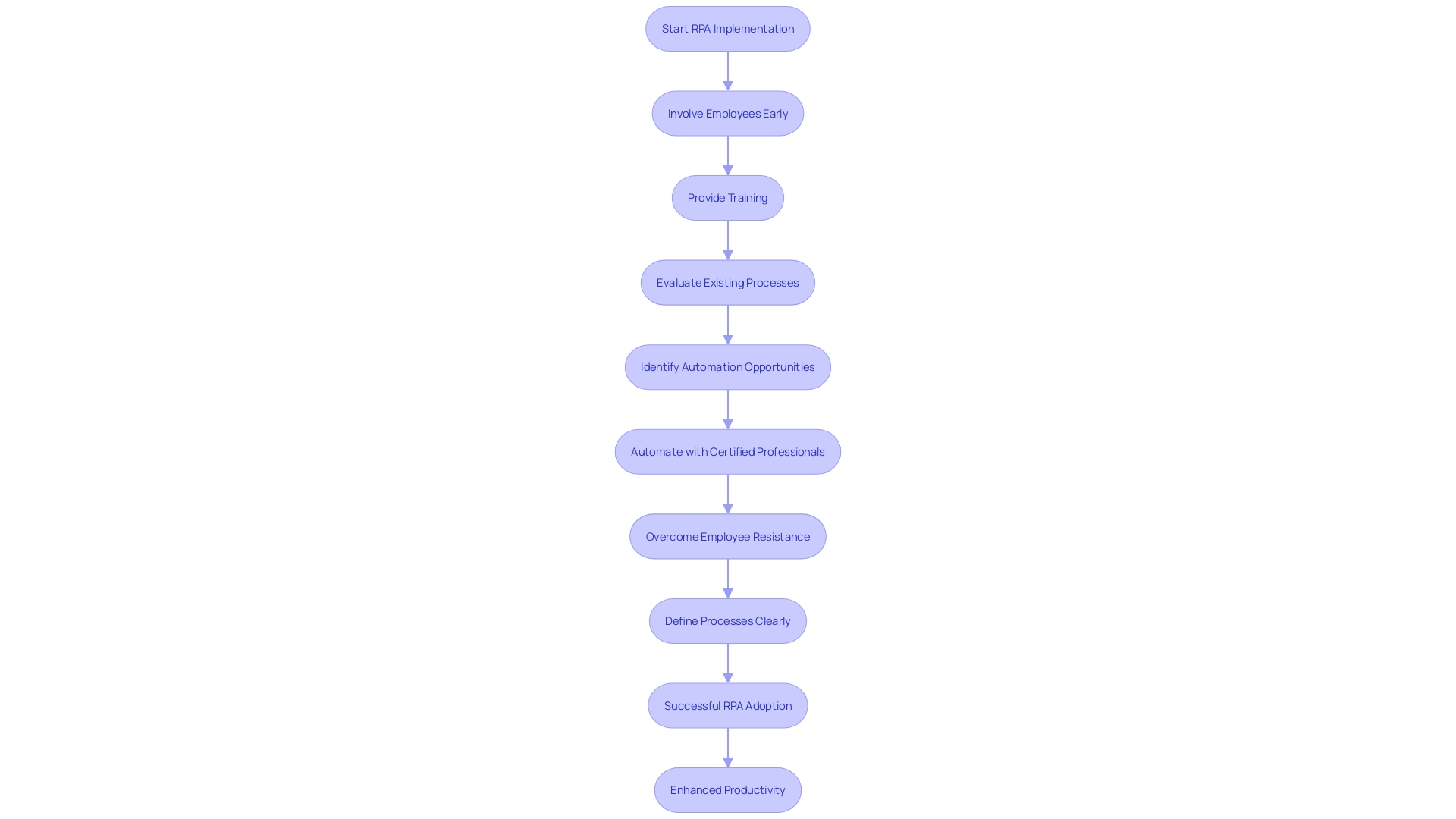
Future Trends in RPA and Business Automation
The future of Robotic Process Automation (RPA) is poised for transformative advancements that will significantly impact business operations strategies. A key trend emerging is the seamless integration of RPA with artificial intelligence (AI) and machine learning (ML). This powerful combination enables bots not only to carry out routine tasks but also to make intelligent decisions, effectively addressing complex challenges that require cognitive capabilities. By leveraging RPA, organizations can enhance operational efficiency, reduce manual workloads, and free up valuable resources for more strategic initiatives.
Furthermore, the RPA market is expected to attain $50.50 billion worldwide by 2030, emphasizing the increasing significance of intelligent processes in business strategies. The rise of no-code and low-code platforms is democratizing automation, enabling non-technical users to develop and manage RPA solutions without extensive programming knowledge. This trend empowers teams across various departments to actively participate in digital transformation initiatives, fostering a culture of innovation and agility essential for overcoming implementation challenges.
Organizations that proactively embrace these advancements position themselves for a competitive edge. For instance, the Nividous platform successfully automated claims processing for an eyecare practice, saving skilled staff over 37,000 hours annually and reducing the claim-to-cash cycle by nine days. This example illustrates the tangible benefits of RPA, addressing common reluctance to adopt AI due to perceived complexities and costs. As companies utilize these innovations, they enhance operational processes while fostering an environment that emphasizes continuous improvement and adaptability—essential for succeeding in a rapidly changing business landscape. Furthermore, as RPA technology continues to evolve, we can anticipate future trends that will integrate AI capabilities even further, leading to greater efficiencies and innovations in automation.
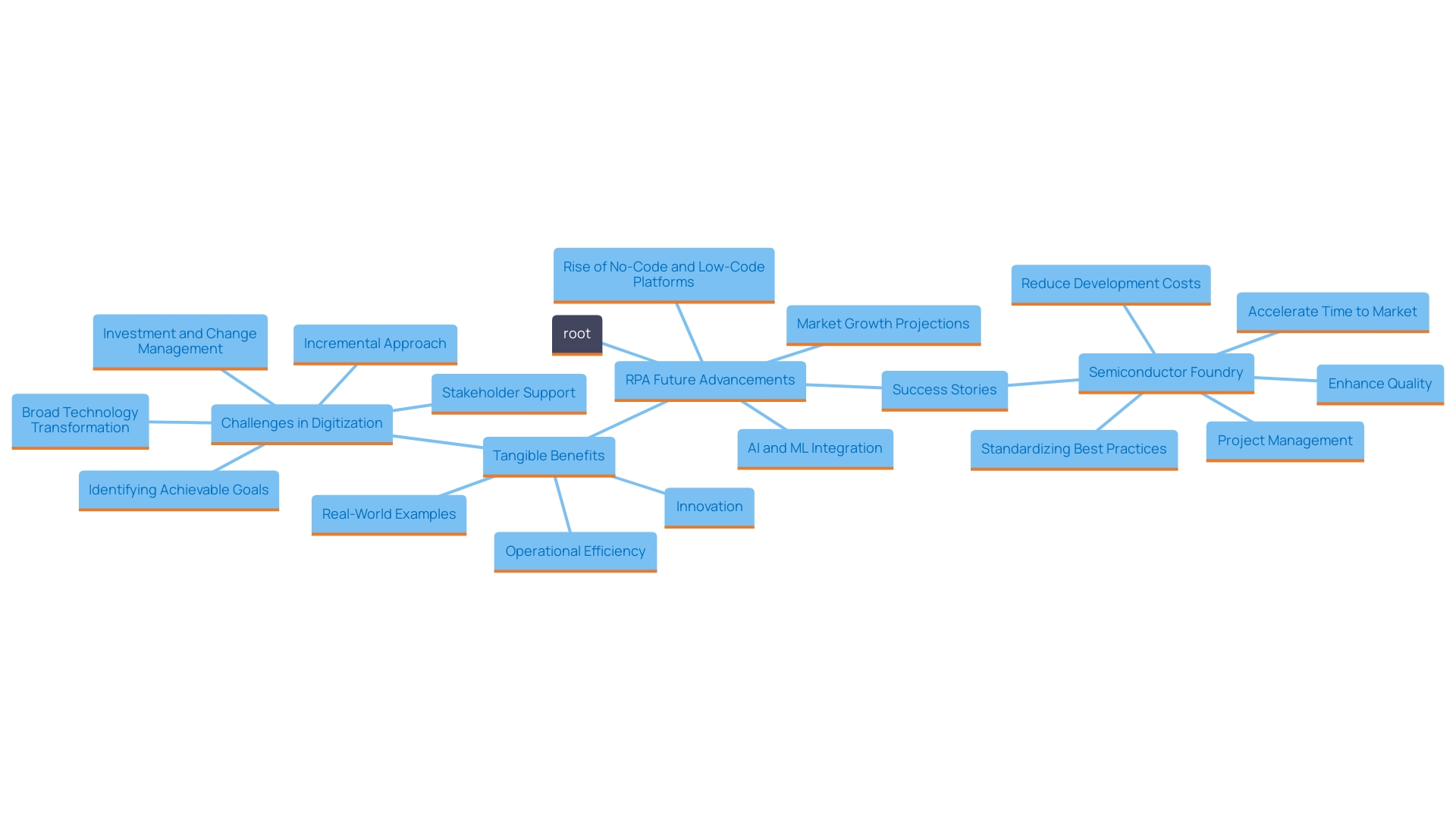
Conclusion
Embracing Robotic Process Automation (RPA) represents a pivotal shift in how organizations approach efficiency and productivity. By automating repetitive, rules-based tasks, RPA not only alleviates the burden on human employees but also significantly enhances accuracy and processing speeds. Real-world examples, such as the healthcare company’s impressive improvements in operational efficiency, highlight the tangible benefits that RPA can deliver.
Organizations that invest in RPA are likely to see reductions in operational costs, increased ROI, and a more engaged workforce.
However, the journey to successful RPA implementation is not without its challenges. Addressing employee concerns, refining existing processes, and ensuring comprehensive training are vital steps that can facilitate a smoother transition. As companies navigate these hurdles, it is essential to view RPA as a means to augment human capabilities rather than merely a tool for replacing jobs.
By fostering a culture of innovation, organizations can empower their teams to focus on strategic initiatives that drive growth and improve overall performance.
Looking ahead, the integration of RPA with artificial intelligence and machine learning will define the future of business automation. This synergy will unlock new potentials, enabling organizations to tackle complex challenges and streamline operations further. As the market for RPA continues to expand, those who proactively adopt these technologies will find themselves at a competitive advantage, ready to thrive in an evolving landscape.
By committing to this transformative journey, businesses can not only enhance their operational efficiency but also cultivate a resilient, innovative environment that prioritizes continuous improvement.
Introduction
In the evolving landscape of business operations, Robotic Process Automation (RPA) emerges as a transformative force, reshaping how organizations tackle repetitive tasks and streamline workflows. By deploying intelligent software bots, companies can not only reduce operational costs but also enhance accuracy and efficiency across various sectors, from finance to healthcare. As the trend toward automation accelerates, understanding the intricacies of implementing RPA becomes crucial for leaders looking to harness its full potential.
This article delves into the essential steps for integrating RPA using Python and Selenium, outlines best practices for successful implementation, and addresses common challenges organizations may face along the way. With a strategic approach, RPA can serve as a catalyst for innovation and productivity, positioning businesses for sustained success in an increasingly automated world.
Introduction to Robotic Process Automation (RPA)
Robotic Process Automation (RPA) is a revolutionary technology that allows organizations to automate tedious and repetitive tasks through the deployment of software robots. These clever bots are designed to replicate human actions, effectively managing tasks such as entry, transaction processing, and record management. By embracing RPA, businesses can achieve substantial reductions in operational costs, drastically decrease error rates, and allocate human resources to more strategic and value-added initiatives.
Particularly in sectors like finance and healthcare, where the volume of routine tasks is significant, RPA serves as a game changer. For instance, a mid-sized company enhanced efficiency by automating information entry, software testing, and legacy system integration using GUI automation. This implementation reduced data entry errors by 70%, accelerated testing processes by 50%, and improved workflow efficiency by 80%, achieving ROI within six months. Additionally, RPA has proven beneficial in industries such as retail, where it streamlines inventory management and order processing, and in telecommunications, where it automates customer service inquiries and billing processes.
As we approach 2024, current statistics show a growing trend in RPA adoption, with recent reports indicating that 45% of entities are planning to implement RPA solutions within the next year. This growing acceptance highlights that companies recognize the importance of leveraging this technology not only to enhance productivity but also to remain competitive in an increasingly automated world. The continuous evolution of RPA capabilities suggests that the benefits will only multiply, making it essential for leaders to understand and implement this technology within their operational frameworks.
With RPA’s potential unfolding, it is imperative to establish guiding principles that ensure its advantages are maximized while minimizing any associated downsides. Organizations should develop clear governance frameworks that define roles and responsibilities, establish metrics for success, and ensure compliance with industry regulations. By doing so, entities can harness RPA not just as a tool for efficiency, but as a strategic partner in their growth journey.
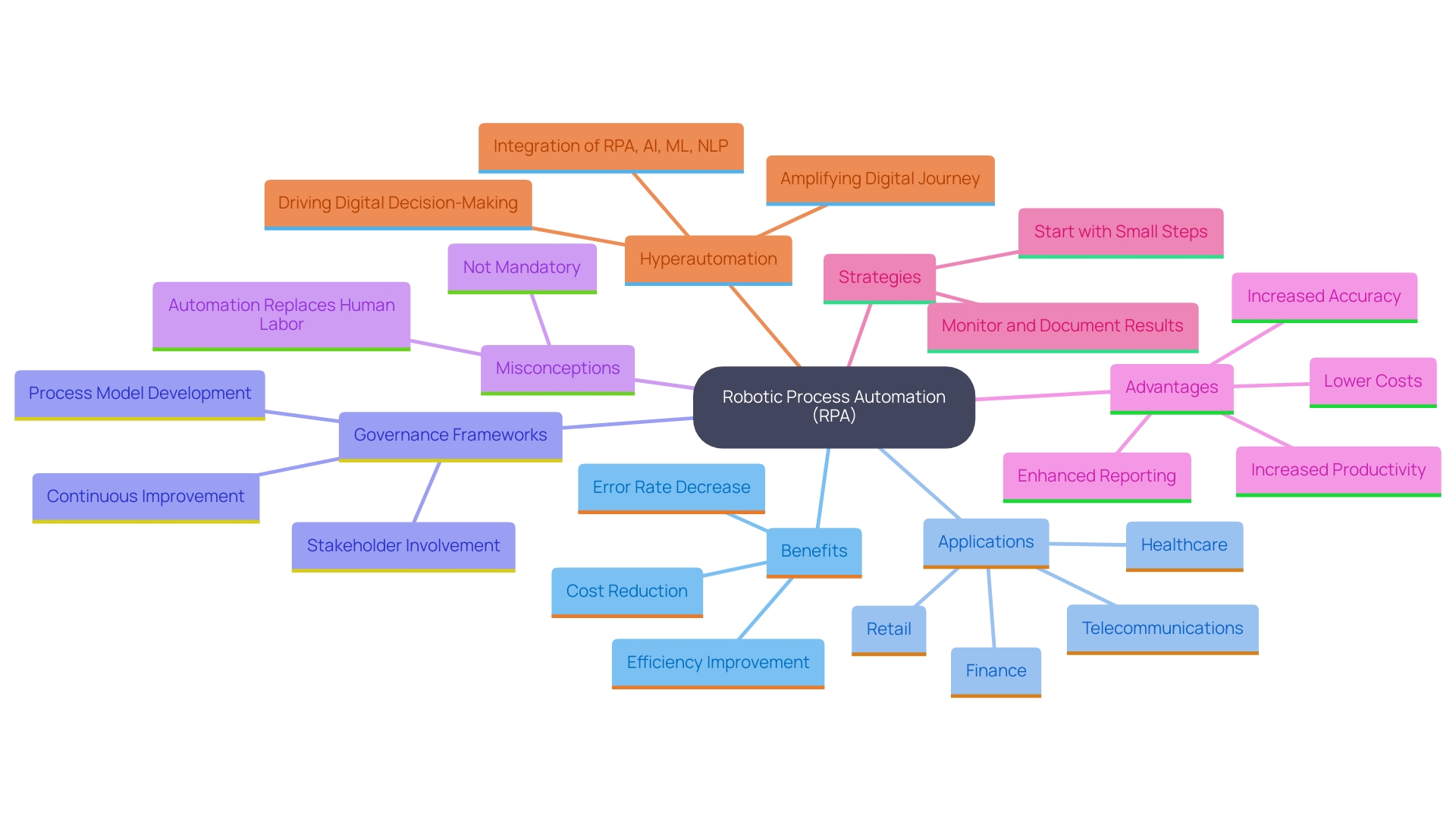
Step-by-Step Guide to Implementing RPA with Python and Selenium
To successfully implement RPA using Python and Selenium and address key workplace challenges such as repetitive tasks, staffing shortages, and outdated systems, follow these essential steps:
-
Install Python and Selenium: Start by downloading Python from the official website. After installation, utilize pip to install the Selenium package by executing the command
pip install seleniumin your command prompt. -
Download a Web Driver: Selenium requires a web driver to communicate with your browser. If you are using Chrome, download the ChromeDriver that corresponds with your browser version from the official site.
-
Set Up Your Project: Create a new Python project in your preferred integrated development environment (IDE), such as PyCharm or VS Code. Ensure to add the necessary libraries, beginning with importing the Selenium package in your Python script.
-
Write Your Script: Begin by importing the needed modules:
python
from selenium import webdriver
from selenium.webdriver.common.by import By
Next, initialize the web driver:
python
driver = webdriver.Chrome(executable_path='path/to/chromedriver')
Be sure to replace'path/to/chromedriver'with the actual path to the ChromeDriver on your system. -
Automate a Simple Task: To illustrate automation, consider a login process:
python
driver.get('http://example.com/login')
driver.find_element(By.ID, 'username').send_keys('your_username')
driver.find_element(By.ID, 'password').send_keys('your_password')
driver.find_element(By.ID, 'login-button').click()
This script directs the browser to your login page, inputs your credentials, and activates the login button. -
Run Your Script: Save your script and execute it. Watch as the browser performs the programmed actions! If all goes well, you’ve successfully completed your first RPA task using Python and Selenium, enhancing operational efficiency and freeing your team for more strategic work.
-
Expand and Optimize: As you gain familiarity, delve into more advanced features of Selenium, like handling alerts or navigating across multiple pages. It’s also beneficial to incorporate error handling, which enhances the robustness of your scripts.
Statistics and Trends
According to recent data, the usage of Python and Selenium for RPA has been steadily increasing, with a projected growth rate of 25% in 2024, as organizations recognize the value of these tools for enhancing operational efficiency. This foundational process not only establishes your RPA capabilities but also prepares the way for more complex tasks. With the rising trend of hyper-automation, integrating RPA with AI, machine learning, and natural language processing can significantly enhance your projects. Industry experts like Shailesh Gohel emphasize the promising future of RPA, particularly as major companies invest in these technologies and as open-source RPA solutions gain traction. By implementing these steps, you can not only tackle immediate operational challenges but also position your entity for sustained productivity and innovation.
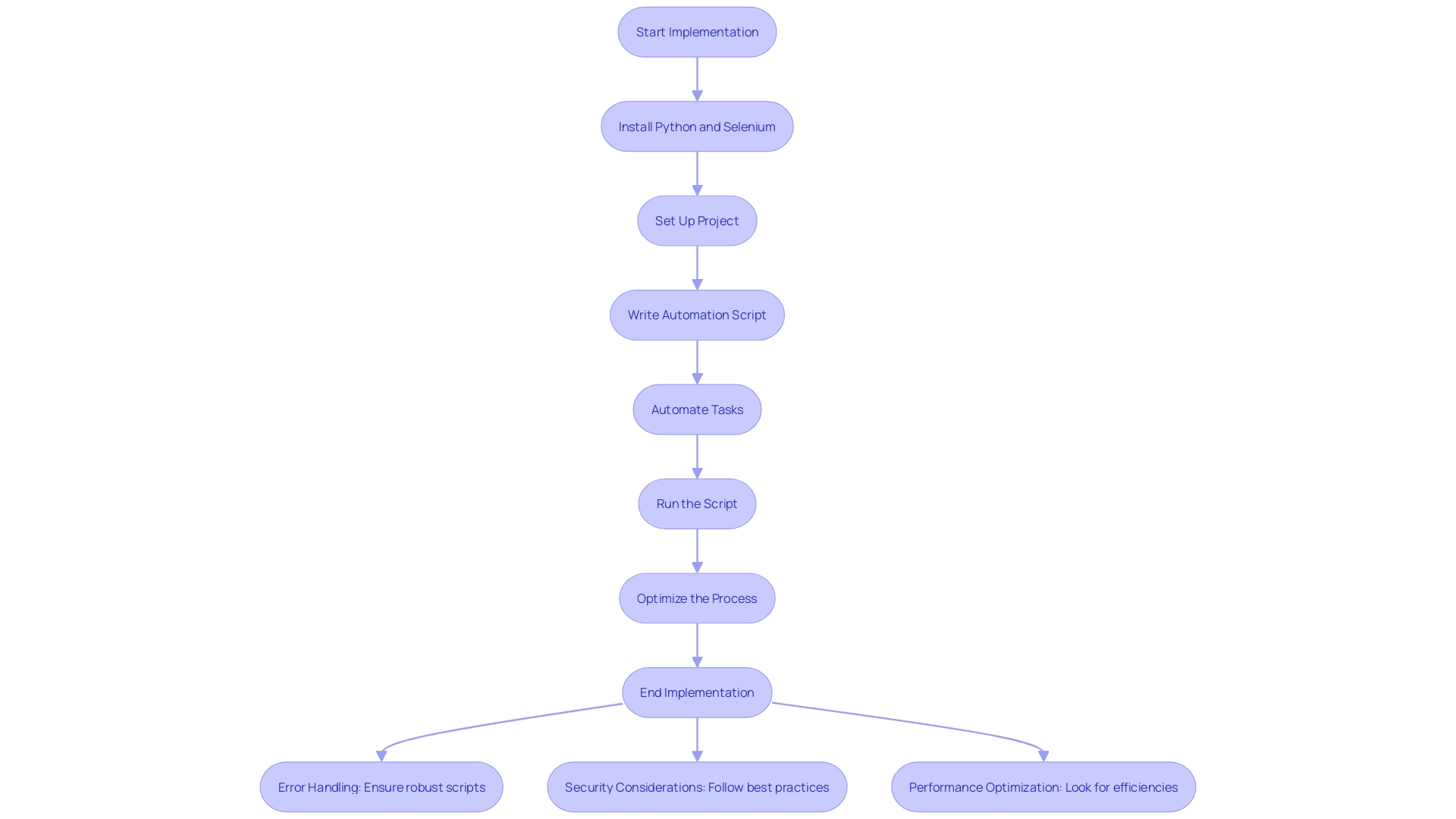
Best Practices for RPA Implementation
To achieve a successful implementation of Robotic Process Automation (RPA), it is essential to adhere to several best practices designed to streamline your efforts and maximize outcomes:
-
Identify Suitable Processes for Automation: Concentrate on tasks that are repetitive and rule-based, which require minimal human judgment. Employ process mapping techniques to visualize workflows, allowing you to pinpoint specific tasks that are prime candidates for RPA integration. This strategic method improves efficiency and creates a strong base for automated processes, allowing your entity to utilize RPA effectively in a swiftly changing AI environment.
-
Start Small: Initiate your RPA journey with a pilot project to evaluate feasibility and effectiveness within your organization. This approach allows for valuable insights and adjustments to be made before scaling up operations. By selecting a manageable scope, you mitigate risks and create a platform for success. Studies indicate that pilot RPA projects have shown an average success rate of over 70%, underscoring the strong potential for scalability and enhanced business productivity.
-
Involve Stakeholders: Early engagement of relevant stakeholders is crucial for gathering insights and securing buy-in. This collaborative method promotes a supportive atmosphere, ensuring that concerns are addressed and that there is a shared vision for the initiative, which is essential for overcoming technology implementation challenges.
-
Monitor and Optimize: Post-implementation, continuously monitor the performance of your RPA solutions. Utilizing analytics tools enables you to measure efficiency gains and identify areas for further improvement. This ongoing evaluation is vital for maximizing the value of your automation efforts and ensuring that tailored AI solutions effectively contribute to informed decision-making.
-
Invest in Training: Providing your team with comprehensive training on RPA tools and best practices is critical. This investment enhances their capability to manage and troubleshoot automated processes, ensuring that the transition to RPA is smooth and that the potential of the technology is fully realized.
Moreover, as you explore RPA, it is imperative to address security and compliance concerns, especially given the sensitive nature of the information involved. To mitigate risks, integrate robust information security mechanisms into your RPA framework from the outset. This proactive strategy will safeguard against potential breaches, protecting both your organization’s reputation and financial standing. For instance, implementing encryption protocols and access controls can significantly enhance data security.
Drawing from successful case studies, such as those in marketing technology, RPA has proven transformative across various industries, including insurance. Companies have utilized RPA for market analysis and segmentation, leading to a 30% increase in outreach effectiveness. By adopting these best practices and leveraging industry insights, you can ensure a successful RPA implementation that not only meets compliance standards but also drives significant operational improvements.
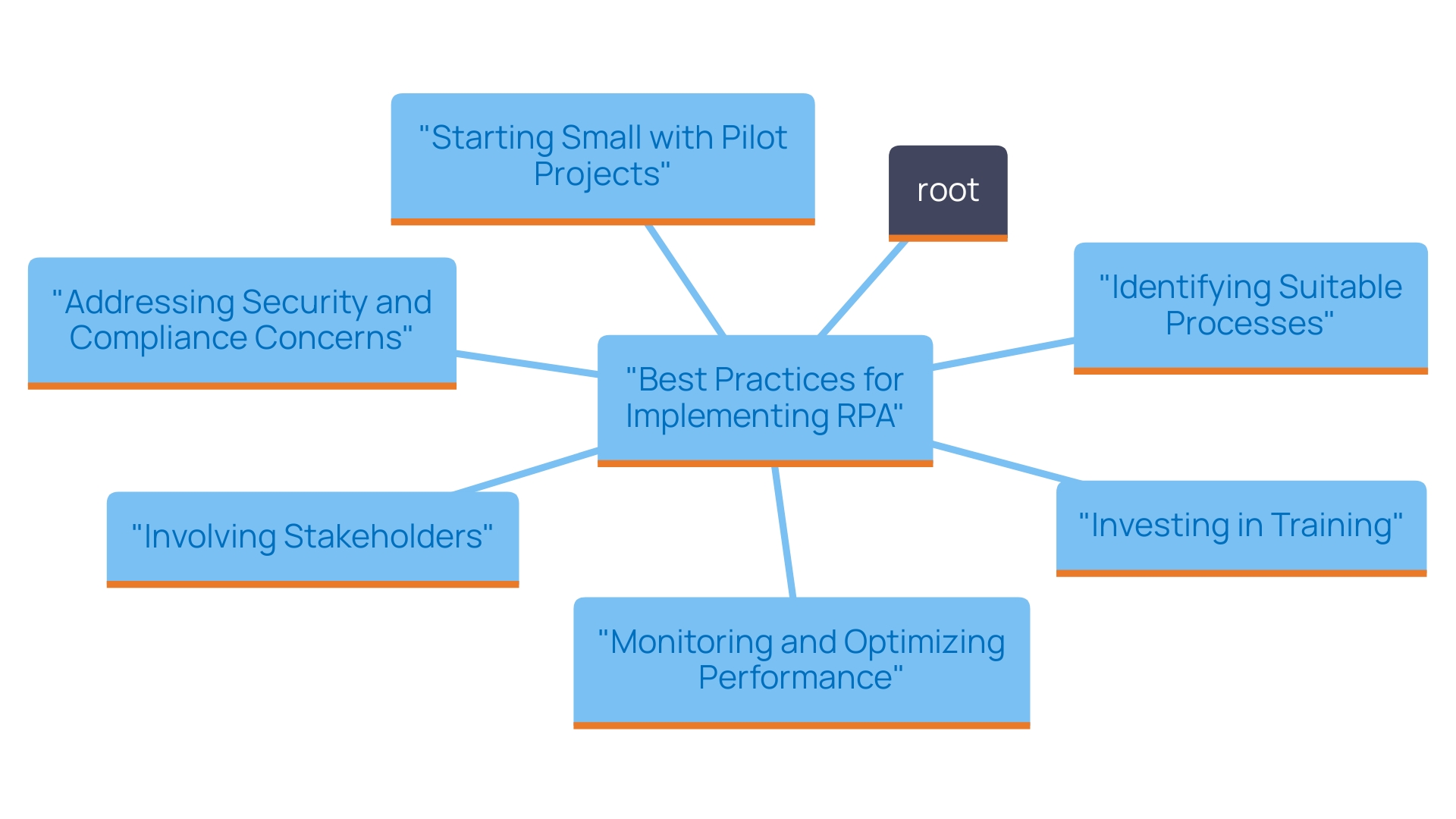
Addressing Common Challenges in RPA Implementation
Implementing Robotic Process Automation (RPA) can present various challenges, but understanding these obstacles and strategically addressing them can pave the way for successful deployment. Here are some common issues and actionable solutions to consider:
-
Resistance to Change: A prevalent issue in RPA implementation is employee resistance, often stemming from fears of job displacement. According to recent studies, nearly 60% of employees express concerns about technology leading to job loss. To counteract this, it’s essential to communicate the advantages of RPA clearly. Emphasize how automation can enhance their roles by freeing them from mundane tasks, allowing them to focus on higher-value activities that require human insight and creativity.
-
Integration with Legacy Systems: Many organizations still rely on legacy systems that may pose integration hurdles with modern RPA solutions. Conduct a comprehensive assessment of your IT infrastructure to identify potential compatibility issues. Solutions such as middleware can facilitate smoother integration, enabling RPA tools to interact seamlessly with existing systems. For instance, a financial services company successfully integrated RPA with its legacy accounting software, resulting in a 30% reduction in processing time.
-
Information Quality Issues: The effectiveness of RPA is heavily dependent on the quality of the information it processes. Inconsistent or flawed information can lead to subpar outcomes. Before implementing RPA, invest in strong information purification and quality assurance processes to guarantee that your records are reliable, thereby maximizing the system’s potential. A retail chain improved its RPA results by 40% after establishing a dedicated data governance team to oversee data quality.
-
Over-automation: A common pitfall is the temptation to automate numerous processes simultaneously, which can lead to increased complexity and confusion. It’s advisable to adopt an incremental approach, starting with the most critical processes that promise significant efficiency gains. Slowly increase mechanization initiatives as the entity adjusts to the changes. For example, a healthcare provider began by automating appointment scheduling before moving on to billing and claims processing.
-
Lack of Governance: Establishing a strong governance framework is crucial for overseeing RPA initiatives. This framework should ensure compliance and effective risk management. Clearly defining roles, responsibilities, and success metrics will empower teams to navigate the complexities of RPA deployment confidently.
As enterprises advance their use of AI and automation technologies, the importance of a structured approach becomes evident. Mario Schlener from EY highlights the need for a foundation built on solid governance principles, stating,
“As enterprises advance the use of AI in their organizations, it is essential to have confidence in the data and models/solutions/systems that feed their analyses and decisions.”
Empowering employees through engagement and education, alongside robust governance, can significantly enhance the acceptance and efficacy of RPA solutions. By leveraging tailored AI solutions and Business Intelligence, organizations can make informed decisions that drive growth and innovation, ultimately overcoming challenges and enhancing productivity.
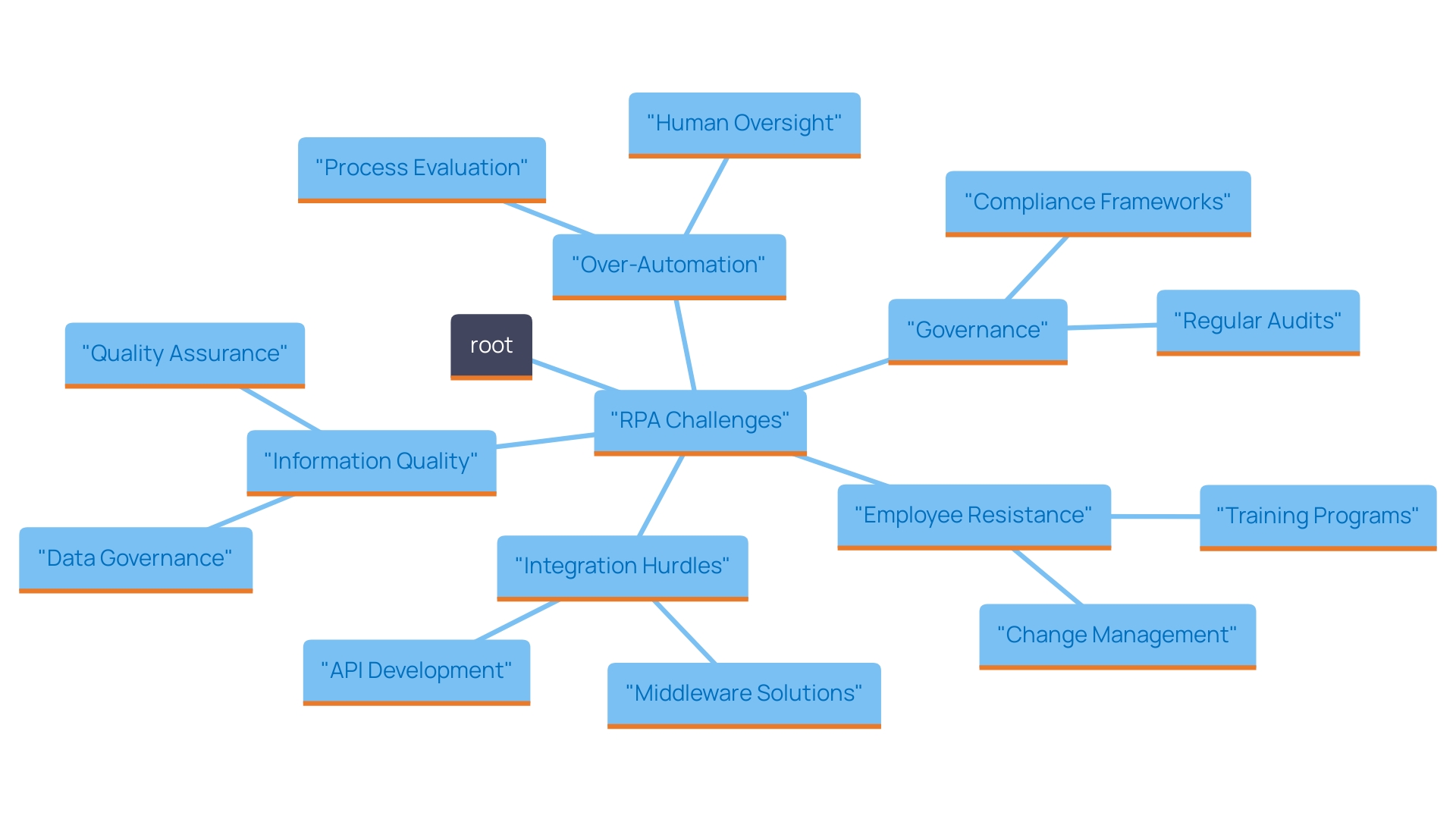
Conclusion
Robotic Process Automation (RPA) stands at the forefront of operational transformation, enabling organizations to automate repetitive tasks and streamline workflows effectively. By implementing RPA using Python and Selenium, companies can significantly enhance their productivity while reducing operational costs and error rates. The step-by-step guide provided illustrates how straightforward it is to start automating tasks, empowering teams to focus on strategic initiatives that drive value for the organization.
However, successful RPA implementation goes beyond just technical execution. It requires a strategic approach that includes identifying suitable processes for automation, starting with pilot projects, involving stakeholders, and continuously monitoring performance. By adhering to these best practices, organizations can maximize the benefits of RPA while addressing common challenges such as resistance to change and integration with legacy systems.
In an increasingly automated world, the potential of RPA is vast and still unfolding. Leaders who invest in understanding and deploying RPA technologies will not only improve their operational efficiency but also position their organizations for future growth and innovation. Embracing this transformative technology is not just about current efficiency gains; it is about laying the groundwork for a more agile and competitive business landscape.
Now is the time to leverage RPA as a strategic partner in the journey toward operational excellence.
Introduction
In a world where operational efficiency is paramount, the integration of automation and artificial intelligence is reshaping the business landscape. As companies strive to enhance productivity and streamline processes, understanding the nuances of these technologies becomes essential. From reducing manual tasks to harnessing the power of data, automation and AI present a unique opportunity for organizations to not only improve their operations but also to foster innovation.
However, the journey towards embracing these advancements is not without its challenges, including concerns over data quality and the complexities of implementation. By exploring the evolution, applications, and impacts of these technologies, businesses can uncover practical strategies to navigate this transformative era and unlock their full potential.
Defining Automation and Artificial Intelligence
Automation is described as the system that carries out activities with minimal human involvement, intended to improve efficiency and decrease the need for manual intervention. It encompasses a wide range of tools and systems, from simple mechanical devices to advanced software solutions that streamline processes. In contrast, Artificial Intelligence (AI) represents a specialized branch of computer science focused on developing systems capable of executing tasks that typically require human intelligence, such as problem-solving, natural language comprehension, and pattern recognition.
Recent statistics indicate that by 2024, approximately 75% of organizations are expected to embrace automated technologies, underscoring a significant shift towards operational efficiency. However, many organizations encounter challenges related to poor master data quality and may hesitate to adopt AI due to perceived complexities and high costs. These concerns are common, as many view AI projects as time-intensive and difficult to implement. Addressing these perceptions is essential for unlocking the full potential of AI.
Integrating Small Language Models (SLMs) can help businesses achieve efficient data analysis, enhanced privacy through on-premises deployment, and cost-effectiveness due to lower computational power requirements. Together, automation and AI create a powerful synergy that significantly enhances operational processes. By enabling machines to perform tasks and make informed decisions based on data analysis, organizations can improve efficiency and foster innovation in their operations.
As Claude Shannon, a renowned mathematician and computer scientist, aptly stated, ‘I visualize a time when we will be to robots what dogs are to humans, and I am rooting for the machines.’ This perspective invites us to reimagine the evolving dynamics between humans and AI, encouraging a collaborative future where technology empowers us to achieve greater operational excellence. Ultimately, technology and AI can convert raw data into actionable insights, driving informed decisions that propel businesses forward.

The Evolution of Automation and AI
The process of mechanization began during the Industrial Revolution, marked by the introduction of machines designed to perform repetitive tasks, significantly enhancing productivity. As technology progressed, automated processes evolved into more sophisticated systems that incorporated electronics and software, allowing for the execution of complex functions. The roots of artificial intelligence (AI) can be traced back to the mid-20th century, with early research primarily aimed at mimicking human cognitive functions.
Key advancements in machine learning, neural networks, and natural language processing have transformed AI into an essential element of modern operational strategies. These innovations enable businesses to harness and analyze data in unprecedented ways, driving efficiency and effectiveness across operations.
A compelling case study demonstrates how a mid-sized company significantly improved operational efficiency by implementing GUI tools to streamline data entry, enhance software testing, and integrate legacy systems. This initiative not only reduced data entry errors by 70% and accelerated testing processes by 50%, but also improved overall workflow efficiency by 80%. Notably, the ROI from this automation initiative was achieved within just six months, showcasing the transformative power of automation in healthcare service delivery.
Looking towards the future, the potential impact of AI is staggering. It is projected that AI will contribute to a 14% boost in global GDP by 2030, underscoring its importance in promoting productivity and innovation. According to research expert Bergur Thormundsson, the AI sector was valued at approximately 200 billion U.S. dollars in 2023, with expectations to exceed 1.8 trillion U.S. dollars by 2030. Furthermore, a case study exploring the expected impact of AI on various sectors—including healthcare, education, and transportation—highlights its vast potential, signifying a transformative era for enterprises eager to embrace these technologies.
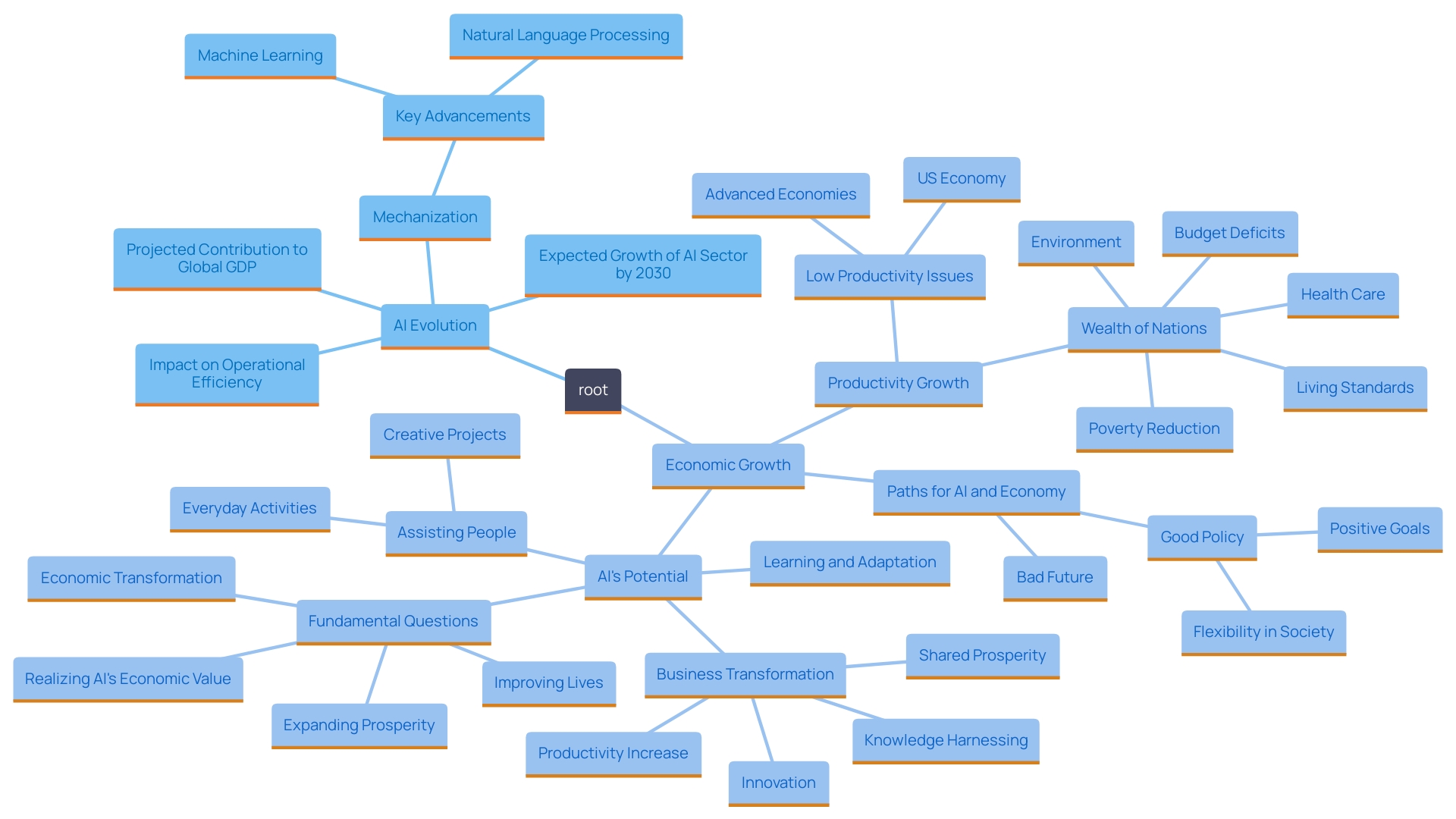
Applications of Automation and AI in Business
Automation and AI are revolutionizing business processes across various sectors, driving efficiency and significantly enhancing productivity. In manufacturing, robotic process technology has become essential for performing repetitive activities such as assembly and quality control. For instance, a leading automotive manufacturer implemented our EMMA RPA tool, which not only addressed these repetitive tasks but also reduced employee fatigue, thereby improving morale. This innovation allows human employees to concentrate on more intricate and strategic tasks, aiding a smooth shift from obsolete systems to intelligent processes. Significantly, the automotive sector has witnessed a concentration of these innovations, streamlining operations and boosting overall output.
Transitioning to customer service, AI-powered chatbots have emerged as vital tools for providing instant support. A prominent retail company reported a 30% reduction in operational costs after deploying AI chatbots, which enhance the customer experience while contributing to efficiency. As companies increasingly utilize automation for enhanced service delivery, the significance of such innovations continues to expand.
In the healthcare sector, AI is making significant strides by utilizing predictive analytics to enhance patient outcomes through effective resource management. For example, a healthcare provider used AI to predict patient admission rates, allowing for timely interventions and optimizing care delivery, showcasing the technology’s versatility across various functions.
Furthermore, AI-driven analytics tools empower organizations to extract actionable insights from vast datasets. By harnessing these insights, organizations can make informed decisions and engage in strategic planning, positioning themselves effectively within competitive markets. A recent study found that companies using AI analytics reported a 20% increase in decision-making speed, underscoring its value.
As we enter 2024, statistics show a sustained upward trend in the adoption of automated systems and AI applications across various business sectors. This trend is defined by the increasing integration of robotic process technology in manufacturing and an expansion of AI applications in customer service, healthcare, and beyond. Recent data indicate that organizations enhancing their human capital alongside these innovations will experience the most significant improvements in productivity. Daron Acemoglu observes, ‘But at the same time, by the same token, this raises the need for mechanization.’ This highlights the significance of aligning tools with human expertise to maximize operational efficiency and drive sustained growth.
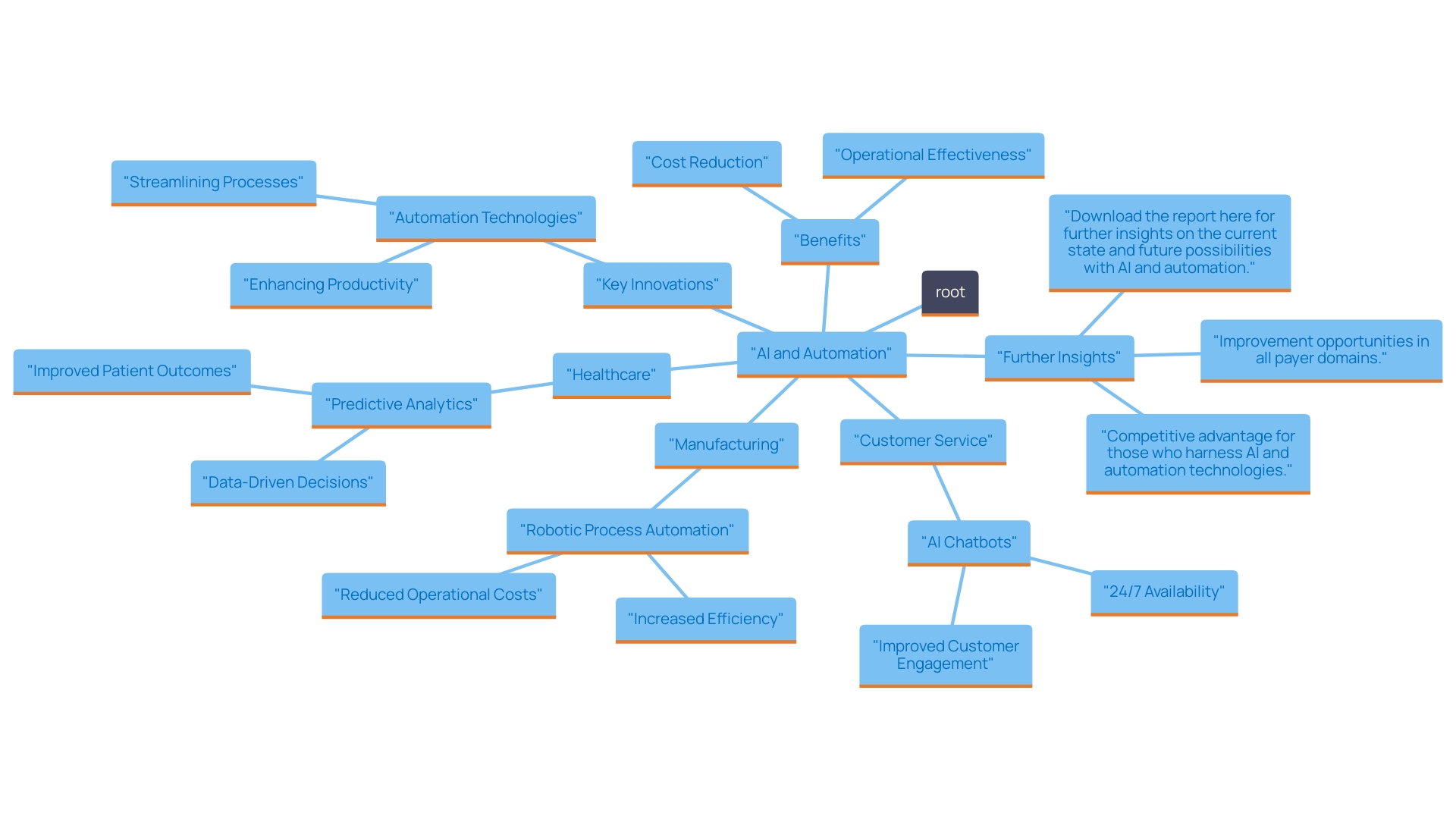
The Impact of Automation and AI on Workforce Dynamics
The integration of automation and AI into organizational processes offers profound implications for the workforce. While these innovations can result in job displacement in routine areas, they simultaneously generate opportunities for new roles that require advanced skills in managing and maintaining AI systems. Our GenAI workshops empower businesses by providing personalized customer experiences through AI-powered chatbots and recommendation systems, enhancing employee engagement and customer satisfaction. A recent study indicates that 72% of companies employing AI view it as a tool that streamlines activities and enhances responsibilities, suggesting these technologies complement human roles rather than replace them.
As employees transition to more strategic and creative tasks, organizations can experience a surge in innovation. To thrive in this evolving landscape, organizations must invest in comprehensive training and upskilling programs, such as our hands-on training workshops that equip teams with practical skills to implement AI solutions effectively, including the latest advancements like ChatGPT 4.0. ChatGPT 4.0 specifically enhances interactions by providing more nuanced and context-aware responses, making it a valuable asset in customer engagement and support.
Additionally, with the demand for childcare workers projected to increase by at least 100%, it is clear that while some jobs may be displaced, new opportunities will emerge in various sectors. This underscores the importance of continuous learning and adaptation in the face of technological change, as businesses must prepare their workforce for these shifts to ensure sustainable growth. By embracing ethical AI usage and responsible practices, organizations can navigate the complexities of technological advancements while fostering a resilient and dynamic workforce.
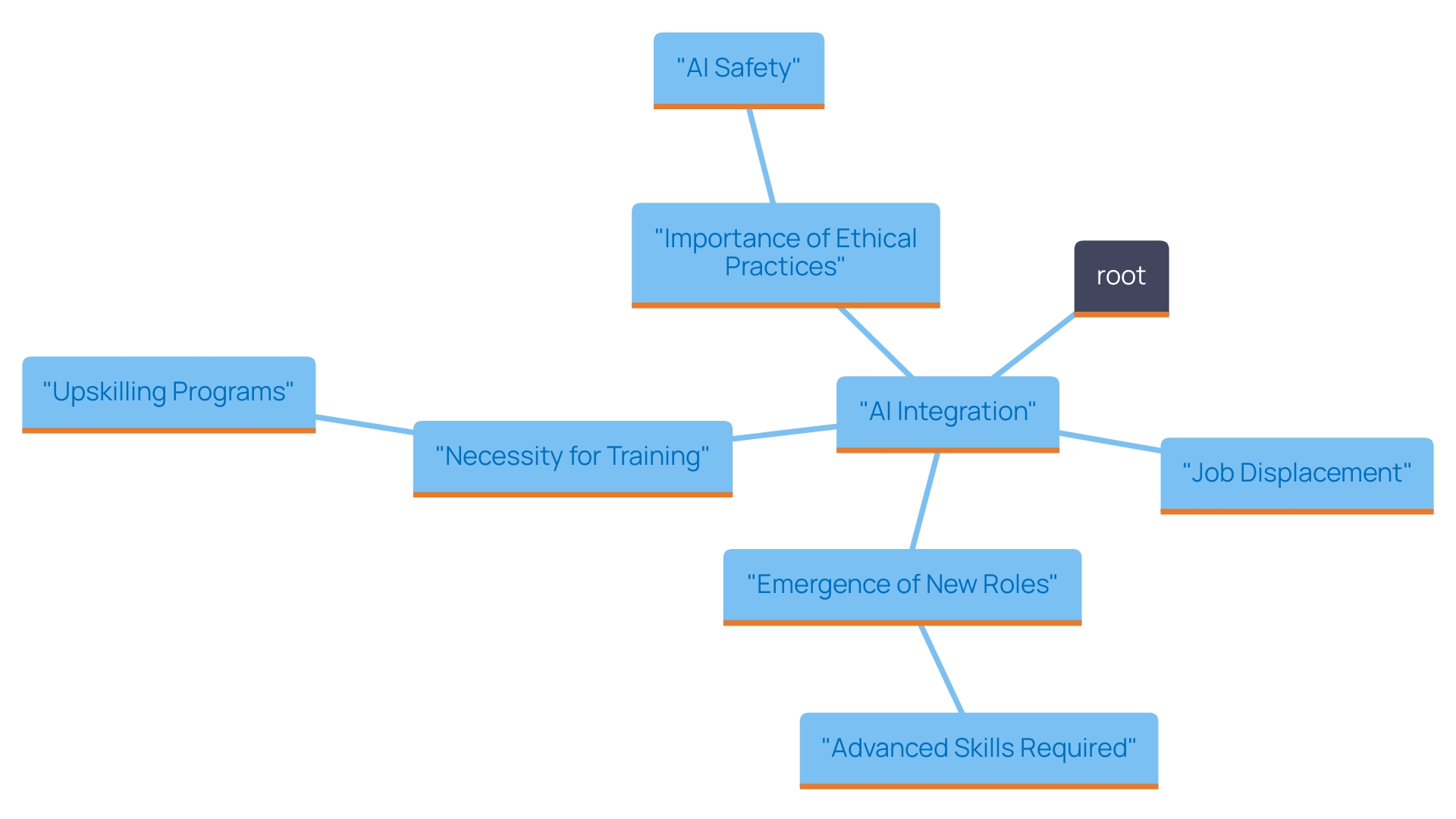
Conclusion
Embracing automation and artificial intelligence is crucial for organizations aiming to succeed in today’s competitive landscape. These technologies enhance operational efficiency and drive innovation, fundamentally transforming business processes. The evolution from early automation to advanced AI applications underscores their importance in boosting productivity.
The diverse applications of automation and AI across various sectors reveal their transformative potential. Numerous case studies demonstrate significant improvements in efficiency and cost savings, highlighting the benefits of integrating human expertise with advanced systems.
However, the integration of these technologies also presents challenges, particularly in workforce dynamics. While some roles may be displaced, new opportunities requiring advanced skills will arise. To navigate these changes, organizations must invest in training and upskilling, equipping employees to thrive in an evolving environment.
Fostering a culture of continuous learning and ethical technology use will be essential for successful adaptation.
In summary, the journey toward automation and AI is a pathway to operational excellence and innovation. By addressing challenges and harnessing these technologies’ full potential, businesses can drive sustained growth and success. Now is the time to seize the opportunities that automation and AI offer and take decisive action toward a more efficient future.
Introduction
In today’s fast-paced business environment, the ability to manage and process vast amounts of unstructured data efficiently is paramount. Intelligent Document Processing (IDP) emerges as a game-changer, leveraging advanced technologies like artificial intelligence (AI) and machine learning (ML) to transform the way organizations handle documents. Unlike traditional methods that rely heavily on manual labor, IDP automates the extraction, classification, and processing of information from various formats including PDFs, images, and emails.
This not only accelerates workflows but also significantly reduces errors and operational costs.
By harnessing the power of Natural Language Processing (NLP), IDP systems can comprehend the context and meaning of text within documents, making them invaluable across various sectors such as banking, healthcare, legal, insurance, and government. Whether it’s processing loan applications, managing patient records, or reviewing legal contracts, the applications of IDP are extensive and impactful. As organizations continue to embrace digital transformation, the adoption of IDP promises to drive substantial improvements in efficiency, accuracy, and productivity, ultimately enhancing overall business value.
What is Intelligent Document Processing?
Intelligent Document Processing (IDP) utilizes advanced technologies such as artificial intelligence (AI) and machine learning (ML) to automate the extraction, classification, and handling of information from unstructured files. Unlike conventional data entry techniques that rely on manual input, IDP utilizes advanced algorithms to interpret various file formats, such as PDFs, images, and emails, converting them into structured data that can be easily analyzed and utilized.
This advanced automation significantly improves workflow efficiency by automating the routing, reviewing, and approval procedures of files. IDP systems can arrange files in databases or content management systems (CMS) for streamlined storage and retrieval, ensuring swift access to essential information. Notably, Natural Language Processing (NLP) enables these systems to understand the context and meaning of the text within documents, which is particularly beneficial for industries such as banking, healthcare, legal, insurance, and government.
For instance, IDP is instrumental in handling loan applications, insurance claims, legal contracts, and medical records, reducing errors and operational costs while boosting productivity. The transformative power of IDP extends beyond efficiency. It transforms how organizations manage information, from digitizing forms and records to enriching educational resources and unlocking creative works. The broader adoption of AI and ML technologies promises a future where IDP tools become even more refined, efficient, and widely applicable, driving digital transformation and enhancing organizational value.
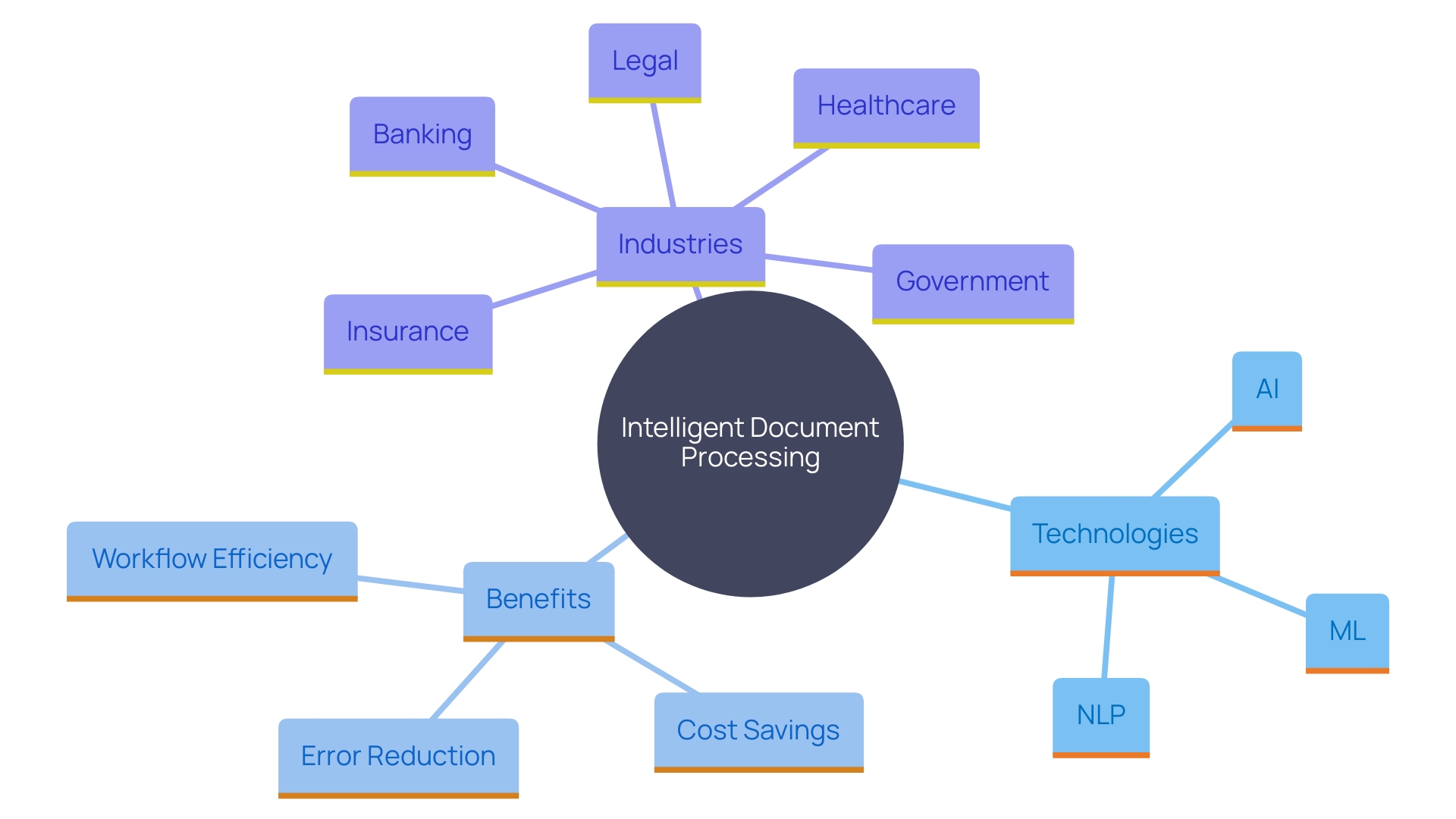
Benefits of Intelligent Document Processing
Implementing Intelligent Document Processing (IDP) offers numerous benefits to organizations. Primarily, it enhances operational efficiency by automating the extraction, classification, and management of files, thus significantly reducing the time and resources needed for manual processing. This reduces the expensive burdens on efficiency that manual information input and paperwork management usually create.
Utilizing advanced technologies like artificial intelligence (AI) and machine learning (ML), IDP reduces human error, resulting in enhanced precision in information handling. For example, in the insurance sector, IDP has changed the handling of unstructured and semi-structured documents. According to Munish Arora, Associate Director of Advanced Analytics at Sun Life, businesses strive for end-to-end process automation, which is achievable through IDP by automating the management of various data forms, ultimately enhancing client experiences.
Moreover, IDP enables organizations to achieve faster execution times, allowing quicker decision-making and responsiveness to market demands. As the volume of business paperwork continues to grow exponentially, manual processing has become slow, costly, and prone to mistakes. IDP provides a cutting-edge solution to this challenge, facilitating a more streamlined workflow.
The cost savings associated with reduced labor and improved workflows further amplify these advantages. By targeting high-impact areas such as invoices, contracts, and customer forms for automation, organizations can achieve substantial efficiency gains and cost savings. This not only boosts productivity but also creates avenues for new growth and operational effectiveness.
Key Components of Intelligent Document Processing
Intelligent Document Processing (IDP) transforms the approach organizations take to manage unstructured information by combining information capture, classification of materials, extraction of content, and automation of workflows. Data capture transforms physical files into digital formats, removing the necessity for manual data entry and greatly lowering expenses and mistakes. Classification of materials utilizes advanced AI to identify and categorize items based on their content and context, streamlining the organization of vast amounts of information.
Data extraction leverages machine learning to retrieve relevant information quickly and accurately from various documents, such as invoices, legal contracts, and emails. This automation not only speeds up information processing but also improves accuracy and decreases the chances of human error. Workflow automation effortlessly incorporates these processes into current business systems, ensuring a smooth and efficient information flow across the organization.
IDP provides a revolutionary answer for sectors spanning from finance, where it can enhance workflow procedures by condensing materials and retrieving information, to academic and historical fields, where it aids in accessing educational resources and archival content. By digitizing and automating file management, organizations can unlock the full potential of their data, driving innovation and delivering greater value.
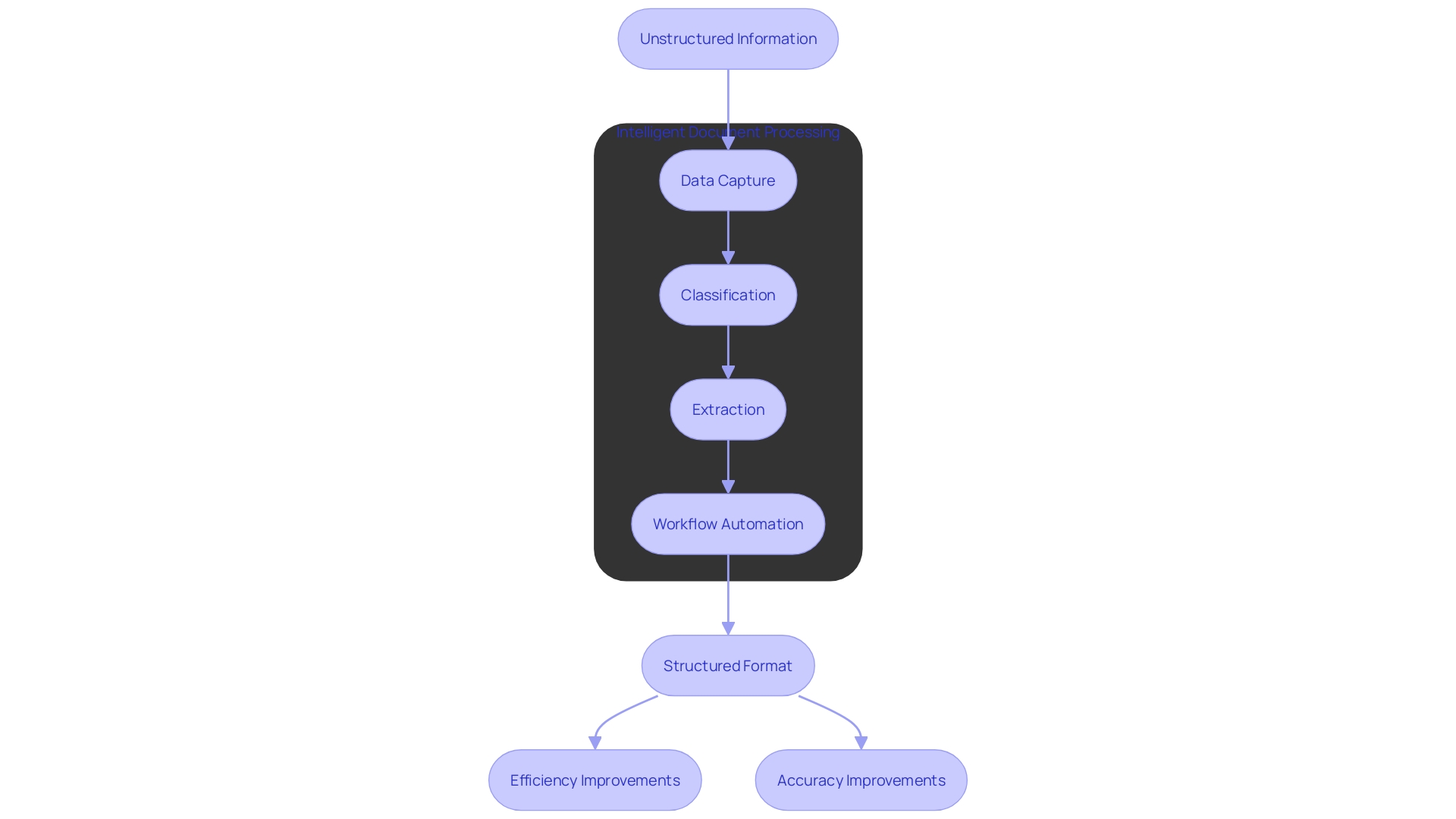
Real-World Applications of Intelligent Document Processing
Intelligent Document Processing (IDP) revolutionizes workflows across multiple industries including finance, healthcare, legal, and logistics. In finance, it automates invoice processing and compliance documentation, significantly reducing manual labor and errors. Healthcare organizations utilize IDP for efficient management of patient records and insurance claims, improving both accuracy and speed. Legal firms gain advantages from automating contract evaluations and handling case files, allowing more time for strategic activities. Logistics companies enhance their operations by streamlining shipping documentation and tracking processes, ensuring timely and accurate deliveries.
For instance, in finance, IDP can handle unstructured data from various sources, ensuring compliance with regulatory requirements, while in healthcare, it enhances the handling of extensive patient records and insurance claims, leading to faster service delivery. Legal firms utilize IDP’s Natural Language Processing (NLP) capabilities to review and manage large volumes of contracts and case files, ensuring consistency and minimizing the risk of human error. Logistics companies benefit from improved shipping documentation and tracking processes, which are critical for operational efficiency.
The future of IDP looks promising with continuous advancements in AI and machine learning. These technologies are expected to introduce more refined features and increased efficiency. As the volume of business papers increases, IDP solutions will become even more crucial, propelling digital transformation and improving productivity across various sectors.
Notably, companies like Indico Data have been recognized for their excellence in IDP, showcasing the potential of these solutions to automate critical workflows and deliver substantial business value. With a focus on improving efficiency, reducing errors, and streamlining operations, IDP is set to play a pivotal role in the digital transformation of businesses.
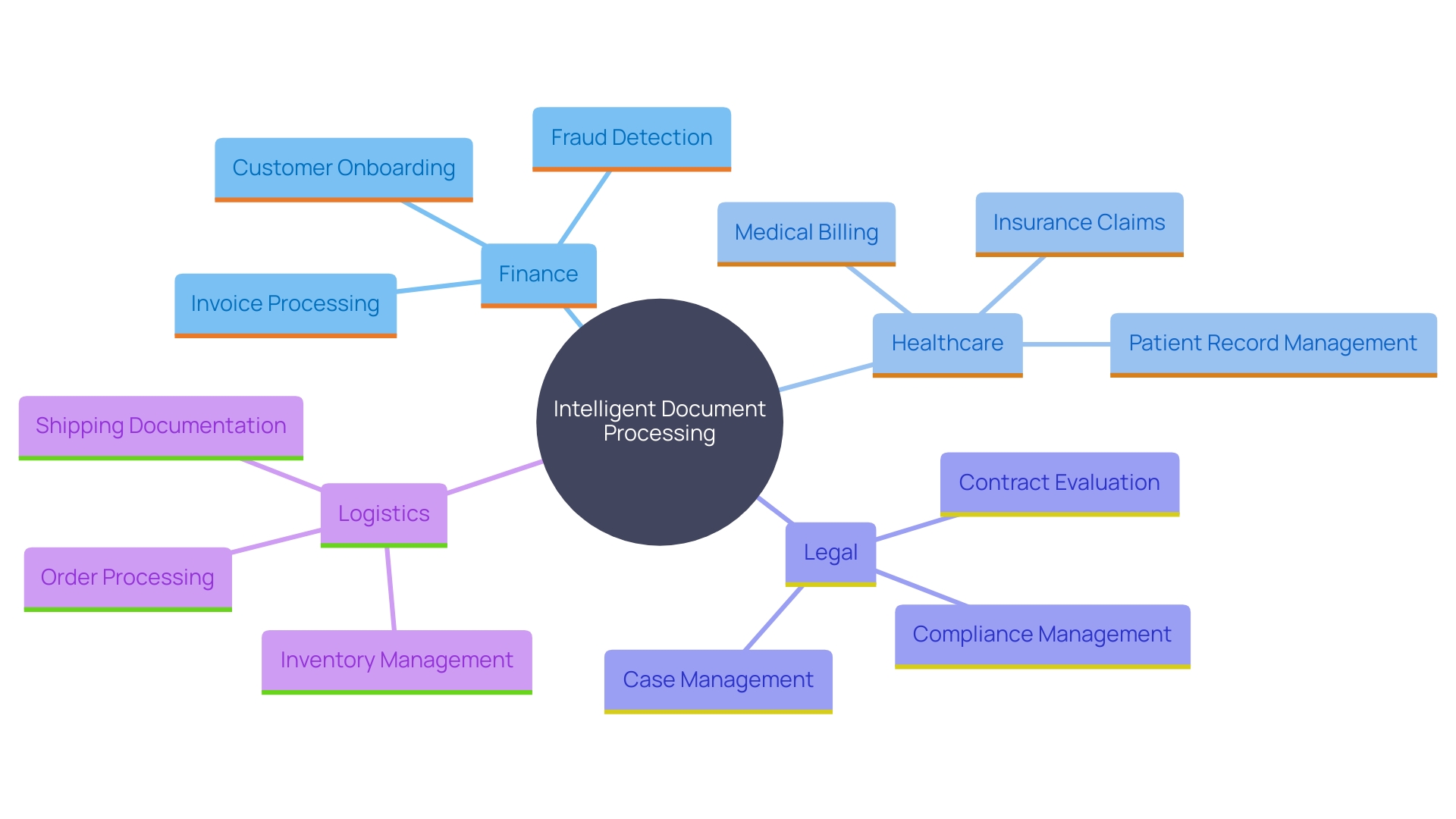
Impact on Business Efficiency and Productivity
The impact of Intelligent Document Processing (IDP) on business efficiency and productivity is transformative. By automating the management of unstructured information, organizations can significantly lessen the bottlenecks related to manual file processing. This advanced technology utilizes artificial intelligence (AI) and machine learning (ML) to automate the extraction, classification, and management of files, thus enhancing accuracy and minimizing mistakes.
IDP enables workflow automation by routing, reviewing, and approving files efficiently. This streamlined process allows employees to focus on higher-value tasks instead of tedious data entry, fostering a more agile workforce. For example, Upstage’s AI solution for texts, which utilizes optical character recognition (OCR) technology, can attain a 99% classification accuracy rate, making it highly appropriate for digitizing and comprehending both typed and handwritten materials, even in difficult formats.
The benefits of IDP extend across various industries such as banking, healthcare, legal, insurance, and government. It improves the handling of loan applications, insurance claims, legal contracts, and medical records by arranging files in databases or content management systems (CMS) for easy access and oversight. In the insurance sector, for example, IDP provides a competitive edge by increasing efficiency, accuracy, and overall operational effectiveness.
As Indico Data’s consistent leadership in the SPARK Matrix Report by Quadrant Knowledge Solutions highlights, the future of IDP is promising. The adaptability and scalability of AI and ML technologies ensure that IDP solutions will continue to evolve, offering more refined features and wider applications. This ongoing innovation is crucial for businesses aiming to drive digital transformation and enhance productivity.
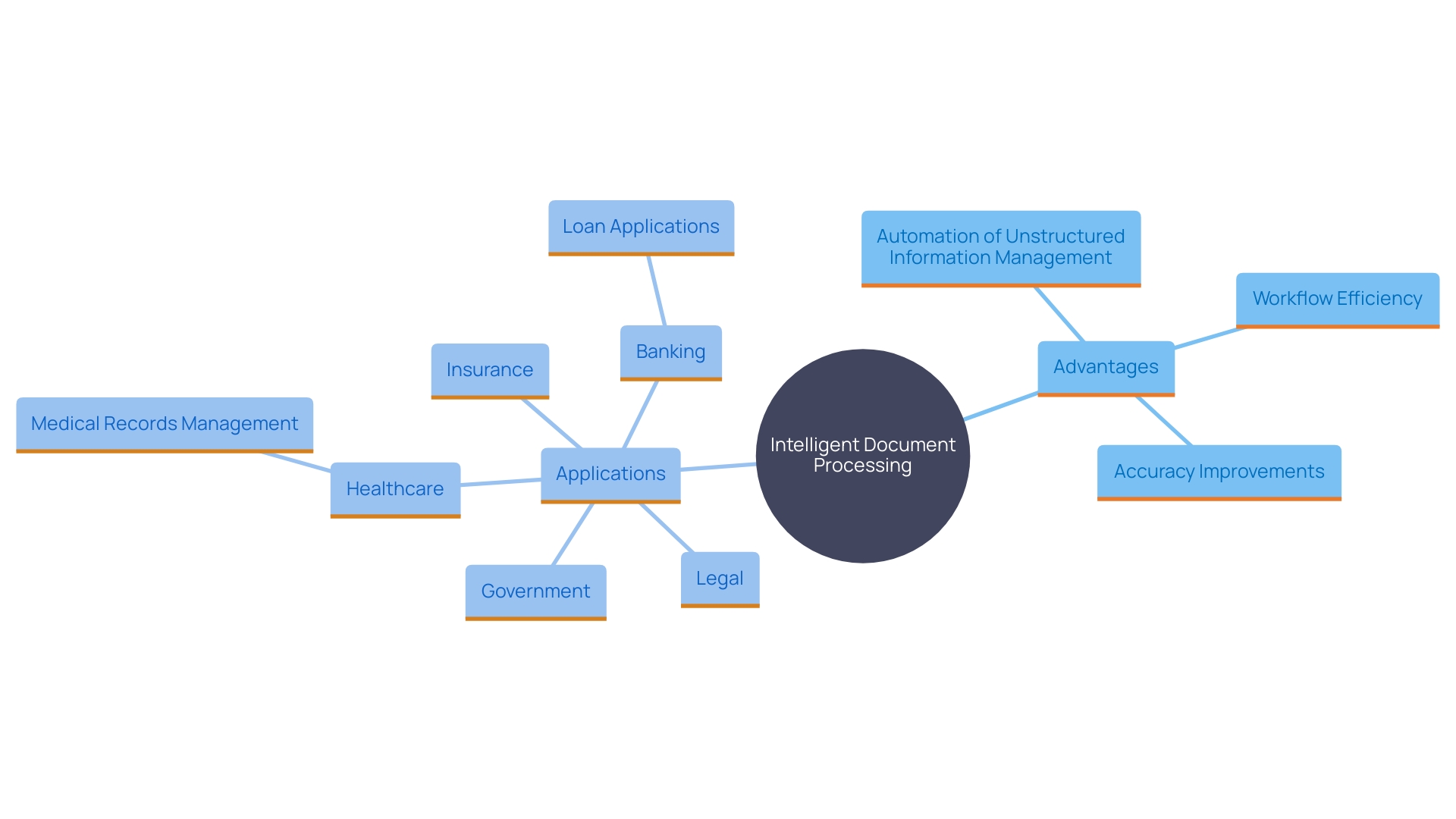
Future Trends and Predictions in Intelligent Document Processing
Looking ahead, the future of Intelligent Document Processing (IDP) is set for remarkable advancements. The incorporation of natural language capabilities is becoming more common, allowing for a deeper comprehension of contextual information within texts. This enhancement allows for more accurate data extraction and interpretation, making IDP solutions even more powerful. The rise of cloud-based IDP solutions is another significant trend, offering greater scalability and accessibility for businesses of all sizes. These cloud-based systems enable smooth handling of files across different locations, ensuring that organizations can oversee their materials effectively and economically.
As organizations continue to prioritize digital transformation, the adoption of IDP will likely expand, leading to widespread innovation and competitive advantage in management of records. For example, manual information input and paperwork handling have long been expensive and ineffective, especially for large entities that manage extensive amounts of paperwork. By automating these labor-intensive processes, IDP can significantly reduce errors, save time, and lower operational costs. This is particularly important as the amount of business documents and information continues to increase rapidly.
Moreover, the versatility of IDP technology allows it to be applied across diverse industries such as banking, healthcare, legal, insurance, and government. From processing loan applications and insurance claims to managing legal contracts and medical records, the potential applications are vast and impactful. According to recent market insights, the Artificial Intelligence (AI) market, which underpins IDP, is projected to reach a volume of US$826.70 billion by 2030, with a compound annual growth rate (CAGR) of 28.46%. This growth underscores the increasing reliance on AI-driven solutions to manage unstructured data efficiently.
In essence, the future of IDP is bright, with continuous advancements in AI and machine learning driving its evolution. As these technologies become more sophisticated, IDP solutions are expected to offer even greater efficiency, accuracy, and scope of application, transforming how organizations handle their document management processes.

Conclusion
The implementation of Intelligent Document Processing (IDP) marks a significant shift in how organizations manage unstructured data. By utilizing advanced technologies like artificial intelligence (AI) and machine learning (ML), IDP automates the extraction, classification, and processing of documents, resulting in enhanced efficiency and accuracy. This automation not only minimizes human error but also accelerates workflows, allowing organizations to respond more swiftly to market demands.
The benefits of IDP are manifold. Organizations experience substantial cost savings by reducing the need for manual labor and streamlining document handling processes. The ability to automate high-impact areas such as invoices, contracts, and customer forms further amplifies productivity, creating opportunities for growth and operational effectiveness.
As industries continue to embrace digital transformation, IDP stands out as a critical solution for improving business value and driving innovation.
Looking ahead, the future of IDP is poised for remarkable advancements. With the integration of natural language processing (NLP) capabilities and the rise of cloud-based solutions, organizations can expect even greater scalability and accessibility in their document management practices. The ongoing evolution of AI and ML technologies will ensure that IDP solutions remain effective and relevant across various sectors, empowering businesses to navigate the complexities of document management with ease and precision.
In summary, Intelligent Document Processing is not merely a trend but a fundamental shift in how organizations handle their data. By harnessing the power of IDP, businesses can achieve unprecedented levels of efficiency, accuracy, and productivity, positioning themselves for success in an increasingly data-driven world.
Introduction
In the ever-evolving landscape of the insurance industry, operational efficiency remains a paramount concern, grappling with a myriad of challenges such as manual processes, fragmented systems, and stringent regulatory requirements. These obstacles not only slow down operations but also inflate costs and increase the likelihood of errors. However, innovative solutions like technology consolidation and the integration of AI-driven processes are paving the way for significant advancements.
By streamlining underwriting, enhancing customer service through virtual assistants, and leveraging advanced analytics for data-driven decision-making, insurers can transform their operational models. This article delves into the key challenges faced by the insurance sector and explores how embracing technology and automation can drive efficiency, reduce costs, and ultimately improve customer satisfaction.
Key Challenges in Insurance Processes
The insurance industry faces numerous challenges that can hinder operational efficiency. Manual processes often lead to delays, errors, and increased workloads for employees. Fragmented systems result in poor data integration, making it difficult to access accurate information quickly. Additionally, compliance with regulatory requirements demands significant time and resources. These challenges necessitate innovative solutions to streamline operations and enhance overall efficiency.
One effective approach is consolidating existing technology portfolios, which often include diverse systems like SQL Server, Oracle, and IBM IMS. Consolidation reduces inventory and prepares insurers for the future by ensuring a robust data layer that supports scenario planning and future-proofing. For instance, integrating AI-driven underwriting processes can significantly improve the accuracy of risk assessments and premium calculations. Chatbots and virtual assistants offer round-the-clock customer assistance, simplifying processing and improving customer service experiences.
Moreover, insurers must carefully select automation tools for claims processing, considering factors like scalability, seamless integration with existing systems, and compliance with industry regulations. Precise and dependable instruments are essential for managing intricate activities such as fraud detection and approvals. These tools not only reduce operational costs but also empower employees by automating repetitive tasks, allowing them to focus on more strategic roles.
Real-world examples illustrate the importance of balancing advanced technology with human interaction. As stated in a report by Capgemini, integrating AI-enabled processes with human interactions is crucial for delivering high-quality service. This balance ensures that insurers meet the diverse needs of policyholders, underwriters, claims reps, and agents, ultimately enhancing overall operational efficiency.
Additionally, the surge in demand for data-driven decision-making is a critical market driver. Insurers utilize extensive information produced by policyholders, IoT devices, and external sources to gain deeper insights into consumer behavior and risk factors. Advanced analytics tools enable more precise underwriting, optimized pricing, and enhanced fraud detection, ultimately boosting profitability and client satisfaction.
In conclusion, addressing these challenges through technology consolidation, careful automation tool selection, and data-driven strategies can significantly enhance operational efficiency in the insurance industry. By embracing these innovative solutions, insurers can streamline their operations, reduce costs, and provide better services to their customers.
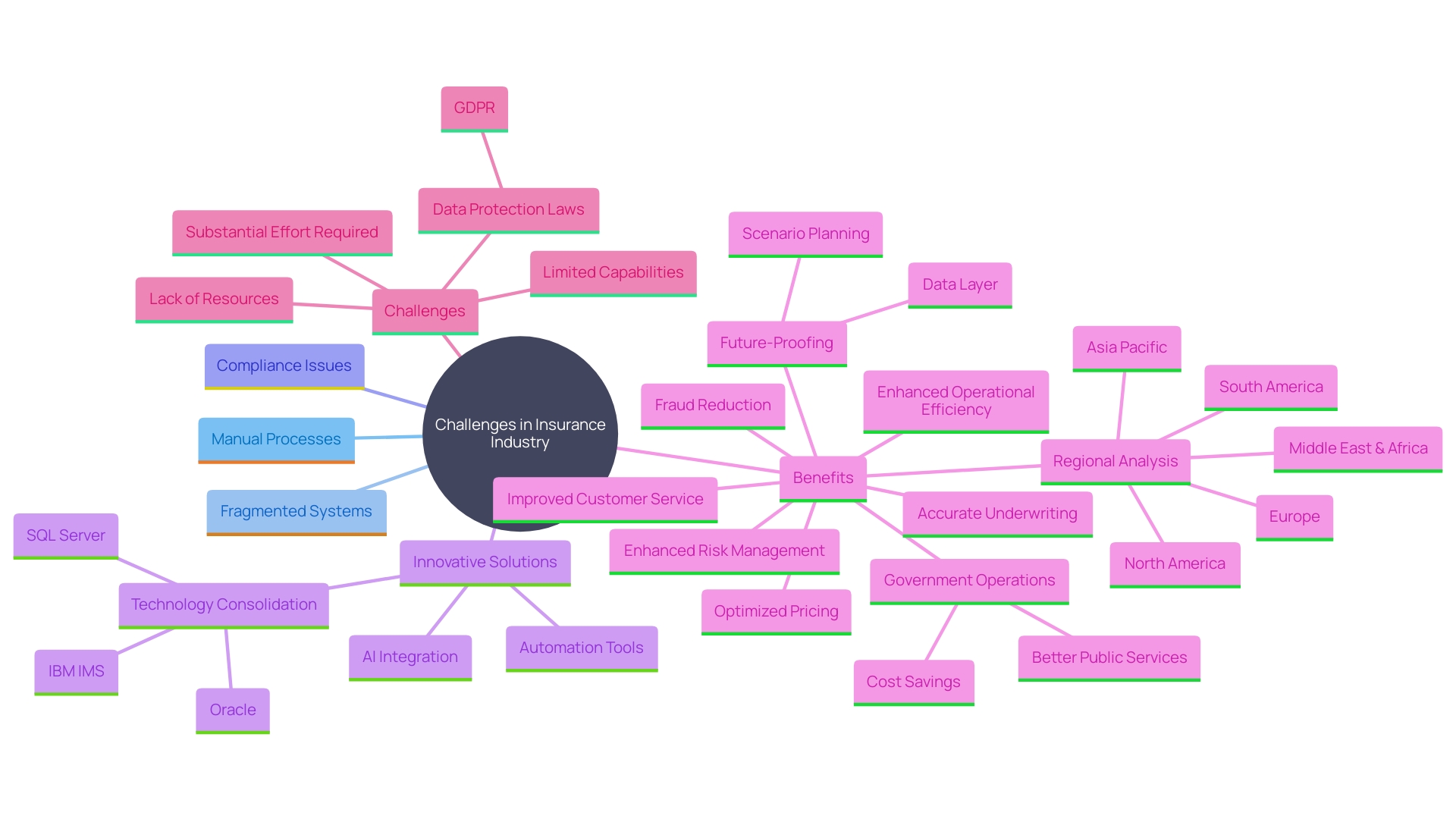
How RPA Transforms Insurance Processes
Robotic Process Automation (RPA) is transforming the insurance sector by automating repetitive and labor-intensive activities, resulting in substantial efficiency improvements. For instance, Cognizant’s collaboration with Alm. Brand Group in Denmark highlights how RPA can transform business processes previously outsourced to other vendors. By automating tasks such as data entry, validation, and policy administration, insurers can dramatically accelerate processing and policy management. This not only enhances accuracy and reduces operational risks but also allows employees to focus on more strategic activities, ultimately improving customer satisfaction.
A key aspect of implementing RPA in insurance is ensuring scalability to handle increasing volumes of claims and integrating seamlessly with existing claims management software. This integration reduces interruptions and guarantees adherence to industry regulations, which is vital for preserving the precision and dependability of intricate activities such as fraud detection and approvals. Moreover, the use of intuitive interfaces makes these tools accessible to employees without extensive technical expertise, streamlining operations further.
The benefits of RPA in insurance are evident in improved customer experiences and competitive advantages. By automating routine tasks, companies can handle more requests in a shorter period, offering a quicker and more dependable service to their clients. This transformation is essential in an industry where the loss ratio, the percentage of premiums paid out as payouts, is a critical metric for financial health. Predictive modeling and AI can further enhance these benefits by offering powerful tools to manage and reduce loss ratios, ensuring long-term profitability and stability.
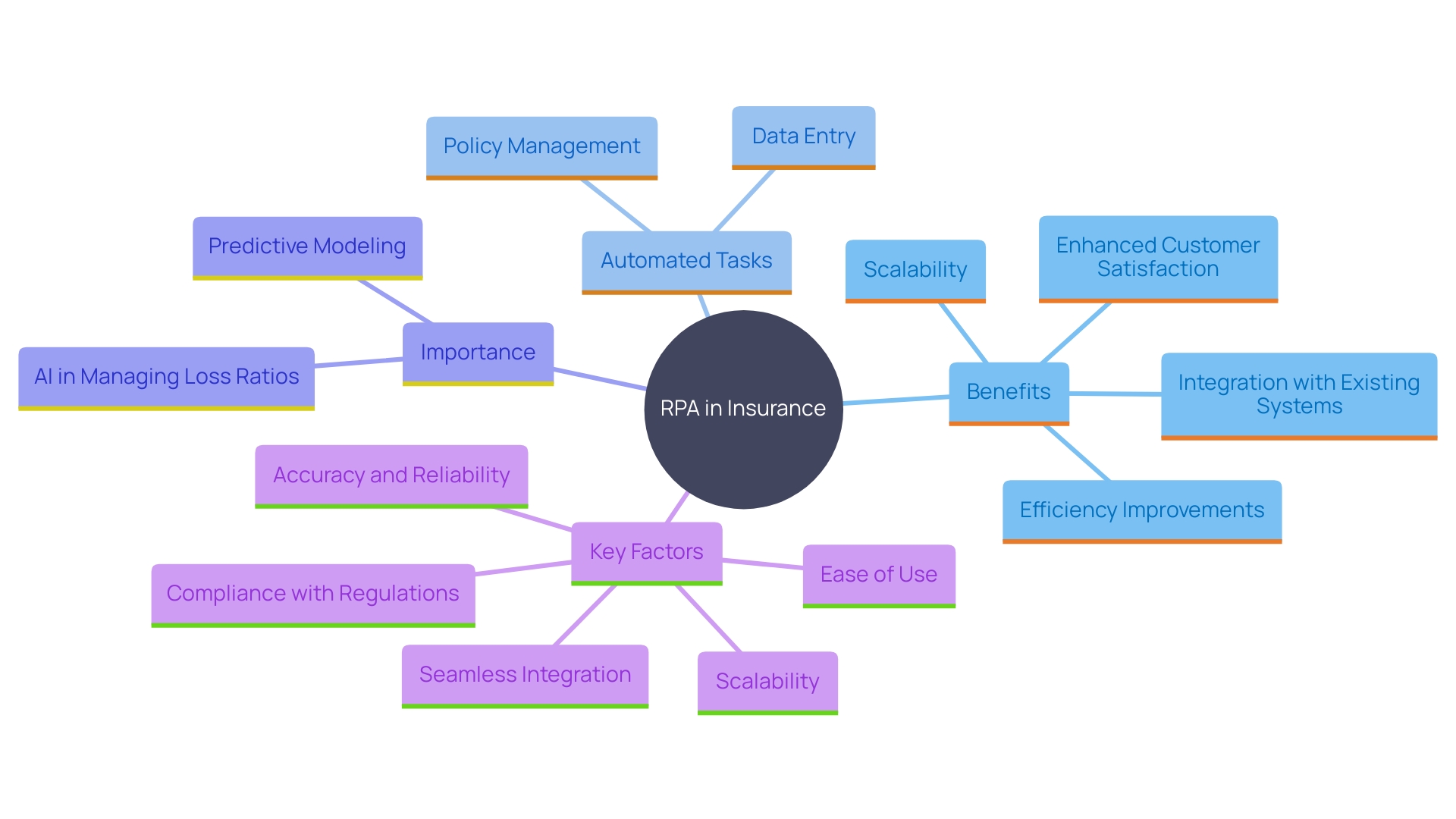
Benefits of RPA in Insurance
Implementing Robotic Process Automation (RPA) in the insurance sector offers significant advantages. It significantly speeds up request processing, shortening resolution durations and improving client satisfaction. By automating routine tasks, RPA ensures quick responses to inquiries and efficient communication, leading to better customer service. Furthermore, RPA integrates data across multiple platforms, improving accuracy and ensuring compliance with industry regulations. This not only lowers operational expenses but also enhances scalability, enabling insurers to manage increasing amounts of requests effortlessly.
Automation tools for processing requests must be scalable to accommodate increasing volumes and adaptable to future business needs. They should integrate seamlessly with existing management software to prevent disruptions during implementation. Precision and dependability are essential, particularly for intricate activities such as fraud detection and approvals. Compliance with industry regulations is essential to ensure legal adherence in claims processing. Lastly, an intuitive interface is vital for ease of use, allowing employees to operate the tools and interpret results without extensive technical expertise.
RPA’s capability to operate continuously without interruptions greatly accelerates repetitive procedures like data entry, invoice handling, and client inquiries, enabling workers to concentrate on more valuable activities. This continuous operation eliminates the need for overtime pay or temporary staff during peak seasons, leading to substantial cost savings. The high accuracy of RPA also reduces human errors in data entry and report generation, saving money and enhancing work quality. Consequently, RPA is a valuable asset for insurers, improving efficiency, reducing costs, and providing better service to customers.
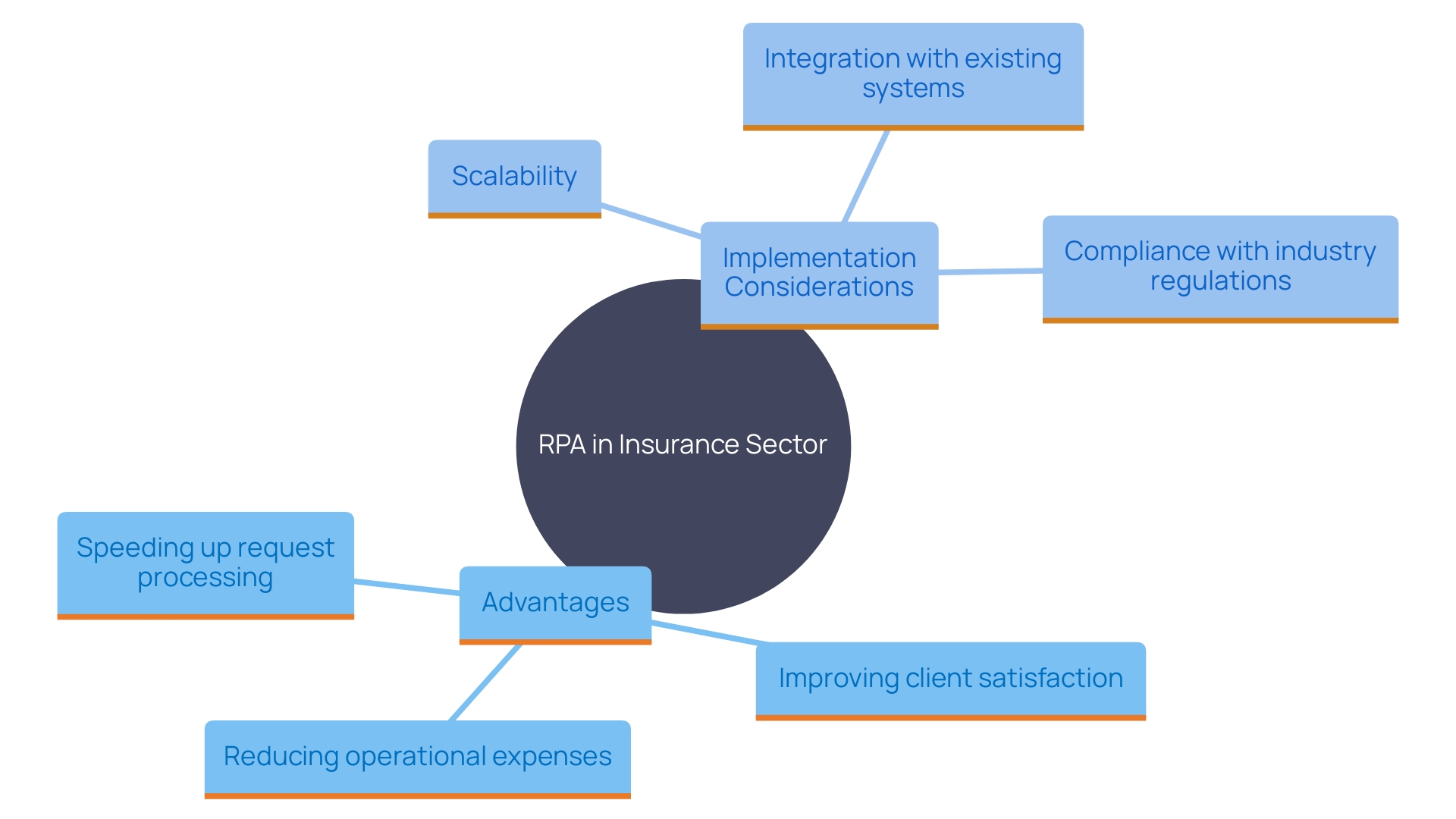
Implementation Strategies for RPA in Insurance
To successfully implement RPA in insurance, organizations should begin with a thorough assessment of their processes. This involves identifying high-volume, repetitive tasks suitable for automation, which can significantly reduce manual labor and errors. For instance, Aflac’s automation of claims review has drastically cut down the time spent on manual checks, allowing representatives to focus on final accuracy verification.
Engaging stakeholders from various departments ensures that all perspectives are considered, fostering a culture of collaboration and reducing resistance to change. This is crucial as the goal of RPA is to enhance process efficiency, better data accuracy, and lower costs, without requiring extensive programming knowledge from users.
Establishing a robust change management strategy is equally important to address employee concerns and promote a supportive environment. Continuous monitoring and optimization of RPA systems are essential for maintaining their effectiveness and adaptability. As noted, RPA combined with AI can transform processes, increase efficiency, and enable more informed decision-making, a sentiment echoed by industry leaders.
By leveraging advanced analytics and continuous oversight, insurers can harness vast data to improve risk assessment, underwriting, and fraud detection, ultimately enhancing customer experiences and profitability.
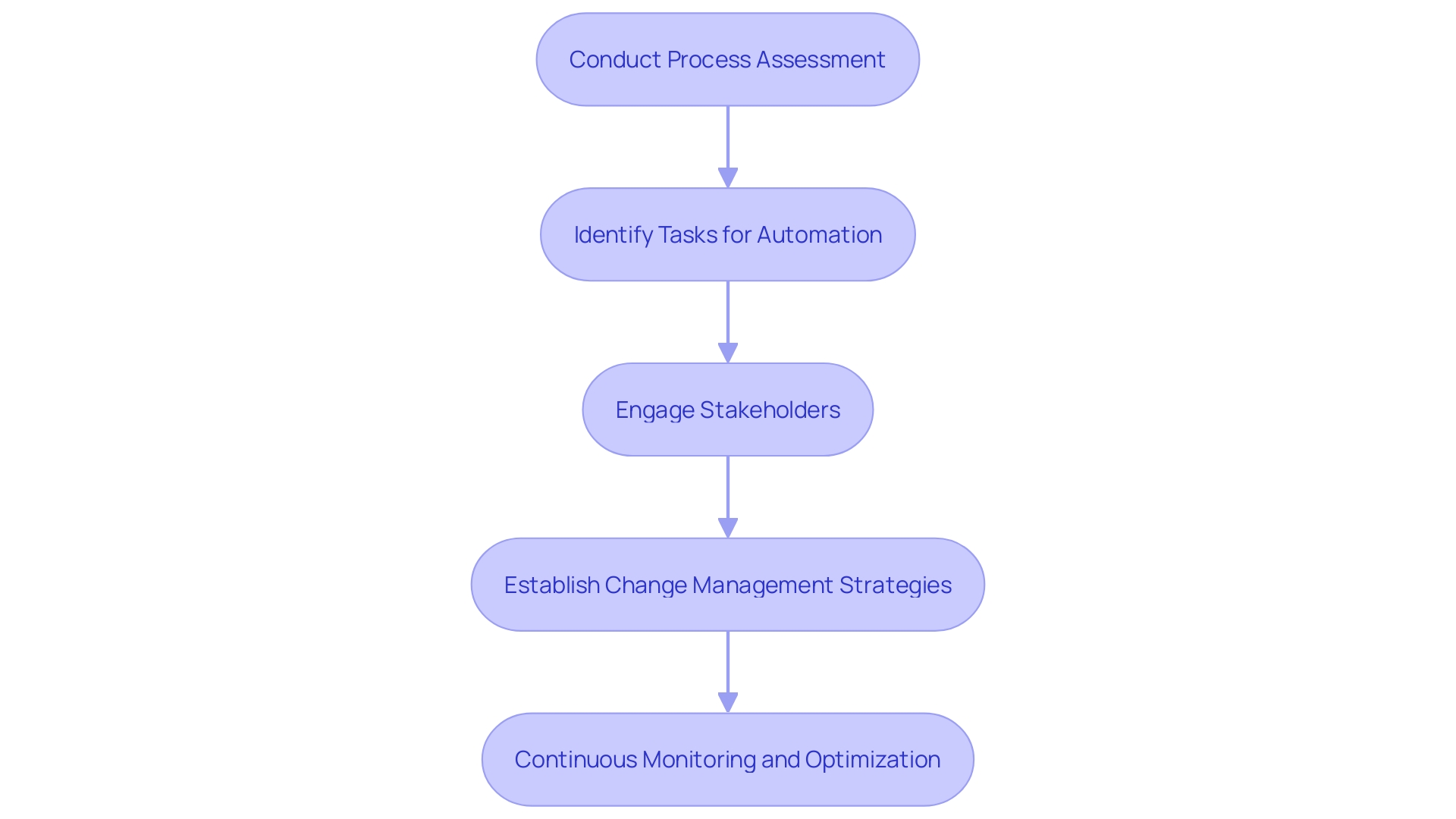
Conclusion
The insurance industry is navigating a landscape filled with significant challenges that impede operational efficiency. Manual processes, fragmented systems, and stringent regulatory requirements create barriers that can lead to delays, increased costs, and higher error rates. However, embracing technology consolidation and automation, particularly through solutions like Robotic Process Automation (RPA) and AI-driven processes, offers a pathway to overcoming these obstacles.
By integrating advanced technology, insurers can streamline underwriting processes, enhance customer service, and leverage data analytics for more informed decision-making. RPA, in particular, automates repetitive tasks, allowing employees to focus on more strategic roles, thereby improving both productivity and customer satisfaction. The collaboration between technology and human expertise is essential, ensuring that customer needs are met effectively while maintaining high operational standards.
The implementation of these innovative solutions not only reduces operational costs but also positions insurers to respond effectively to the increasing demand for efficiency and accuracy in claims processing. The ability to adapt and scale automation tools ensures that insurers can handle growing volumes of claims while remaining compliant with industry regulations. In summary, by addressing the key challenges with a focus on technology and automation, the insurance sector can transform its operational models, ultimately leading to enhanced efficiency, reduced costs, and improved customer experiences.
